#probably as an album in whole one of the top three most influential on me in hs.....
Explore tagged Tumblr posts
Text
ohhh american boyfriend: a suburban love story (2016) by kevin abstract we're really in it now......
#probably as an album in whole one of the top three most influential on me in hs.....#crazy. ty whatever random tumblr post back w the albums release mentioned it mwah
2 notes
·
View notes
Text
An interview with Mike when Warning came out that I don’t even have a source for - sorry!
Laughing Off a "Warning" With Green Day
Bassist Mike Dirnt's green thumb, punk perspective and personal dominatrix
If Mike Dirnt wasn't in one of the most enduring and influential punk bands making the scene, the Green Day bassist could easily be a hilarious stand-up comic. Instead, he's devoting his insightful social commentary laced with witty repartee to the business (and funny business) at hand -- the band's sixth studio album, Warning. While Green Day's Nimrod and (especially) Dookie humor doesn't seep through in this seemingly ominous album title, it may be because these Bay Area hooligans -- Billie Joe Armstrong (vocals, guitar), Tre Cool (drums, percussion) and Dirnt -- have accepted and submitted to certain rites of passage other than platinum-selling discs. But it's definitely not as ominous as all that. We bantered with Dirnt to gauge the barometer of Warning, life as a prankster punk and his bid for world domination as Armstrong's presidential running mate. What would you like to talk about? Probably not myself (laughs). … It gets you so self-involved and self-absorbed, [that] it makes it difficult to change your perspective for an hour or two after you're done doing interviews. It's not so much narcissistic as it is dwelling. It's like being on tour and coming back and decompressing and acclimating to your home life again, because your surroundings are all about you, you, you for so long, that you need to stop and go home and realize, 'Hey, wait a minute. Other people aren't asking for a lot. I'm probably just self-absorbed still, and being an assh*le for a while and don't realize it.' And you need to take a breath and go, 'OK, how can I focus on the smaller things in my life, like getting up in the morning and making my girlfriend coffee? Or making my daughter breakfast.' And taking the focus off yourself for awhile. I think that's important.
What's fun to talk about? I'm growing a huge pot plant in my back yard right now. My friend gave me this pot plant and I just left it in the window and left the light on it forever, and it grew and grew and grew, and got pretty big. So then I put it in my backyard just to see what would happen, and I came home and it's f*cking enormous! (Laughs) It's of the superskunk variety. It is nasty. Pretty cool. [My friend] is very proud of me. He said, 'Wow, Mike, that's beyond a plant -- that's a crime.' I smoke pot once a month. I take one hit. So I'm gonna give it all to friends.
No "jurassic monkeys" [joints] for you? Not this year.
Any special reason? Three months before my daughter was even conceived, I stopped smokin' pot and I stopped for about a year and a half, just to clean up my act. After that, it's never been the same. I haven't smoked as much pot ever since. I would hate to think that if she needed me, I was impaired by weed.
Warning seems to have been shrouded in a huge amount of secrecy and I have my theories as to why, but I'm hoping you could provide some perspective. We took a break so as not to hate what we do. We really toured the heck out of the last record [Nimrod] for about 238 shows, and we were like, 'OK, it's time to take a real break -- for once.' And instead of writing in the fashion of, 'OK, let's go in and write the next record and pound it out and pound it out' … [for] the last record we wrote about 40-some songs and then let the songs pop out and figure out what the record was from that … [this time] songs stood out on their own and we said, 'OK, this is the album' … Billie waited for inspired moments. And as a band, we practiced when it was working, and we only worked on the songs that already inspired us … instead of forcing it. We had about 14 or 15 songs, and we were like, 'We're totally ready.' And it was pretty obvious at the time which 12 songs were gonna be on the record. There's the dealio. (Laughs) … As far as the secrecy thing, we will sell no wine until its time. [But] go on Napster and check out a couple songs. (Laughs) I know they're there.
What is your point of view on Napster? I think it's gonna work itself out. Everyone keeps sayin', 'What's the deal?' I don't believe their schtick about 'Hey, we started doing this for poor college students and blah-blah-blah.' Well, first of all, if you can afford to go to college, [and if] you can afford a computer that can actually burn a f*ckin' CD and you can afford to pay the online bill, then you're probably not starvin', OK? When I was goin' to junior college, I was worryin' about where my next packet of Top Ramen was comin' from, OK? So, I don't wanna hear that. But do I think [Napster] is all evil? No. There's definitely two sides to it. I make comp tapes at home (granted, they're albums I've purchased). But when I was a kid, I would buy tapes at the flea market. When you're a kid, the only thing you can afford at the flea market is a tape or a pair of sunglasses. I don't think bands should be made to look evil just because they don't wanna be a grasshopper (hence, The Ant and the Grasshopper [fable]). The other side of that is people don't wanna purchase the record (laughs). I'm not gonna dwell on it. It might hurt you if you've only got one hit [on an album]. [But] we definitely have a full package.
How does Warning differ from your past efforts? I think this record definitely has an overtone of independence throughout the whole thing. I think that we've overcome a lot of adversity. We produced this record ourselves and it has a sense of honesty…. There's an overtone of hope to the whole record that says, 'It's up to you to choose to have hope.' And whether or not most people in the world want to admit that they want hope for their world … they do. If you really don't want any hope, well I have friends who didn't want any hope and they killed themselves.
What are some of the adversities that Green Day has managed to overcome? Everybody thinking, 'Here we are today, gone tomorrow.' Friends [thinking], 'They're becoming huge as a band,' and all of the family turmoil, friend turmoil. … I think the adversity is also that this is a Green Day-quality record. Every song on this record is good. And people giving up on rock-and-roll and punk rock ... [We're] being honest with ourselves and remaining who we are and what we are.
And with regards to remaining who you are and what you are, the band caught a lot of sh*t for "Time of Your Life" because.... … it was such a good song. (Laughs) It's funny, because the people who gave us sh*t about that … obviously hadn't heard our first two records [1039/Smoothed Out Slappy Hour and Kerplunk]. Songs like 'Words I Might Have Ate' from Kerplunk and 'Rest' on 39/Smooth [have] touched on -- what can I say? -- our sensitive side. If you reach into your vulnerable side and you bleed on the plate for people, I think that takes a lot more balls than to just go out there a scream your head off and call it punk rock. Punk rock means no limits, no rules and breaking rules -- to us -- and there's a lot of punk rock on this new record. And if you think punk rock is just distorted guitars and hair-dos, you got another thing comin'. You need to listen to "Minority" and "Warning" [both from Warning].
Then can we look forward to songs like "Time of Your Life" and "Words I Might Have Ate" on Warning? No. (Laughs) There's definitely a sense of hope in some of these songs, but it's from a different perspective of where we're at this point in our lives. I'll give you an example: 'Minority.' That's a song about how … my next door neighbor's mom has a nose ring and my other next door neighbor is a jock with green hair. Everybody wants to look different and be different and act different, but ultimately, nowadays, you need to look inside yourself and find your individuality. With 'Minority,' everything has its suit -- its uniform. It's up to you inside to break the mold. With 'Warning,' that's a song about questioning everything. There's this false sense of freedom we have in the United States. There's all these signs tellin' you, 'Don't do this' and 'Don't do that,' and you just gotta read between the lines and figure out, 'What are those things really sayin'? Is it for someone else's convenience that I'm told to not go here, or that I can't do this or that? Or is it because it's really dangerous?'
Green Day traditionally has been trailed by a lot of controversy. What are some of your favorite controversies? It's weird. There are a lot of controversies, but it's a matter of how close to home you take 'em. Obviously, [there's the] whole sell-out thing, and I'm so over that. If selling out is compromising your musical intentions, I don't even know what that means. I guess that's a big one. (Laughs) At one point in my life it was -- now I'm over it. And I think most people are, too. Every time you spend a dollar, you're making that sell-out statement and casting a vote. Like, 'You're gonna slam me for being on a major label, and yet you smoke cigarettes? OK. (Laughs) Your shoe's on backwards, buddy.' Maybe you dug that controversy when Tre [Cool, drummer] climbed the Universal Studios globe after the MTV Video Music Awards. That was my idea. I'm so accident-prone, that I would have fallen off and broke my neck, so Tre did it. (Laughs) I said, 'Why don't you climb that?' and Tre's running up and down and I'm like, 'Good man.' Tre's got balls bigger than that globe, anyway. You gotta let the [music] industry know who's runnin' it -- and that's the artists. What our album is to a lot of people is a product. What our album is to us is our child. And often, when we turn a record over to the record company, when we finish it, it's like handing your child to a nurse after she was born -- all bloody, a purple tail, ready to go. (Laughs)
Have you settled the score on your past "disagreement" with Third Eye Blind? I really don't think anybody can mistake a kiwi for a banana. Third Eye Blind -- that whole thing. I was probably off the hook; I shouldn't have been fighting in the first place [backstage at a festival concert] and whoever hit me [over the head] with a bottle from behind was a f*ckin' coward. I shouldn't have been fightin' and they shouldn't have been fightin', and that's what boys do. To quote Eminem, 'Tomorrow we'll be boys again.' (Laughs)
Since Billie Joe is campaigning for president and you're his vice presidential running mate [and Tre is the ugly wife], what are you gonna do to keep him in line? Oh, he's a lame duck from the get-go. I'll be runnin' sh*t. (Laughs) I'll start out by lowering the price of alcohol and cigarettes, and shortly thereafter, we should take the 'explicit language' stickers off of albums, so f*ck Tipper Gore. I just think kids should be able to buy [the Clash's] London Calling. What kind of crap is that? That was a controversial record that got the explicit lyrics [campaign rolling]. It's the line, 'He who f*cks the nuns/Will later join the church.'
It was extremely magnanimous of Green Day to bring in dominatrix Mistress Simone for Warning's engineer Tone. Are we, then, to believe that the band didn't get spankings all around? Oh, no. I receive my floggings in the privacy of my own home. Under the watchful eye [and sure hand] of my gal. My girlfriend wouldn't have it. [My girlfriend's called] Mistress Sarah.
Where are you guys with the horror film you were planning, and have you signed Gwen Stefani yet? I think we got so involved in the new record that it became more important than anything else. I think we've decided to follow through on our own script that we've been working on, which is a much better script. Except that if I told you any more, I'd have to kill you.
#there's so much here i've forgotten about#the fight with Third Eye Blind#the green day horror movie???#i also always forget about his ex-wife Sarah lol#who is she?#we'll never know#mike is a bottom: confirmed??????#article#interview#articles#mike dirnt
16 notes
·
View notes
Photo
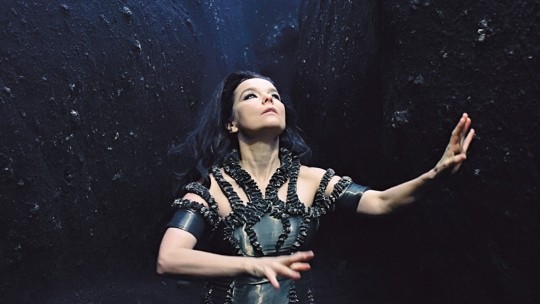
Ranking the albums of Björk
Today I will be ranking the albums of the fantabulous and wonderful Björk. She has been an influence on me ever since I first heard “It’s Oh So Quiet” back in 1995 and since I have been following her career extensively. Although her later albums are a bit less accessible commercially to her early work, I don’t believe she has released a bad album. I will be charting her work starting with her first solo album in 1993, and not including her work with Icelandic Punk-Pop group the Sugarcubes. I also will not be including her soundtrack to the film ‘Drawing Restraint 9’, as this was mostly instrumental.
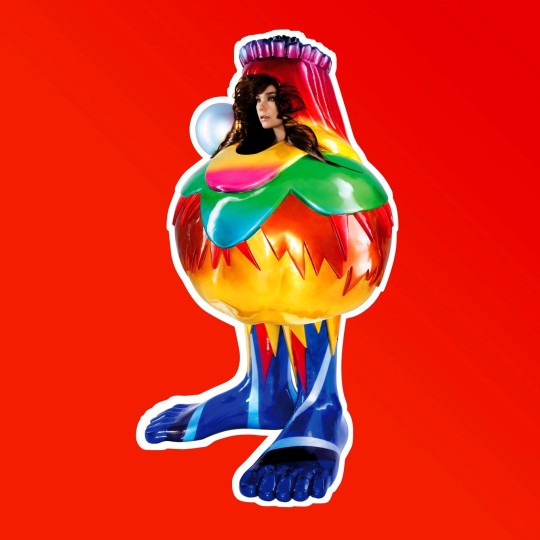
10. Volta (2007)
Volta seemed like Björk’s attempt to gain radio play again after having an experimental phase working with her ex-partner/filmmaker Matthew Barney. The album’s first two singles, “Earth Intruders” and “Innocence” were both produced by hip-hop giants Timbaland and his protégé Danja and featured a very electronic dance aesthetic. Though the album did quite well critically and is packaged beautifully, it does not feel cohesive or really as forward thinking as most of her work. Also, the Mark Stent remixes of each single, released separately, seem to outshine the album versions.
Listen to: Earth Intruders, Declare Independence, Wanderlust, Innocence.
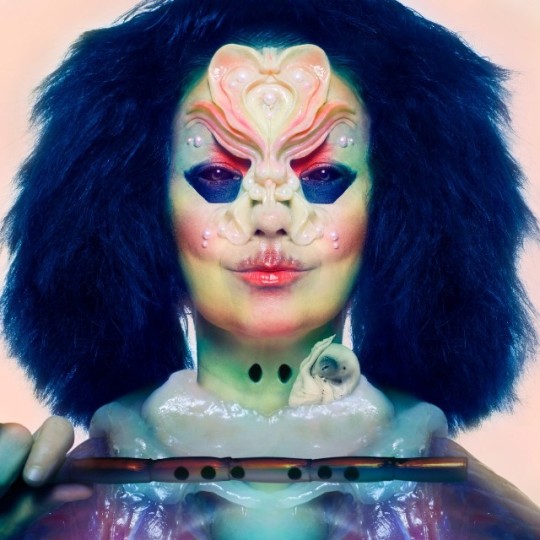
9. Utopia (2019)
Most Björk fans find this album to be a triumph but I currently still cannot enter the world of Utopia or find it interesting enough to warrant repeat listens. The album is her lengthiest (at over 70 minutes) and is a mixture of folk, electronic and studies more ethereal themes. Björk works with the brilliant producer Arca to help shape the landscape of each song, and at times it really works, but overall it feels overly long, and almost like a Björk parody.
Listen to: Arisen My Senses, The Gate, Sue Me, Saint
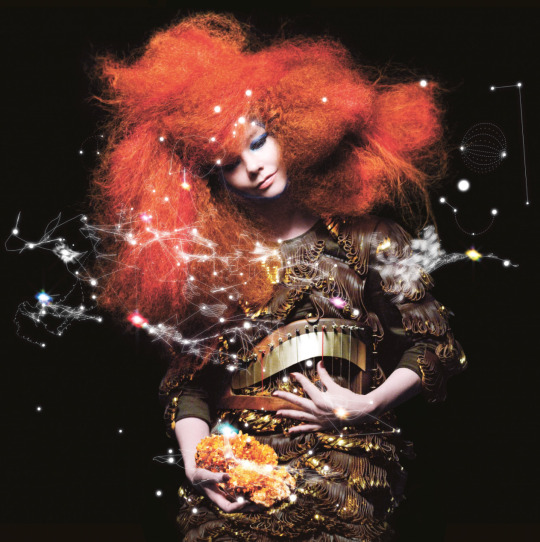
8. Biophilia (2011)
A concept album that deals with nature meeting technology. Each track is tuned to a different note on a tuning fork and sets of these tuning forks were even released as exclusive boxsets. Overall the album is well conceived and produced but does suffer from being a bit ‘samey same’, as some of the tracks blend together. I did see a concert on the three year tour for the album and I was incredibly impressed with how she was able to translate the sound live.
Listen to: Mutual Core, Crystalline, Thunderbolt, Moon

7. Selmasongs (2000)
This is the first soundtrack album conceived by Björk and contains the songs written for the film Dancer in the Dark. The film is a wonderful and sad story of an immigrant woman named Selma who is going blind, and who makes her days brighter by conceiving there is a musical happening when things seem to go wrong. The songs are quite good but not her strongest, though this may have been due to her tight time constraints and working with an orchestra.
Listen to: Cvalda, Scatterheart, 107 Steps, Overture
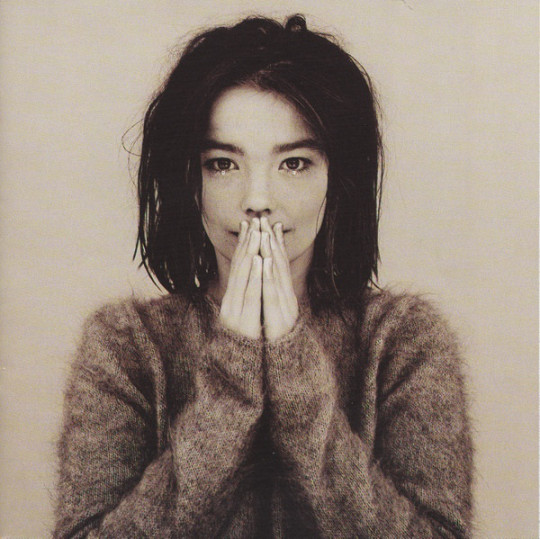
6. Debut (1993)
Björk’s first album post-Sugarcubes is a trip-hop masterpiece that not only launched her career but also brought London’s underground dance scene to the mainstream. This was thanks to producer Nellee Hooper who had previously won Grammy Awards working with Soul II Soul and Sinead O’Connor. Five singles were released from this album (four initially, and one on the re-issue) and all charted on the UK singles chart, with the album selling around 4.5 million copies Worldwide.
Listen to: There’s More to Life Than This, Venus as a Boy, Violently Happy, Human Behaviour, One Day
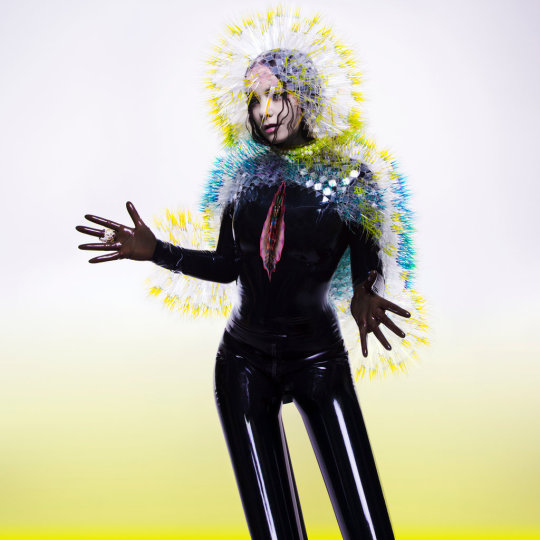
5. Vulnicura (2015)
Vulnicura in my opinion is probably the first album in Björk’s career where there were no radio-friendly tracks but rather a continuation of her wanting to push the experimentation of song constructs. Rather than release singles to promote the album Björk decided to create innovative music videos which tested new technology, such as 360-degree cameras. This later lead to a virtual reality exhibit entitled “Björk Digital” which went on an 18-month tour around the World. I still kick myself for missing it. Each song is produced by either her now long-time collaborator Arca (whom she met on her Biophilia Tour) or new collaborator The Haxon Cloak.
Listen to: Lionsong, Stonemilker, Family, Notget, Mouth Mantra
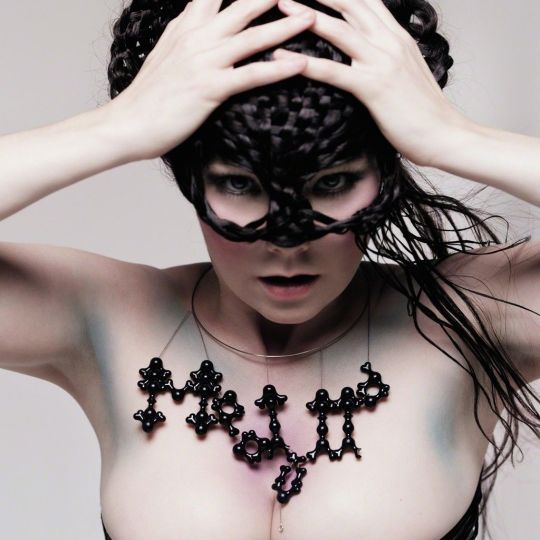
4. Medúlla (2004)
Being asked to write the theme for the 2004 Summer Olympics is an honour, but also to have its musical themes continue onto a full-length album is superb. Björk started writing Medúlla as “The Lake Album” in which she would strip all instrumentals from tracks and simply focus on voices. As she called it, a “very introverted” album and the title changed to the latin word for bone marrow, as it is the base building block of a person. Though some of the tracks do contain some synthesizers, 95% of the album’s beats and rhythms are made by mixing the voices of throat singers, beatboxers and choirs.
Listen to: Oceania, Where is the Line, Pleasure is All Mine, Sonnets/Unrealities XI, Triumph of a Heart
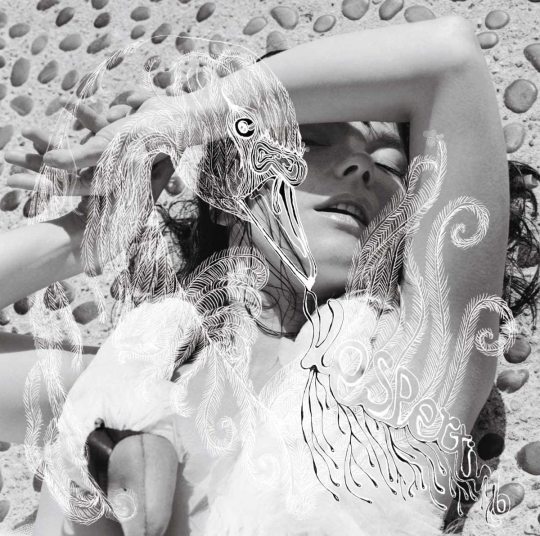
3. Vespertine (2001)
It took me a few years to get into this record as Vespertine was so far and beyond what anything Björk had created. I was used to the incredible experimental electronic sound on first three albums that when I listened to #4, which contains mostly micro-beats and soft vocals, and not to mention the infamous swan dress on the cover, it was a bit of a shock. Björk felt the energy of her 1997 release Homogenic was very masculine and aggressive and she wanted her new album to sound more feminine and explored her mindset during the filming of Dancer in the Dark as well as her relationship with Matthew Barney. I always felt Vespertine was a winter album as it feels quite Nordic in its soundscape. I’m glad I kept listening as it turned out to be one of my favourites.
Listen to: Harm of Will, Pagan Poetry, Hidden Place, It’s Not Up to You, An Echo A Stain
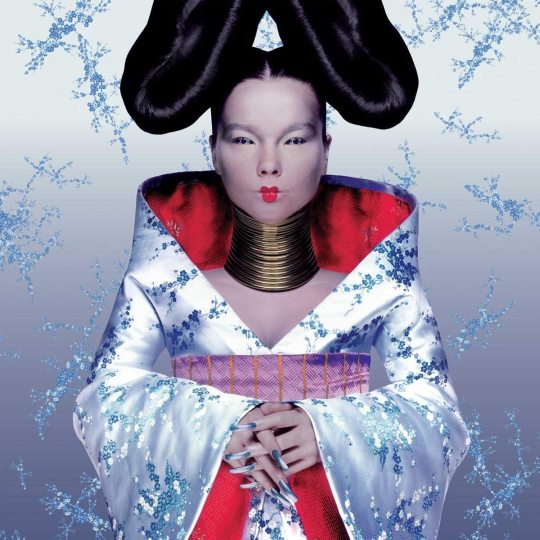
2. Homogenic (1997)
Wowser, already at number 2. I remember the first time I heard this record with my friends; they would think it too strange though I would think it magical. It became one of my most listened to records of my teens. Its glamorous and punk and the artwork is extreme. Björk’s album look was envisioned and created by genius designer Alexander McQueen, who would be her frequent collaborator until his death in 2010. Homogenic was produced by Howie B and Mark Bell, and Björk wrote the album as a tribute to Iceland, wanting the songs to create the landscape of her homeland. The album released five singles, three which would enter the UK top 40.
Listen to: The whole thing.

1. Post (1995)
Post is probably one of my top 10 favourite albums of all time. I could listen to it over and over again on repeat without being bored. The year 1995 was big for me in terms of musical discovery. I was 13 around the time I started buying my own cassette tapes and CDs. My Aunt came home from a business trip in London and brought back this CD. “It’s Oh So Quiet” was a massive hit in the UK and she wanted my brother, my cousins and I to hear this unusual and brilliant artist. The next year the Mission: Impossible film would come out and the song “Headphones” was featured, to which Björk sings to a friend about the feelings she has listening to his mixtape. I in tow would listen to that song every night on my Walkman before I fell asleep as it was a perfect way to end each day. Post was incredibly influential to me and to this day is a staple in my life. I can’t thank Björk enough for creating this iconic piece of music history.
Listen to: The whole thing.
Please, if you are so inclined to let me know in the comments how you’d rank Björk’s albums.
#bjork#ranking#mr. marc#mr. marc reviews#reviews#music reviews#post#homogenic#vespertine#utopia#2020#music#electronic#iceland#icelandic#debut#live music#musique#vulnicura#nattura#it's oh so quiet#hyperballad#possibly maybe#hunter#volta#biophilia
29 notes
·
View notes
Text
source: Loudersound May 31, 2016
How Mayhem’s De Mysteriis Dom Sathanas changed metal
By Dayal Patterson (Metal Hammer) May 31, 2016
Mayhem are one of the most influential black metal bands on the planet, and their album De Mysteriis Dom Sathanas remains a timeless classic
It is an album whose significance, both inside and outside of black metal, has been acknowledged by a wealth of leading contemporary metal acts, from Watain to Enslaved to Inquisition, and one that led Nergal of Behemoth to proclaim it “the opus magnum of extreme metal”. Two decades after it was recorded, it continues to top ‘best album’ lists by longtime fans of the genre, while at the same time providing primary inspiration for new bands whose members were not even born when it was recorded. There are many who would say it is the single most important album in black metal’s broad and ever-growing catalogue, and very few who would argue that it is not, at the very least, a strong contender for that accolade.
The record in question is none other than Mayhem’s De Mysteriis Dom Sathanas, a milestone work that the long-serving Norwegians are set to perform in full around Europe this year, including Finland, Norway and France. And well they might, for this is an album that has lost neither its devoted following, nor any of its potency, in the years that have passed.
There are plenty of even more hyperbolic (yet equally true) statements that could be made in support of this unique collection of songs. Yet the biggest testament to its artistic value is perhaps the fact that discussion of its recording, songwriting and performance qualities continues to outweigh the highly notable circumstances of its creation. Indeed, it is testament to Mayhem’s significance as a musical force that any music was able to overcome all the drama involved with the band during the period in question. For – as most reading this will probably know – this is also a record that captures the vision of a musician who was not only cut down in his prime, but cut down by a bandmate appearing alongside him on this very recording.
The former party is of course Mayhem guitarist and co-founder Øystein ‘Euronymous’ Aarseth, who was stabbed to death in his apartment in August 1993 by the latter, Varg Vikernes, best known for his similarly-influential project Burzum but also the bassist for Mayhem during the era of De Mysteriis’ creation. The ultimately fatal conflict between the two men is a long and complicated episode in black metal’s grim history that has been discussed at length by fans and media alike for two decades.
What is still worth noting today though, is that the album’s roots are intrinsically linked to two now-departed members of the band. The second is the Swedish-born vocalist Per Yngve Ohlin – otherwise known as ‘Dead’ – and in fact it was he who actually came up with the title; Latin for ‘Of Lord Satan’s Mysteries / Secret Rites’, and a title taken, he explained, from an occult book he had discovered. The fact that Dead took his own life in 1991, while the album was released in 1994, gives some idea of how long the band’s debut studio album was in gestation.
Certainly it was long enough that the band’s first full-length, the legendary live album Live In Leipzig, (recorded in November 1990 but released almost three years later) captured the band (the line-up then comprised of Dead, Euronymous, bassist Necrobutcher and drummer Hellhammer) performing no less than half of its eight numbers. The oppressive, melancholic and suffocating aura found on that recording would thankfully remain in place following the transition of these aforementioned songs to the studio. While the obvious standout track Freezing Moon ia a grim monochromatic epic that remains a fan favourite even today – the unholy and, well, freezing feeling within that song is just as present on Funeral Fog, Pagan Fears, Buried By Time And Dust.
Complementing these older compositions and undoubtedly giving the album a more three-dimensional character was the incorporation of four newer, somewhat more angular and twisting songs, namely the title track, Cursed In Eternity, Buried By Time And Dust and From The Dark Past. Euronymous’ playing had become somewhat more calculated and considered by this point, his writing influenced significantly by the introverted but talented guitarist Snorre Ruch, whose unique approach to riffing within his band Thorns had proven ridiculously influential within the Norwegian scene. In fact, Snorre (now going under the name ‘Blackthorne’) would be inducted into the group as a second guitarist prior to the album’s recording. Despite not appearing on the finished record, he would contribute entire Thorns riffs to several songs, his presence being felt not only during these moments but more generally through his impact on much of Euronymous’ creeping guitar work.
His other role would be to rearrange Dead’s lyrics on several songs in preparation for the deceased vocalist’s replacement, Attila Csihar. A Hungarian musician who was admired in Norway thanks to his short-lived but seminal black metal band Tormentor, his appointment and spirited performance remains a defining factor of the record, and it was one that provoked no small controversy at the time. In contrast to the more typical black metal vocal styles of the time he introduced an eccentric, otherworldly and theatrical approach incorporating a drawling delivery and lurching from screams and rasps to an almost operatic form of singing that makes a feature of his distinctive Hungarian accent.
“The way of singing it, we were talking about how to do it of course,” recalled Attila in an interview conducted back in 2009. “I heard some demo recordings that had been done by Dead and [previous vocalist] Maniac before, but I like individualism… so when I talked to Euronymous in the studio I said, ‘Why don’t we try something else instead of making again the traditional screamed vocals?’ The De Mysteriis Dom Sathanas song, when I looked at the lyrics there was this Latin line so I thought, ‘Let’s do this voice there.’ I came out with the low vocals with more melodies, and he liked it so much we did the whole recording that way.”
Though seemingly a long-running plan on the part of Euronymous, the decision to use Attila for the role proved as much of a surprise for other musicians in the Norwegian scene as it was for the Mayhem fanbase. After all, not only was Euronymous surrounded by an abundance of local talent, but many of the vocalists in the country actually knew the songs on the forthcoming album already, having listened repeatedly to an instrumental tape that had been making the rounds for some time.
“People were a little bit pissed that they didn’t receive the phone call,” recalled Grutle of Enslaved during the same interview, “but they thought, ‘Well that’s going to be interesting’ – and it was! Actually while [Attila was] doing the vocals Øystein went to the callbox and called me and said, ‘He sings like a sick priest, he sings in Latin, with an accent, it’s incredible!’”
Of course, one cannot mention De Mysteriis without mention of the pounding and detailed percussion that underpins it. A fine performance by one of black metal’s best known drummers, Hellhammer (a man who has performed for innumerable bands from Arcturus and Covenant to Dimmu Borgir and Shining), the formidable yet restrained drumwork is complimented by both the spacious, eerie and strangely minimal bass work and a powerful and gloriously unpolished production. The latter is no small factor in the album’s success and was apparently the result of a considerable amount of work on the part of both Euronymous and the infamous Pytten, a producer who spent much of the 1990s capturing iconic works by legends such as Enslaved, Burzum, Hades, Gorgoroth and Immortal.
“Euronymous had specific ideas about each instrument and he had specific ideas about echoes,” recalled Attila. “The drums were recorded in a huge concert hall, solos were recorded in a room and he was moving round all the time and saying, ‘Okay, there we have it.’ If you listen to records from the time and then De Mysteriis you hear the production is far and away better than anything else.”
“The whole album was recorded in very spacious areas,” confirmed producer Pytten. “Øystein, Hellhammer and me were walking about, talking about how to do it and I really wanted to use the stage for the drums. I really like big sounds — especially for the drums — and reverb on the leads. So the drums were done on stage and [in that hall] you have nine stories going up, so we closed the room side, but kept all the height.”
It isn’t only the drums that utilise large numbers of tracks, another defining ingredient in the album is the mass of multi-tracked guitars, which create a huge (yet suitably icy and treble-heavy) wall of sound, a perfect compliment to the similarly sizeable percussive bombardment. Indeed, the combination only accentuates the crushing and malevolent character of the whole record, the overall effect being a dense and impenetrable assault on the senses, one only balanced by the surprising touches of groove throughout the album.
And this is perhaps the last thing to underline, particularly for newcomers to the record. Though undeniably a standout opus, it is not an easily accessible work – even by black metal standards – and is not necessarily a gateway album. Nor is it meant to be. It is a purposely gloomy and aggressive beast, and one that makes no concessions to outsiders, instead following its own wilful and destructive path without any apology. Give it the time it deserves however, and it will be with you forever. We can only hope that its forthcoming live invocations are equally memorable.
The interviews in this piece were originally conducted for the book Black Metal: Evolution Of The Cult and appear in an extended form there. The book and its sequels are available at now.
#gallery-0-9 { margin: auto; } #gallery-0-9 .gallery-item { float: left; margin-top: 10px; text-align: center; width: 100%; } #gallery-0-9 img { border: 2px solid #cfcfcf; } #gallery-0-9 .gallery-caption { margin-left: 0; } /* see gallery_shortcode() in wp-includes/media.php */
#gallery-0-10 { margin: auto; } #gallery-0-10 .gallery-item { float: left; margin-top: 10px; text-align: center; width: 100%; } #gallery-0-10 img { border: 2px solid #cfcfcf; } #gallery-0-10 .gallery-caption { margin-left: 0; } /* see gallery_shortcode() in wp-includes/media.php */
youtube
youtube
How Mayhem’s De Mysteriis Dom Sathanas Changed Metal source: Loudersound May 31, 2016 How Mayhem's De Mysteriis Dom Sathanas changed metal By Dayal Patterson…
#arcturus#attila csihar#øystein &039;euronymus&039; aarseth#behemoth#blackthorne#buried by time and dust#burzum#covenant#cursed in eternity#de mysteriis dom sathanas#dimmu borgir#enslaved#freezing moon#from the dark past#funeral fog#gorgoroth#grutle#hades#immortall#jan axel &039;hellhammer&039; blomberg#jørn &039;necrobutcher&039; stubberud#live in leipzig#maniac#mayhem#nergal#pagan fears#per &039;dead&039; ohlin aka pelle#pytten#shining#snorre ruch
2 notes
·
View notes
Text
Concert Date
This one is ALMOST 3,000 words. It’s 2,997. So close. But I didn’t want to add three more words XD
Previous MLQC writings: 1, 2, 3, 4

I stood in the VIP seating section of Kiro’s concert with a small smile on my face as he bounded onto the stage. “How’s everyone doing tonight?” he asked brightly.
Shrieks of excited fans immediately filled the concert hall. Kiro chuckled.
“Glad to hear it. It’s so good to see everyone. Thank you all so much for coming to this performance—”
“I LOVE YOU KIRO!” a fan shouted.
Kiro beamed. “I love you too. I love all of you. I can’t put into words how much it means to me to have support from fans like mine. You’re all always so excited and enthusiastic. For a guy like me, nothing could be better. I’m so thankful to each and every one of you.” He cleared his throat. “Tonight, I’d like to dedicate this performance to my best friend. Without her, I wouldn’t have been able to finish half the songs on the new album. Mostly because she has the most terrifying glare I have ever seen.”
He glanced over at me while the crowd laughed. I glared at him for calling me out. He smiled slightly and winked.
“Alright! Now that that’s out of the way, who’s ready to get—this—started?!”
The amount of noise that filled the venue made me break out my earplugs before the music even started. I jammed them into my ears and covered them with my hair. I could still hear everything, but it was just muffled enough that my ears weren’t aching in protest.
He started to sing. Most of the venue sang along with him. Including me.
Before we met in that convenience store, I’d always been aware of his music, just never been a huge fan. Sure I heard his songs on the radio all the dang time, but I’d never sought it out. Kiki owned basically all of his albums, and she liked to play them during quiet moments in the office too. I knew his songs but I’d never known much about him besides superstar.
Then we ran into each other and I was instantly charmed by him. That was when I started to really be a fan.
Savin was sitting next to me, pretending he wasn’t Kiro’s manager and agent. I liked to pretend I didn’t realize he flirted with me a lot because it would often get an embarrassed rise out of Kiro, but I knew Savin thought I was attractive.
Victor always thought I was an idiot because he talked about stuff I didn’t know a whole lot about. But if he ever bothered to ask me about subjects I was more knowledgable in, he wouldn’t be so quick to deal out insults to my intelligence. I wasn’t terribly business-savvy was all. But I wasn’t so stupid that I couldn’t tell when Savin was flirting with me. It wasn’t like he was subtle about it. Kiro wasn’t subtle about his flirting either.
And Kiro knew, deep down, that no matter how much his agent flirted with me I only had eyes for Kiro. He pouted when Savin flirted but never threw a fit.
As the concert continued, I glanced at Savin out of the corner of my eye. I wondered if he knew about Kiro’s Evol. Kiro hadn’t directly told me about it yet, but after Victor froze time in the middle of the studio and Kiro wasn’t frozen with it, I knew he had some sort of power.
I suspected it had something to do with his success as an idol. The charm that made everyone fall in love with him. It wasn’t as flashy as Gavin’s power over the wind or as incredibly powerful as Victor’s ability to stop time, but it still made him influential.
And it was lucky that someone as caring as Kiro got a power like that. If someone with the wrong hands could charm anyone into doing anything, that could be catastrophic. Kiro just used it to convince his fans he loved them all and make sure they knew he was genuine when he said it.
Savin probably had no idea.
I went back to watching Kiro.
The stage lights were causing him to sweat. His gold bangs clung to his forehead in places. He’d removed the jacket he’d jumped onto stage wearing, throwing it over the back of the piano to reveal the pale yellow tank top underneath it.
I leaned over to Savin. “Does he wear all that jewelry by choice or because his stylist says so?” I called over the blasting music.
Savin regarded Kiro thoughtfully. “A mixture of both,” he said. “The earrings and ring are all him. Most of his necklaces are his stylist’s idea. Same with the bracelets and every other ring besides the one on his right pointer finger.”
“Cool. Just wondering.”
We went back to watching the concert.
At intermission, we got up and slipped backstage as subtly as we could.
“Miss Chips!” Kiro exclaimed, wiping his sweat off on a towel that he quickly handed to a staff member before rushing to me and throwing his arms around me. “You came!”
“Ew—Kiro you’re all sweaty!” I protested—with a laugh so he knew I wasn’t actually cross with him. He let me go with a pout. I whacked him lightly in the arm with the back of my hand. “And of course I came, silly! I wasn’t going to miss this for the world!”
He laughed and ruffled my hair. “Thanks. I’m really glad you’re here.”
“Well, I’m happy to be here.” I smiled and gave him another hug so he knew I was being genuine.
“Kiro, go change!” Another staff member shouted.
“Oh right!” Kiro said, eyes going wide. He grabbed my hand. “I gotta get out of these sweaty clothes for Act Two but I’ll be right back!”
I smiled. “Of course,” I said. “I’ll be right here.”
He rushed off, fingers clinging to mine for as long as he could before losing contact and breaking into a run. I chuckled and leaned against the wall. Savin had his arms folded.
“I never see him as happy as he is with you,” Savin said.
“Well… sometimes we just need one friend who doesn’t judge us for everything we do. Kiro’s been lucky to not fall out of public favor yet because he’s so charming and kind, but he knows he can be himself with me. If he gets mad, I won’t destroy his career. If he has a breakdown from stress, I’m not going to report it for all the world to see. He can be his private self with me instead of his public performance. So I think it relieves him to be around me.”
Savin hummed in thought. “I’m grateful you two are such good friends.”
“He’s easy to be around.” I shrugged.
“How did you two even meet anyway?”
“Luck,” I said, completely dodging the question. Kiro hadn’t told him about the convenience store? Alright then. I wouldn’t either. “I mean, I’m a producer. I bump into people of various levels of fame for work a lot.”
That was acceptable, right?
Kiro came bounding back to us in a new outfit, this one just a tank top and jeans, completely foregoing a jacket to cover his arms and shoulders. He had a makeup case in his hand and was hastily smearing it over his face to try and stop his skin from being shiny before he started sweating under stage lights again.
“Told you I’d be right back!”
“Yes, you’re very punctual,” I said playfully. “Here. Let me get your forehead. You completely missed a patch.”
“I did?” He complained.
“Yup!”
“That’s what happens when you don’t use a mirror,” Savin remarked. I took the makeup and sponge applicator from his hands and started filling in the spots Kiro missed.
“Hold still—you’re like a squirmy puppy!” I chided. He froze under my fingers, eyes wide. “Thank you!”
He gave me a sheepish smile. I smiled back. Gosh this man was adorable.
I made quick work of his makeup and then we were being pulled in different directions. Savin was pulling me back to our seats and the other staff was pulling Kiro back toward the stage. Someone handed him an energy drink.
“Oh that’s not gonna be good,” I muttered as a door swung shut, cutting off my field of vision.
We retook our seats just in time for Kiro to jump back onstage with all the energy of a sunlit tornado. “Aaand we’re back!” he called.
Fans screamed. Savin and I chuckled.
“Hey Savin.”
“Yeah?”
“I bet you a bottle of soda that Kiro has a massive sugar crash right after the show.”
Savin chuckled. “You’re on. We’ll go visit after the show and see how he is.”
I laughed.
Kiro stopped entertaining the crowd with his sense of humor and went back to his songs. He started it with one of his most popular love songs from his first-ever album. The crowd sang along enthusiastically. Out of the corner of my eye, Savin scrunched his eyebrows and looked down at his phone.
“What is it?” I asked.
“This wasn’t on the original setlist,” he said.
At that moment, Kiro looked over at me. His smile grew wider—but I had no idea how he could even see me past the stage lights—and he shot me a wink. The image of his wink on the two jumbotrons flanking the stage made the fans scream.
No one but me knew who he was looking at.
I sang along for the whole rest of the concert with the all of the other fans and then followed Savin backstage once again when it was over. We were told once it was over, Kiro went right to the dressing room and hadn’t emerged yet. He’d done two encores in order to finish the setlist after inserting his old love song and I didn’t blame him for being exhausted.
I followed a staff member to his dressing room—that had a big star on the door.
Knocking gently, I called, “Kiro? You in there?”
Rustling preceded Kiro opening the door. “Miss Chips,” he greeted softly. His hair was a sweaty mess and his eyelids were drooping. “C’mere.” He pulled me into his arms and planted his nose in my hair. “‘M tired.”
“I know. But you did so well. I’m so proud of you.”
“Can I go to sleep now?”
“Yeah. We’ll load you up in the car and then you can sleep all you want,” I replied.
Savin nodded to me.
“C’n you… stay?” Kiro mumbled.
“Of course. I’ll stay with you as long as you want.”
He smiled into my hair. I felt it rather than saw it. He leaned heavily on me as I followed Savin to the back of the venue and into the car. Kiro draped himself over my lap and almost immediately passed out.
Savin got in the driver’s seat.
“He’s out,” I said.
“Just tell me what kind of soda you want,” he joked, starting the car.
I played with Kiro’s hair on the drive back to his villa, twisting it around my fingers, eyelids drooping myself. It was late and concerts were draining.
When we got back to his place, we roused Kiro, but I doubted he was actually awake. He walked back to his room while still relying on me for guidance and support, but he didn’t speak. I imagined it was like when I got my wisdom teeth out—at some point I’d walked from the surgery table to the recovery room table, but I don’t remember it at all due to the anesthetic. I figured Kiro’s post-concert exhaustion was similar.
Once I got Kiro all tucked in, I returned to the front of the house. Savin was waiting for me.
“C’mon. I’ll drive you home,” he said.
“Thanks,” I said.
“Shall we pick up a soda on the way?”
“Nah. I just wanna go home and get some sleep. We’ll take a rain check. Next time we see each other you can grab me a soda.”
“Deal.”
We went and got back in the car. Savin started it and then paused while he pulled his seatbelt on.
I glanced at him. “Something wrong?” I asked.
He shook his head. “No. Nothing,” he replied. Clicking his seatbelt into place, we started to drive off. I supplied the address of my apartment building and then settled into silence, perfectly content to let the classical music radio station fill the time between Kiro’s house and my building.
Savin, apparently, was not.
“You and Kiro seem close.”
“Well, I don't imagine he has many other friends.” I shrugged. “He’s always touring or writing new songs or being swamped by fans. It’s sad but natural that he should cling to the one friendship he has that really isn’t work-related.”
Savin opened his mouth to say something, but didn’t get the chance because I cut him off.
“Humans are aggressively social creatures by nature—it’s how we survive. Taking care of each other, forming bonds. I mean—humans bond with Roombas for goodness’ sake! We want to care for the people around us. Kiro doesn’t get that chance as often as a non-celebrity would. And then I come along and I’m kind and relatively calm and offering unconditional friendship. Of course he’d grab that like a life-preserver ring and hang on as tight as he could.”
Savin sighed. “I suppose you’re right. Do you think there’s something I can do about—”
“No and I don’t think you should try,” I interrupted vehemently. “You may be his manager but you don’t have to manage every single aspect of his life. You could loosen up a bit and give him leave to make more friends but you absolutely should not try to force anything.”
“Alright. You’re right.”
“Thanks.” Sometimes it was nice to hear that I was right when I spent half of my professional life listening to Victor tell me I was always wrong. I glanced out the window and watched the landscape pass.
“You really love him, don’t you?” Savin asked.
“Who, Kiro?” Given my mind had drifted to Victor for a moment I had to make sure I hadn’t mentioned any of it out loud and changed the subject of the conversation.
“Yeah.”
I felt my ears burn and knew I must have been going red—thank goodness we were driving in the dark of late-night.
“Well, I, uh…”
“It’s okay. You can tell me.”
“I, uh, I do love him—I know that much. But I don’t know if I love him… romantically. We’ve kinda been dancing around that for a while and… we haven’t really had many chances to explore the nature of our relationship in that regard. I’d do anything for him that I could within my power and I really just want to see him happy more than anything.”
Savin cleared his throat. “… Right,” he said, clearly unsure of how to respond to that.
I sighed and went back to watching the landscape fly by out the window. “He may act a lot like a boy but he’s a good man,” I added thoughtfully.
———
“Yeah that first problem when all the other hackers were in the room was too easy,” Kiro remarked while we were hanging out at his house. I was writing a show proposal to report to Victor and Kiro was doing… something. He had a laptop open too but he typed a lot faster than I did and I couldn’t see his screen. He could have been hacking—he could have been writing a new song. I had no idea. I felt like songwriting was more of a spiral-bound notebook thing.
“You call that ‘easy’?” I asked, looking up from my screen in confusion. “Really?”
He snickered. “Oh yeah. I’ve broken codes waaay harder than that over breakfast.
“Kiro!”
“What? It’s true.” He smiled at me—that bright, pleasant smile that made everyone’s problems feel like they were melting away.
“So. You said your mentor gave you the name Kiro. Was this the same mentor who passed the mantle of Key onto you? Or did you have a superstar mentor and a hacker mentor?”
That made him laugh. “It was the same mentor. He gave me Kiro. To be honest I don’t really remember what my name was before that. It’s been so long and, really, it doesn’t matter anymore. I am who I am and Kiro is a big part of that,” he said thoughtfully. It was one of those moments of profound maturity where the playful Kiro took a backseat to show off that he really was an incredibly wise, intelligent guy.
———
We’d had that conversation not long after the summit, hanging out at his place. It really solidified for me that he was an extremely complex person and a good one on top of that.
Savin dropped me off at my apartment building and waved as I ducked inside. By the time I got up to my unit, he’d driven off.
Exhausted—since concerts lasted forever and getting out of one was a whole time commitment in itself due to traffic—I took a shower, put on my pajamas, and fell right to sleep.
I don’t remember any of the dreams I had. To me, my sleep felt dreamless. A long expanse of healing blackness that ended with a loud vibration of my phone against the mug on my bedside table. Grumbling to myself, I cursed last-night-me for setting my phone so it was pressed against the ceramic mug.
I smacked around on my bedside until I found my phone. The buzzing wasn’t an alarm. It was my day off.
It was a text.
Kiro: Thanks for everything last night, Miss Chips. You really are the best <3
I smiled.
Me: You’re welcome, Kiro. It’s my pleasure :-)
#MLQC#MLQC Kiro#MLQC FanFiction#MLQC Imagine#Mr. Love Queen's Choice#Mr. Love Queen's Choice Imagine#Mr. Love Queen's Choice FanFiction
37 notes
·
View notes
Text
READ ME
ZERO TOLERANCE FOR RACIST CHASERS/GAY-FOR-STRAIGHT-CONSUMPTION/OOC TRANSPHOBIA/ANY RACISM WHATSOEVER UNLESS SHOWN AS BAD BY NARRATIVE AND CONFINED TO AGREED UPON PLOTTING
I set Savers in its airing year, so Masaru was born in '92. Can take place anytime after episode 49. However, there just won't be any explicit sexual content regardless of when the thread takes place. I also don't auto-ship: I'm here to walk a character through things, so ships will all be more slow-burn. Also, while Masaru's just pan, I'm actually asexual, so don't even expect me to present beyond a textbook understanding of sexual attraction
Masaru's kind of a jerk. My other two muses are generally at least kind unless the other person isn't, but Masaru's kind of abrasive and gleefully violent. If we're playing, I'll probably warn you beforehand, but Masaru may snap at your muse if your muse isn't a little kid. If your muse didn't deserve it, he'll probably apologise at some point, but yeah, this muse is even less like me than 02's Ken (Bleach's Ichigo is my muse most like me)
I'm on mobile. Period. I can't cut threads. I usually just tag "long post." Can't cut threads.
Seen JP ver only. Haven't seen any others, and I have no reason to bother--the original's in my native. Why would I bother with "orange juice bomb"?
Masaru is mixed race here. In a planned project that's a sister project to my Bleach project I already got a bit of stuff up for, Masaru's mum is Japanese and Russian, and related to Junpei of Frontier, and Masaru's dad was Japanese and Afghani. Masaru actually does speak Japanese, Russian, and Persian.
Masaru's also trans here. He never got puberty blockers, but he finally got testosterone at 13. So his voice changed at a pretty normal age. But he does need a binder and all that. (He loved that black tank top he wears after the memory wipe because it was just the right cut to cover the binder while showing off his arm muscles!) He does someday want kids, and Japanese law, like most US states or most places, requires sterilisation to recognise gender change. His papers also say a different first name. Of course, this probably came up with Satuma. Satuma and payroll at DATS probably know all about it. But being trans isn't *as* hard in Japan as the Anglophonic world. Especially thanks to Kamikawa Aya advocating on outlets like NHK radio since '95, which Masaru would be three then.
I toss the epilogue. Don't like the losing their digimon, and Masaru ditching his family he feels so responsible for and his dad he just got back?
Actually, in my project, ep 48 never happens. Suguru is dead, DATS remains, and Sayuri gets BanchouLeomon as her digimon partner.
Oh, another rule--poor spelling and grammar is acceptable if you are not a native speaker. It infuriates me to no end that I'm supposed to be an idiot for being fluent in three just because English is not my first, but native speakers get to run around spelling "bins" "ben's" and congratulating themselves for "kohnichuwa" but I get beaten/decried for actually knowing the language... And also, ,ZERO TOLERANCE for "garnish my human default English with exotic Japanese uwu" See "zero tolerance for chasers and racism"
Totally available to play in Japanese or Spanish, but you must be fluent.
Masaru lives in Tobechou, Yokohama. I went to the Chinatown in Yokohama once with my dad, but I lived in Koube. And we didn't leave Hanshin region all that much. My knowledge of much outside there being a Chinatown in the '80s (obviously still there, as it was the setting for the Savers movie) and big landmarks like Minatomirai is minimal. I also haven't been back to Japan period since '94. My relatives there are all deceased since the '90s, and flights alone are 1,000$, which, until recently, was definitely over a month of rent. Two for a studio, one plus a couple hundred for a 1 or 2LDK, depending. Might even have had 1.5 baths. By the time Savers was airing in Japan, I was able to keep up with Japanese news via now-gone Japanese-language broadcasts in California, as well as the Web, which is also how I saw Savers. But my knowledge of Japanese things may run the risk of being almost 30 years out of date. Or it might be completely current because I still read Asahi News, the most left-leaning paper I can find. Unsure if related to Hanshin region channel 6, but channel 6 was the best when I was there.
The Daimon family didn't move when Masaru came out, but he came out pretty young. It's just difficult to get trans care for minors. That being said, most peers don't know he's trans. They do know he's mixed, though. That being said, it's not like it's *only* him fighting racist bullies. It's only partially that. Like I said, I fully acknowledge he's pretty abrasive. So he's not completely blameless for all the fights. He could easily someday be the kind of parent who gets arrested for punching a rival dad. Violence is not a last resort for him. It's the best resort.
I do multi-para and don't use icons. But I'm not asking for an exact word count match. All I ask is give me stuff to go off of in replies and for Heaven's sake, do *not* format like House of Leaves when you play with me. Format button abuse looks like a visual panic attack, and is just too chaotic for me to read.
I may go spotty on replies with you. I'll still chat with you via the messenger thingy, and I don't play with people I've never spoken to, even if I've started the interaction, because I need to filter for my sanity, so I need to know the people I play with aren't gonna pull racism or something on me, but when my replies slow, it's because I work on-call at a shelter for seriously physically ill people, I'm also disabled myself, and I don't have the ability to put enough energy for the high-quality replies I strive to give in at the moment. I'm stalling because I want to give you my best. If I want to drop a thread, which is admittedly rare, I'll let you know. I won't leave you guessing.
Some h/cs just for fun
Masaru loves metal. The metal I know is 70s prog and 80s glam metal and stuff. I don't really like much music past about '94, and exactly two albums after 2000 (neither are metal)
Masaru has always had the same kind of attention span I have now even though I completely didn't when I was younger. He's running commentary if you watch an movie with him, his biggest problem with school is the whole sitting and passively listening to a lecture part, he thinks he doesn't like reading because others always talk about sitting there and reading for hours on end (if he's older, he may have realised it's OK to read for 20-minute bursts, something I eventually realised, too). He only really learns by doing. That being said, depending on age, he may not have had the chance to *realise* that yet.
He wouldn't become a sumo wrestler, but he totally watches it. Honestly, any fighting sport, and he's there.
He's very Japanese as far as religion. Sort of takes part and believes in a lot of them at the same time, but none are a overly influential part of his life. This is a thing.
Crossovers with any season preceding Savers are pretty easy with this blog considering my project. The project will eventually merge with the Bleach project, toi, so I also have a thing for that. Overall, I welcome crossovers with most animated media. Live action, I'll consider if you don't use icons with me (it ends up looking like Who Framed Roger Rabbit in my head) I don't do any real person stuff beyond, say, having Masaru listen to real bands or know of other public figures.
There is also a flexibility in playing Masaru in other countries. He could visit family in Russia or Afghanistan, he can be sent over from DATS to help with digimon appearances in countries allied with Japan (coughcontroloverjapanliketheuscough) or I totally ship him with Touma, so he could be in whatever that country is (obviously a Germanic nation in Western Europe)
He's definitely leftist, but his tactics aren't really common among the left. Typically, it's the fascists that will throw the first punch. Except Masaru will, as well. Unfortunately, this means he can take *away* from, say, antifa efforts to counter demo anti-Korean rioters.
He looks down on most weapon use, but probably none more so than guns and other weapons that remove the user from the target. To him, anyone who hides safely behind a weapon and makes the fight so one-sided is a coward. To this extent, he thinks war should be done away with and the leaders of the countries should duel instead of America just wiping out thousands of Japanese (WWII) or Afghani (during his lifetime) civilians (well, in that war, it was definitely not the Afghani government's fault, as that was a radical rebel sect powered initially by Regean, but it was most certainly civilian deaths en masse)
Masaru cannot meditate at all. He's also very reactive. To that extent, he's never really done well with martial arts. There's a lot less focus on self-discipline in boxing and wrestling than in Aikido or karate or what have you. He'd probably love the intensity of Krav Maga or CQC. I just don't know if Krav Maga has a self-discipline component. CQC almost certainly doesn't--it's American.
More when I think of it.
1 note
·
View note
Text
Linkin Park - Albums Ranked
I’ve written about Linkin Park before. It was following the death of Chester Bennington and mostly covered my mixed emotions about death. I’ve never really talked about how much I truly love the band’s work. Its been over 2 years since Chester passed and I think I‘m finally ready to dive back into the LP catalog whole-hog. As a young 17-year-old when Hybrid Theory came out I was the right age to fall in love with everything LP was doing. Their first two albums, the unreleased debut EP and the remix collection Reanimated were permanent fixtures in my CD case. It was a time of angry white guy music and LP were literally the best at the craft.
I’ve followed them VERY closely ever since and have always had strong opinions about each one of their albums. It's finally time to sit down, seriously critique each one and give my definitive ranking of LP’s LPs. For this list, we won’t include the aforementioned EP or any remix albums or live releases. I also won’t be including any of the many LP Underground CDs. As fun as those releases are, there are only 7 albums that actually matter. Here they are ranked from 7 to 1.
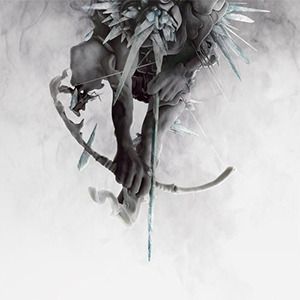
#7 - The Hunting Party
After a couple of experimental albums, 2014′s The Hunting Party was seen as Linkin Park’s conscious effort to make a heavier, more metal record. While technically they succeeded, the results were mixed at best. Much of the metal feels forced and sometimes awkward. The lead single “Guilty All the Same” stands alone as the worst lead single in the band’s catalog. Not to say its all bad, “All For Nothing” is a legit classic and an example of LP’s strength as a “metal” act. Ultimately, It’s a gutsy album that falls flat more often than not.
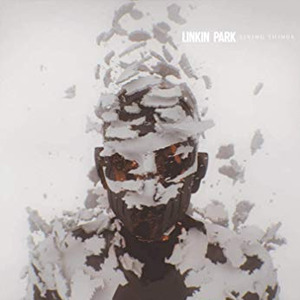
#6 - Living Things
Back when Living Things was released I wanted to like it so badly. The lead single “Burn It Down” was reminiscent of the LP sound of earlier albums and “Lost in the Echo” really resonated with me. However, they had not shed the more experimental ideas adopted on their previous album. The result was a half-hearted experiment that couldn’t seem to commit to a direction. If you were to tell me Living Things is a collection of trashed B-sides from the previous 2 albums, I would completely believe you. Even when I revisit the album I’m left with a feeling of disappointment because it could have been so good.

#5 - One More Light
One More Light gets a bad wrap. Is it a pop album? Yes. Does that bother me? No! Should it bother you? Absolutely not! After The Hunting Party, this is exactly the album Linkin Park needed. It’s their most emotional work since Minutes to Midnight and track to track the album is immensely therapeutic. Despite most of the lyrics being your typical sad LP affair, there’s an underlying joy to the whole project. Like the band finally felt unburdened by their reputation and was making the music they wanted to make. "Sorry For Now” even sees Shinoda and Bennington pseudo swapping the rapper/singer roles. It’s really the first album where Shinoda’s singing feels natural. I’m not saying I wanted to see a new career direction, with LP making pop albums for a decade, but for that moment in time and taking into consideration the devastating events following its release, One More Light might be the perfect album.

#4 - A Thousand Suns
A Thousand Suns was LP’s first big shake-up of the established formula. The standard Rap/Rock ingredients are technically there, but it’s wrapped in a sonic chaos of future-like abience and anchored by samples from speeches by notable historical figures like J. Robert Oppenheimer and Martin Luther King Jr. It’s a concept album that aggressively strays from anything you’ve ever heard before. To this day I’ve never heard a band steal the style and sound of A Thousand Suns, and while the rest of the LP library can be reductively placed in a “tracks that sound like the 00′s” box, A Thousand Suns stands as evidence that the band is more talented and interesting than you think. This is LP’s Ziggy Stardust, 2112, or American Idiot. It may not be their best album, but it’s absolutely their coolest. Oh, and “Waiting for the End” slaps harder than any other song in their catalog.
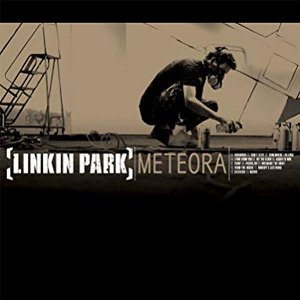
#3 - Meteora
Meteora had the difficult task of following up one of the most successful and influential rock albums of the new century and for the most part, it did a wonderful job of maintaining the established sound of Hybrid Theory while stretching its legs in relatively predictable directions. “Faint”, “Lying From You”, “Figure 9″ and “Numb” remain some of my favorite LP tracks. Meteora is the best representation of who LP was at the height of their reign. The sound is unmistakable and the songs are iconic. Any band would love to have an album as good as Meteora, and LP has at least 3 of them. If Hybrid Theory is the equivalent to the first time you’d ever eaten street tacos, Meteora is an entire buffet of Mexican cuisine.
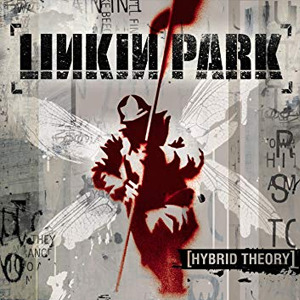
#2 - Hybrid Theory
I put more time into ranking numbers 2 and 3 than I’m willing to admit. Both of them completely took over my CD player when released and both had a large hand in shaping a portion of my emotional growth. Hybrid Theory was edgy, it was cool, it was smarter than its contemporaries and with its laser-sharp production, it commanded respect. Sure, was it angry white-dude music? Yes, but the anger and aggression came from points of weakness and believable vulnerability. I connected with Hybrid Theory so much, that 20 years later I find it hard to even speak critically of it. Its flaws are features, its signs of age help ground my own personal growth. Speaking on a personal level, Hybrid Theory MIGHT be my album of the decade. So to try and place it into the context of a ranked list is nearly impossible. Un-luckily Chester Bennington’s death helped lock in the top three of this list in ways I would have never predicted.
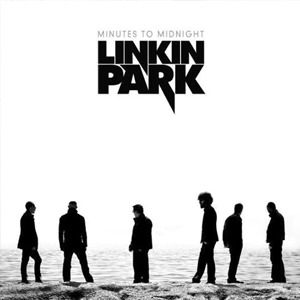
#1 - Minutes to Midnight
By 2007 I was all-in, LP was MY band. When Minutes to Midnight was released I was first-in-line buying the ultra-special edition. Unfortunately at the time I just didn’t get. Like, I owned it, I just didn’t GET IT. Musically it was the next logical step in the evolution of the band and Rick Ross’ looser somewhat dirty production was a welcomed departure from the more polished Don Gilmore albums. However, for the first 10 years after its release, I thought of Minutes to Midnight as a bit of a disappointment. It’s probably 2 tracks too long, Shinoda’s singing was a bit off-putting and unlike its predecessors, it didn’t feel cohesive. Sure “What I’ve Done”, “Given Up” and “No More Sorrow” were and are some of the biggest and best anthems the band has ever recorded, Outside of that the album just felt hollow.
In 2017 Chester Bennington ended his own life. At that point, my love for Linkin Park was still alive, but my interest in them had waned a bit. Chester’s death sent me into a music-hole like I had never experienced before. For weeks all I listened to was LP’s albums back to back. Chester’s words meant more than ever and out of that deep dive came an appreciation for Minute to Midnight I could never see coming. Songs like “Leave Out All the Rest”, “Shadow of the Day”, “Bleed it Out” and “The Little Things Give You Away” came to life with an emotional vibrancy I had never seen before. LP is at their best when they are swinging for the fences and Minutes to Midnight is them hitting grand slam after grand slam, with a few strikeouts sprinkled in. It’s flawed and beautiful, and that’s kinda the point. It’s LP’s most personal and human album, and that’s why it's at the top of this list. Prior to my 2017 revelation, it might have hovered somewhere between #’s 2 and 4, but in 2020 Minutes to Midnight is #1 with a bullet.
#linkin park#Mike Shinoda#Chester Bennington#minutes to midnight#hybrid theory#meteora#the hunting party#a thousand suns#one more light#living things#ranked
1 note
·
View note
Photo
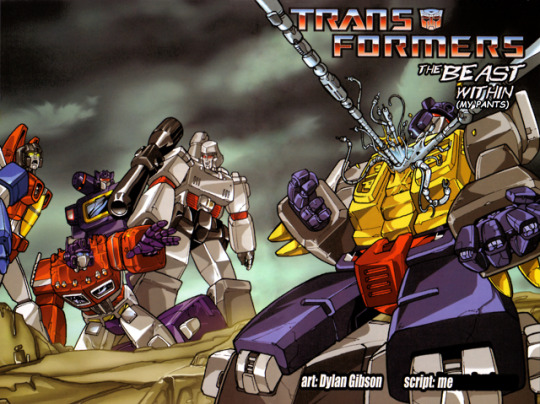
I rewrote the most infamous Transformers comic of all time.

I wanna give fair warning here. See, when I started working on this comic, I wasn’t really expecting it to turn out quite as dark as it did, and I suspect neither are you. After all, this is The Beast Within, right? The story where Grimlock goes crazy and talks in Comic Sans? How bad can things get? It turns out that - with just a few decisions made in poor taste - the answer is “very”, to the point where I feel the need to stick some kinda content warning at the top of this post. Unfortunately, I also feel like I’ve got a responsibility to the story, and there’s no way for me to do so without ruining it, so this is the best you’re gonna get.
This isn’t the first time I’ve made a comic like this. All the way back in 2016, I made “its christmas... so what??”, a kinda-bad re-lettering of a four-page ‘80s Marvel comic called “The Night the Transformers Saved Christmas”. I wasn’t too happy with the result, so half a year later I tried again - producing “PASS”, a re-lettered version of an obscure six-page UK-exclusive Marvel comic originally titled “Peace”.
“The Beast Within (My Pants)” is quite a different, uh, beast.
Each of the three comics I’ve produced was intended to be the last of its kind - standalone, yet fitting into the same overarching continuity. You can read any one of them alone, or you can read all of them in the order I made them. They’re individually available as albums on Imgur at the following links:
“its christmas... so what??”
“PASS”
“The Beast Within (My Pants)”
Alternatively, you can download the whole set as .cbz files - renamed .zip archives of images which you can open with a standard comic book reader.
It’s not too late to turn back.
Still with me? All caught up? Good. You’re probably wondering what the hell I was thinking...

I. I Have Summoned You Here For A Reason
Our story begins all the way back in 2004. The UK company Metrodome, looking to spice up their DVD box-set releases of the original ‘80s The Transformers cartoon, hired some local talent in the form of Mr. Jamieson (owner of a then-notable fansite) to write up some bonus features. They also commissioned him to write a mini-comic to be packed in with the set - with art by Mr. Gibson, a self-proclaimed fan since childhood with seemingly no other ties to the franchise.
The comic wound up being published in two parts (the second being subtitled “Consequences”) across the “Season 2 Part 2″ and “Seasons 3 and 4″ box sets. As a kid, I actually owned the latter of those box sets, and would watch it almost religiously - to what I can only assume must’ve been great annoyance from my poor parents - but I have no memory of it including a comic of any kind. Maybe it did, but it got separated at some point, and is lying around in some forgotten folder. A damn shame, that is. No, seriously.
I’m sure some record of the fan response at the time exists out there, in the doldrums of one of the many hard-to-search often-defunct forums which existed back then. I can’t really be bothered looking for it, sorry. You’ll have to content yourself with this TFWiki talk page for “The Beast Within” from mid-2007, which speaks of “Consequences” in hushed tones - as though it is a fabled artifact, prophesied to bring about Armageddon.

Another record - this one from 2009 - comes in the form of an eight-page TFW2005 thread ominously titled “Anyone afraid of the Dinobot combiner?” If you’re reading this commentary, you’re already strapped in for the long run; I recommend reading the thread in full. Well, okay, I don’t: it made me wince throughout, and I’ll be explaining the salient bits here, so there’s really no point subjecting yourself to it.
User “Razorrider”, after reading the TFWiki article on the Beast, opened the thread, noting “I don’t feel afraid of him myself.” The reactions soon started to pour in - some agreeing that the design was in fact “awesome”, others describing it as “hideous”.
Just going off my own personal opinion here, I think it’s fair to say that effectively nobody on the first page of the thread had any idea what they were talking about - and the pages that follow fared little better.
I think the main issue stemmed from the fact that a lot of those users didn’t think to explain the metrics by which they judged a “good” design (or, indeed, a “bad” story). When one person says “I think Optimus Prime has a good design”, they might just mean “I think he looks cool”, or they might mean “I think his proportions and colours give him a heroic stature which reflects his personality”. In that sense, a “good design” is one that communicates aspects of a character visually, even if it’s ugly. The Beast is hideous, yes, misshapen, yes, and it looks like the result of a teleportation accident, fine - but those are all intentional design decisions that perfectly reflect the nature of the character. In the foreword to the first part, Mr. Gibson notes the following (you’ll have to imagine that it’s written in Comic Sans for yourself):
Creating ‘The Beast’ was probably the most interesting aspect of the project. I wanted him to be a grotesque, twisted character that contained the design elements of the Dinobots he is created from.
People proclaim that the Beast “should never have existed” - a line from the comic’s narration, note - but somehow fail to realise that this is the comic’s own intent.
(Compare the Beast’s design to that posted by one user on the second page of the thread, which - minus an admittedly-inspired Triceratops-fist - just looks like an upscaled version of Grimlock.)
Okay, the alarm bells should be ringing in your head now. This is all starting to sound disturbingly like I’m some sort of The Beast Within apologist, isn’t it? How slippery is the slope that leads from “the Beast is a good design” to “The Beast Within is a good comic?” Have the hours spent poring over this thing in MS Paint turned my brain to mush, capable of only vague all-caps-Comic-Sans-penned ponderings?
...Well, yes, but- look, just stick with me!
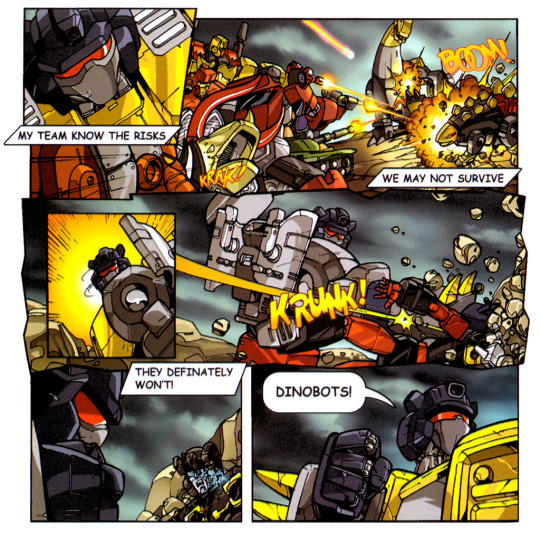
The most accurate recurring statement in the thread - though perhaps not in the way it is intended - is that The Beast Within reads like a work of “fanfiction”. See, Transformers is a franchise with an ever-growing history, and many of those who work on it now have been lifelong fans themselves. This is true of many franchises which have stumbled into the new millennium, finding themselves seemingly unable to die. We live in an age of fanfiction - yet some fanfictions are fanfiction-ier than others.
When compared to the likes of Star Wars and Star Trek and Marvel’s comics, one sees a marked difference in Transformers. Throughout the ‘80s and ‘90s, every story Hasbro put out seemed to fit vaguely into a single guiding narrative - each distinct strand of their multimedia barrage falling into contradiction with one another, yet still seeking to adapt some underlying premise. The 2001 series Robots in Disguise - in the West at least - saw a complete departure from that narrative. The ramifications of that strange borderline-afterthought cartoon cannot be understated, yet in retrospect feel like they’ve been a part of the franchise for as long as anyone can remember.
Almost every year since, Hasbro has effectively wiped the slate clean. Each new series tries to be its own thing. Continuity between series - if it exists - is understated, ignored, or overwritten. To date, this is still something that confuses us geeks; so used are we to the mired pits that are the canons of Star Wars and its ilk. This can be frustrating - there are only so many times one can retread the same story - but so too has this rare cycle allowed authors to really explore the concepts and themes presented by the premise of “car robots” to a level of depth which I believe is simply unattainable in franchises which adhere stringently to a single narrative.
That’s the bright side.
In practise, many Transformers stories have become increasingly myopic - existing only in service of themselves, or (more often) in service of older (better?) stories. The single most influential of these stories is almost certainly 1986′s The Transformers: The Movie, and it’s that influence which is felt most strongly in The Beast Within.
Of the countless insights offered by Terry van Feleday - if you don’t know who that is, don’t worry, I’ll explain later - I find that this one rings most true:
When Optimus Prime du jour mouths off “One shall stand, one shall fall” for the twentieth time, there is simply no longer that understanding that he will not be the one who stands.
Where so many modern Transformers stories are misguided recreations of the animated movie, The Beast Within is a reaction to it. But we’ll get to that. First, let’s talk a little about the story’s artwork.
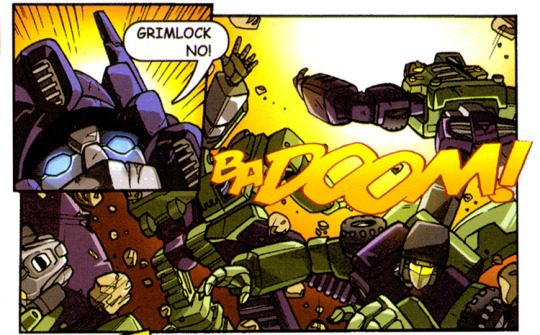
Mr. Gibson himself, I believe, deserves almost none of the criticism he’s received over the years for his work on this comic. Though his layouts are occasionally cluttered, and he does seem to have been trying a little too hard to emulate the style of Pat Lee (the man behind Dreamwave Productions; license holder for Transformers comics at the time) in the first part, his panels have a strong sense of energy and tone.
Though he didn’t exactly get to explore a broad range of emotions over the course of the comic, he managed to keep the characters expressive - always a challenge, when dealing with visors and mouthplates - and, crucially for a cast of this size, on-model. Look at the fury on Razorclaw’s face! The way Prime’s fist flies out of the panel! Menasor, torn in two! Predaking’s sundered legs! The mishmash of heads inside the Beast! The sickly colours of the second half! While it lacks the practised ease seen from some fans-turned-creators on more recent books, it’s still impressive work.
Regardless, Mr. Gibson’s first outing with Transformers proved to be his last. He didn’t end up getting paid work from Dreamwave Productions as he’d perhaps hoped (though in retrospect, neither did most of the people who illustrated for that company, so that was probably for the best). There’s no mention of The Beast Within on his personal website, which bills him as a “children’s picture book illustrator”, amongst other things. To put it simply, the guy’s always been a talented illustrator, and his style’s come a long way since this comic - the portfolio work on his website is very impressive.
(On a whim, I went back to late 2004 on the internet archive, and did in fact find the comic’s first spread buried at the back end of his portfolio. The entire website is a product of the early-2000s - there’s a link labelled “Go to Flash site” in the sidebar, though the page it takes you to sadly seems to have been lost to time. It all seems like it was borne of another age entirely.)

Anyway, let’s get back to that TFW2005 thread. The thing that makes it particularly notable is that, on the fourth page, Mr. Jamieson himself wades in to try and set the record straight. It goes about as well as you’d expect.
For a lot of people, I think, the idea of interacting with an author might seem strange. They’re aware of J.K. Rowling’s online antics, and are becoming increasingly comfortable with celebrity interactions on Twitter, sure. But there’s a difference between those kinds of interactions and the kind that take place on forums or in chatrooms - places where everyone’s on a level playing field. I come from those corners of the internet, and am lucky enough to have had conversations with lots of people who’ve made things I like, and have seen almost the full range of approaches those people take when dealing with their audiences. It’s safe to say that Mr. Jamieson’s approach in that decade-old thread is just about the worse one there is: over the course of just five posts, he smugly lashed out at the people in the thread, whipping them into a fervour that lasted for three more pages after his departure.
Regardless of whether or not Mr. Jamieson was correct - in the attacks he levelled at the other users, in the defence he offered for his work - there can be no question that this kind of behaviour is grossly inappropriate.
(Whether it is more or less appropriate than digging up old threads and archived web pages in an attempt to justify a bastardisation of a much-maligned comic book remains to be seen, I suppose.)
The key point that Mr. Jamieson kept returning to is that he sought to avoid the dreaded “info dump” (a hallmark of early Transformers stories), and didn’t want his readers to be “spoon fed”. A recurring criticism of the story is that it seems to begin halfway through, with little explanation for what’s going on - but I, like Mr. Jamieson, don’t think that complaint holds water. The Beast Within begins “in medias res” because we already have the context: eighty issues of a comic, ninety-eight episodes of a cartoon, and - crucially - a movie. Everyone knows the story of the Transformers, because the story of the Transformers - ironically enough - never really changes. “Is it ever really over, Jetfire?”
(That’s the last line of the original version of The Beast Within, by the way. I had to add the comma in myself.)
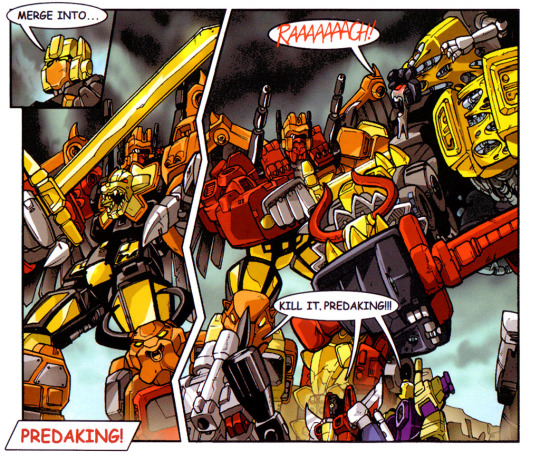
Like the impact of Robots in Disguise, the impact of The Transformers: The Movie is kinda hard to see unless you were there at the time - and I wasn’t - but in 1986, it did something which was profoundly shocking to thousands of children: it introduced them to death.
That’s about all I’m going to say about the movie itself, because much more experienced critics than me have already mined it for every ounce of subtext. I’ve already quoted the work of Terry van Feleday, who did some excellent scene-by-scene analysis of the film in a thread all the way back in 2010 - and I’ll come back to her writings a few times in this post. This very year, sorta-famous YouTuber hbomberguy released his own long-form take on the movie - what I find interesting when comparing the two interpretations is that van Feleday struggles to find much merit in the movie outside of its opening, while hbomberguy employs a reading that allows him to be much more optimistic and charitable even towards the end of the movie.
In a way, I think Mr. Jamieson had an intuitive subconscious understanding of the subtext which both of those critics later brought to light, an understanding which directly informed the premise of The Beast Within. In the same way one can read the monster planet Unicron as a physical manifestation of death, so too can one view the Beast - and Mr. Jamieson (almost certainly unconsciously) posits that, although death does not belong in a children’s cartoon, it is an inevitability that all children must eventually face. It is the dark spectre that lurks beneath the surface of every childish thing made by an adult.
An author places some of themselves in a book - but the reader withdraws something of their own perception as well. I wondered what I might see in the book: a child believes a lie because they know no better; a grown adult sees the lie because it fails to line up with experience. In this way, a child’s story could be so many different experiences. With enough subtext, a thing made for a child becomes an entirely different world to an adult. [...] There’s no telling when subtext will defeat the facade of a thing.
(I’ll tell you what that quote’s from later.)
I wonder, perhaps, if the endless swathes of edgy reimaginings of children’s stories are something of a mass outcry from those who grew up being told - every Saturday morning - that when people got blown apart, they’d be put back together by the next week’s end. What was it like for those children, in December of ‘86, to learn that some people could never be rebuilt?

II. It Pleases Me To Be The First
It occurs to me that I never did really do a commentary on “its christmas... so what??”, although I did talk about it a little in the commentary for “PASS”. Its title is a reference to the famous (well, you know what I mean) cover of “Stargazing” (issue #145 of the original UK run), which featured a banner reading “IT’S CHRISTMAS!” over an image of Starscream, arms out, yelling “SO WHAT?”
(Side note: at first I thought that I hadn’t read that particular story, but it occurs to me that as a kid I used to borrow a lot of Titan Books’ reprints from my local library - and I do in fact have distinct memories of reading Transformers: Second Generation, which did collect “Stargazing” amongst other Christmas stories - so I guess I probably did read it, even if I don’t remember doing so.)
The Women’s Day comic is something of a curio, as explained in this excellent article (which reprints the comic - with its original text - in full). It’s basically the only US strip which was published outside of the eighty issues of the run proper. This rare, standalone nature is something I have sought across every re-lettering I’ve done - from the UK annual-exclusive not-by-the-usual-author set-in-the-future “Peace” to the UK DVD-box-set-exclusive set-in-an-ambiguous-cartoon-inspired-continuity The Beast Within. These works feel like they’ve been lost to time - and corrupting them feels like unearthing buried treasure (and smearing it in turds). But I’ll get to that.
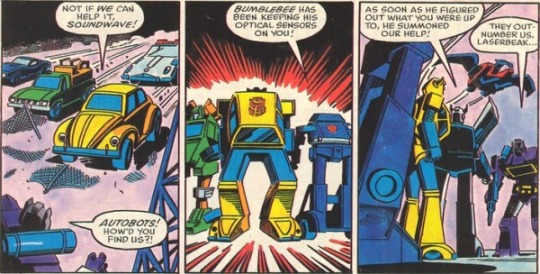
Back to “its christmas”. As I explained last time, I just went through the comic panel-by-panel and changed stuff to whatever I thought would be funny. I didn’t edit the two-line introductory blurb (which ended up informing the backstory detailed in the new set of AtoZ profiles). I barely paid attention to established portrayals of the characters beyond Soundwave’s association with music. I had no large-scale plans.
There’s a lazy (and poorly-conceived) gag where the little girl calls Bumblebee “gay” (also note that at the time, I misinterpreted the art in the third panel of the third page - I thought it was the girl speaking, when in fact it was her mother - leading to some erroneous dialogue), which in retrospect feels like a less-drawn-out version of the excruciating opening scene from Freddery McMahon’s Combiner Wars abridged special. That spoof somehow manages to be less funny than its source material, and I sometimes think that the same holds for my own creations.
Still, that’s not to say that “its christmas” doesn’t do anything that I like. I’ll admit that lines like “lol without mustard christmas will be CANCEL suck it nerds”, “toot toot here come some flutes”, and “help me drag it to the hospital” still kinda make me laugh. I like the way Bumblebee drowns out the little girl’s insults by tooting loudly at her. The final panels - wherein the humans steal Bumblebee’s blood as the other Transformers watch impassively - have an offbeat intensity to them, and when it came to writing Bumblebee’s AtoZ profile it was those which I chose to call back to.
If I had to sum up “its christmas” in a single word, I’d pick “childish”. The jokes, the characters themselves, the entire concept behind the comic - all feel kinda immature, and that was kinda by design. Summer Meme Sundae was a terrible piece of work, but - if I had to ascribe a theme to it - that theme would be growing up; realising that you’re running out of summer holidays. “PASS” and “The Beast Within (My Pants)” kept that atmosphere, but became increasingly cynical and obscene. That was just the natural direction they had to go in.

III. Every Place Reminds You Of Some Place Else
I’ve long had an idle fascination with abridged series, and have toyed with the thought of making an abridged series of my own. Most notably, I’ve long fancied the idea of abridging Machinima’s Prime Wars Trilogy of Transformers cartoons. Here’s an extract from a message I posted in Allspark Chat (the Discord server associated with the Allspark Forums):
I'd probably try and keep Megatron mostly the same as he is in the show as it is. Optimus'd be kinda murderous - you can tell he can't wait for Rodimus and the rest of the Council to kick the bucket so he can retake unilateral control over Cybertron. I'd maybe try to go for something of a more sympathetic Starscream - he wouldn't actually have any plan, he just has Cybertron's interests at heart and ends up trying to use the Enigma solely to rid the world of Megatron and Optimus forever. Windblade'd maybe be trying to force some hero's journey stuff - picking fights with progressively bigger opponents in a misguided attempt to prove her narrative worth
As pitches go, it’s not much. It doesn’t help that, as I previously mentioned, Freddery McMahon himself - pretty much the only name in Transformers abridging - has already tackled the series; his style of parody isn’t really to my taste, but his production value is fairly impressive and would largely overshadow any improvements I made on a script level. I feel like the Prime Wars Trilogy has potential, because it’s a fascinating piece of media, but I find myself unable to answer the question of how to parody something that already feels so much like self-parody. Sound familiar?
By the time the last entry in that series - Power of the Primes - was wrapping up, I'd been posting semi-frequently in the Allspark’s threads with a borderline-apologetic tone. Takes included:
The emptiness of Cybertron lends it a Beast Machines-esque tone
The Mistress of Flame’s death is cathartic
You can see right through the script
I want to get off Machinima’s wild ride
Wow, Windblade sure screams a lot, doesn’t she
The finale of Titans Return is good, actually
Hearing Megatron say “piss me off” is an unpleasant surprise
Hey, this soundtrack’s pretty good
Wait, no it’s not, but Galvatron’s implied reversion to Megatron is
Narrative emergence gives rise to Buddhist allegories in TFTM
Grimlock acts like his cartoon self - but only around friends
Okay, for realsies, the soundtrack’s good now
They’re right to kill Sludge; he’s the least toyetic Dinobot
I’d probably describe a lot of what I saw in the Prime Wars Trilogy as a kind of narrative pareidolia - only instead of seeing faces in inanimate objects, I was seeing value and meaning in an indefensible web series.
The problem with abridged series is that they require a ridiculous amount of effort. You need to be a good writer in the traditional sense, but you need to be able to work around the visual material available - you’re gonna have to edit everything yourself, you’re probably gonna need to do custom animation, and you’re certainly gonna need to wrangle a cast of voice actors. All of that for ten minutes of animation that’s probably gonna get taken off YouTube within ten minutes of upload. It’s just not feasible - and yet there’s part of me that loves the idea: commentary and content, all rolled into one.
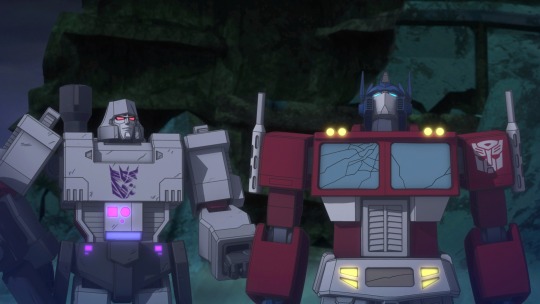
To pretend that it was Combiner Wars that led me to create “The Beast Within (My Pants)” is a little misleading, however. The real answer - I’m sorry to say - has more to do with ponies.
See, every now and again I get very acute nostalgia for My Little Pony: Friendship Is Magic, which was perhaps my first brush with fandom - or at least, proper fandom. It’s heard to measure these things, y’know? Anyway, when that happens, I realise that I don’t really want to sit and watch a cartoon for little girls, so I usually just listen to some fan-made music or - as was the case last time - rewatch one of the abridged series based on the show. I use the word “series” here in plural because there were in fact two (well, two that matter): Friendship is Witchcraft and The Mentally Advanced Series. There’s long been quiet debate over which of the two is the (soundwave) superior series, and I’ve historically believed that they’re (buy some) apples and oranges. The latter is a more thoughtful parody of the source material, while the former is more polished and standalone.
However, after blitzing through Friendship is Witchcraft once more in its entirety over the course of a couple of days, something about it clicked for me - a bigger-picture thesis - and I realised that it had much more to say about its source material than I (or, well, most people) had given it credit for. It was at that moment that I felt the awful urge to create a My Little Pony fanwork of my own.
(The quote I used earlier, about subtext in children’s stories, was spoken by Princess Celestia in Rainbow Dash Presents: The Star in Yellow, a Mentally Advanced Series special inspired by a fanfiction which, fittingly enough, was written by Matt Marshall (AKA Blueshift/blue/Yartek/RockLordsRock), who was also the man behind the infamous “JaAm” relettering which effectively inspired all of these projects of mine. It’s like poetry.)

As we’ve already established, making a fancy-schmancy animation was out of the question - but a crudely-edited-in-MS-Paint comic was the next best thing, clearly. I started glancing through IDW Publishing’s official My Little Pony comics - having purchased a few in a Humble Bundle many years ago - but, aside from a couple of promising stories, quickly realised I didn’t have much hope. The comics are just, to put it frankly, not as good or as interesting as the show, and the fact that I’d need to adapt at least two issues at once (over forty pages) to tell any complete story made doing so an unappetising prospect. Furthermore, IDW’s comics are still very much in print, and (as the abridged series show) any such parody would stand on shaky legal ground.
Seeing as I wasn’t about to delve into the dark realm of prose any time soon, and the idea of messing with some other fan’s work rubbed me the wrong way, I decided to give up on my equine dreams and instead turned back to more familiar territory. I glanced over the list of old Transformers Marvel comics, but nothing like those I’d previously relettered stood out to me. I perused the short stories included in Dreamwave’s 20th Anniversary Transformers Summer Special. I even looked into some Fun Publications stuff. Nothing sparked my interest.
Perhaps my most promising lead was “An Arcee Sort of Day”, a vaguely-maligned (as in, “meh”) three-page standalone comic released mere months ago by IDW as part of an anthology - but the poor resolution of the available scan (the comic had been released in its entirety as part of the free preview for the anthology) meant that editing it would be a nightmare, and there was very little in the way of dialogue for me to mess with besides. More than that, the idea of directly mocking a comic from a compilation designed to showcase female creators (particularly one featuring Arcee, who’s been a controversial character in recent years) struck me as tasteless in the extreme. If only I had an easier target!
Oh wait, I did.
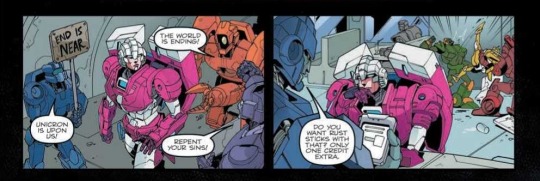
IV. Let The Slaughter Begin
If I actually ever read both parts of The Beast Within before starting work on this project, I don’t remember doing so. I do remember reading the Beast’s TFWiki page when I was much younger, and remember feeling like the wiki’s take on the concept seemed disproportionately harsh. To be honest, it was quite vindicating to read the source material and discover that I still agreed with my younger self’s assessment - the problems with the story are not on a conceptual level, but in the execution.
I barely gave myself time to digest the story before diving in and working out how exactly I could mess it up. I knew from my previous comics that the Autobots would all be unrepentant shitheads, so the natural choice was to portray the Decepticons as favourably as possible. Where the Autobots are callous, poorly-spoken, stupid, and divided, the Decepticons would be caring, articulate, intelligent, and united. In the story’s context, these traits would be weaknesses: remember, only the Beast has the killing instinct needed for decisive victory in this endless children’s story. I also knew that everybody in the story would hate Grimlock, and that - unlike with Roadbuster in “PASS” - they’d be right to do so.
That was pretty much the extent of my planning. I gathered up all the pages and started clearing out the text from the speech bubbles. Already, I had something of a problem: the use of the infamous Comic Sans MS font in the first part of The Beast Within was one of its most iconic features, and I wanted to retain that, but my own previous reletterings had canonically established Times New Roman as the “voice” of the Autobots. In fact, as far as those older comics were concerned, Times New Roman was the voice not just of the whole Cybertronian race, but also of the narrator.
The only lines which used a different font were those where I’d chosen to retain the comic’s original lettering, and with Roadbuster’s dialogue. It’s hard to articulate what exactly the joke with Roadbuster was - he seemed like the odd-one-out in the opening panels of the story, so I ran with that by having him be persistently ostracised by the other Autobots. The twist, as you find out when he finally speaks, is that he seems to be the only Autobot who’s unambiguously a good person; the rest bully him for effectively no reason.

In the commentary for “PASS” I released earlier this year, I explicitly ask:
If these are the Autobots… then what were the Decepticons like?
My own gut feeling was, I think, that they were people like Roadbuster - genuinely good individuals who never wanted a fight - and so for this comic I knew I had to give them Roadbuster’s Arial voice. I also knew that I’d have to keep the Autobots’ Times New Roman voice for the most part. The only question, then, was what to do about Grimlock, the combiners, Jetfire, and the narration.
(It’s worth noting that Soundwave and Triton were both Decepticons too, yet they both spoke in Times New Roman. The Doylist reason for this is simply that, at the time, I was happy to have everyone share a voice. In Triton’s case, the Watsonian reason is that he’s trying to mimic the Autobots’ “accent” to better fit in. If I had to make up a reason for Soundwave, I’d say that he’s only recently defected from the Autobots, as a reference to van Feleday’s insane Soundwave-as-an-ex-prisoner-of-war theory. Had Soundwave had a speaking role in the comic, I’m sure I would’ve explored that backstory in his AtoZ profile - but alas, it wasn’t to be.)
In fact, there was initially some ambiguity over who the comic’s narrator would be - if I used Times New Roman, would I have to keep the voice of the same narrator as in the previous two comics? In the end, I decided to draw from my source material: the on-panel narration would be Grimlock’s inner monologue, rendered in full Comic Sans glory, while the "Interlude” would employ a more omniscient third-person voice. That third-person voice is, I think, distinct from the narrator of the previous comics, and feels like a more solemn version of the narrator of the AtoZ profiles I released alongside the commentary for “PASS” (or, indeed, the latest batch included here). Remember, I wrote the first two comics years before all of this recent material. More on the text-only pages later.
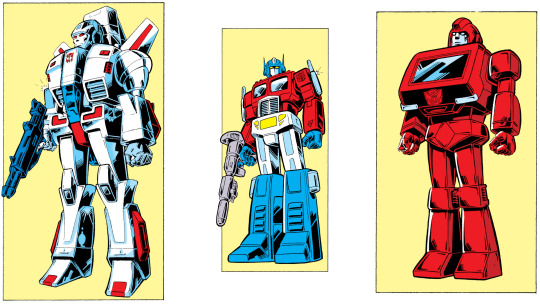
When he speaks out loud, Grimlock uses the regular Times New Roman of the other Autobots. In fact, the only dialogue which uses Comic Sans is that of the Beast, which I view as the true externalisation of Grimlock’s feelings. You can also view it as the “real world” (as depicted in the text-only pages) leaking through into the comic’s reality, in much the same way that an aware-of-death adult perspective seeps through into a seemingly-innocent children’s cartoon. The other combiners simply use a slightly bigger font than the individual Decepticons. Oh, and all of the combiners use red text.
In the original toyline, Jetfire was something of an odd-one-out, as he was really a Macross “VF-1S Super Valkyrie” toy licensed by Hasbro from Bandai (who had in turn purchased the molds from the recently-bankrupted Takatoku toys). Both Whirl and Roadbuster have similar origins. I was under no obligation to do anything special with Jetfire’s dialogue, but because of the way he’s introduced in the comic - and as a nod to his shared real-world history with Roadbuster - it felt right to give him his own voice. Though he still uses Times New Roman, the font is scaled up and he speaks entirely in capital letters. His dialogue was a challenge to write, as most of his speech bubbles are very small, but I think this worked out in my favour: his speech often ended up butting up against the bubbles’ outlines, giving the impression that he’s always speaking just a little bit too loudly.
The lettering in the first part of the original comic - aside from being technically legible - is generally shoddy on every level. For emphasis, it alternately uses italics or inconsistent font size. Occasionally, the dialogue switches to lowercase, which kinda gives the impression that everyone’s been shouting the whole time. Most of the text is left-aligned. Some bits of text seem to have been squashed. Most of the narration boxes are parallelograms, but some are plain rectangles. Red hand-lettered text is mostly limited to the combiners’ speech, but also sees use a couple of times for Megatron and Optimus Prime. Some of the combiners’ speech just uses normal red Comic Sans MS text. Meanwhile, the second part switches entirely to black hand-lettered text - presumably from Mr. Gibson - which is a marked improvement in terms of tone and consistency, if a step down in legibility.
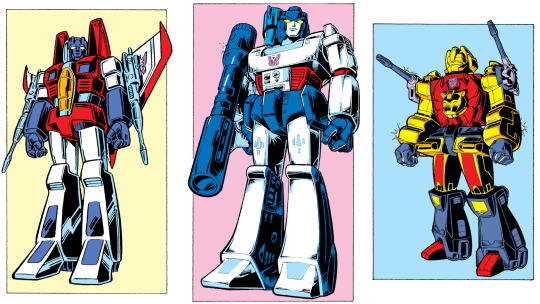
It’s interesting to me that, despite my version of the comic sharing the dearth of commas and full stops which plagues the original, it reads very differently. For all its stylisation, it’s my hope that each line I write for these comics comes across realistically - not in the sense that it’s something you’d hear someone say, but perhaps in the sense that it’s something you’d maybe read on the internet. More on that later - first, some miscellaneous notes on the comic’s text:
When I first wrote it, I used the style of self-censorship from “PASS” (and, by extension, the rest of Summer Meme Sundae) wherein the first letter of any curse is replaced by an asterisk. It was one of my prereaders, Tindalos, who noted that “the censoring kinda takes a bit from it”, and I decided that I agreed with him - it felt like I was holding back. You can decide for yourself; I’ve collected the pages with lines that were revised between drafts in an album.
Through pure coincidence, it’s Springer (well, Bulkhead) who gets the first line of dialogue in the comic - just like in “PASS”. In case it’s not clear, the joke is that he thinks he’s safe on the floor and berates Jazz for not doing the same thing, seconds before getting stomped by Megatron. I think this sequence perfectly encapsulates a big part of what I wanted to show about the Autobots: they all criticise one another relentlessly, despite being deeply flawed themselves. It’s a dynamic that, to me at least, actually evokes that of the Autobots in Michael Bay’s movies.
The line “thats me grimlock in the corner losing my religion” is, of course, a reference to R.E.M.’s song “Losing My Religion”, which was itself included as part of writer James Roberts’ “soundtrack” for More Than Meets The Eye. Though he did not appear in the issue for which Roberts selected the song, Grimlock was a recurring character in that series. Hopefully my depiction of the character surpasses that one - though if you ask the people I usually talk to, I wouldn’t be setting the bar particularly high with that comparison.
Optimus uses the insult “grimdick” shortly after Grimlock’s narration provides the example “grimcock”. I intended this to show that, while the dynamic between the two’s been cemented for a good while, Grimlock is always a step behind and still can’t predict Prime’s actions.
Snarl’s line was originally “hey speak for yourself swoop me and grimlock are tight as *hit”, which expresses effectively the opposite sentiment to his final line. The idea that Snarl was okay with becoming part of the Beast was intended to add a bit of brevity to the sequence - but I decided it was better to keep as much emotional impact as possible in the moment.
A more minor change a couple of pages later is Grimlock’s line “how do they do it”, which replaced “love is stupid”. I wanted to expressly draw a parallel between the Beast’s combination and Predaking’s.
The line I’m happiest with is “eat shit megatron this is what you get for being such a fucking weapon”. One of my friends occasionally cracks out the word “weapon” to describe someone - and what better application for it is there than a guy who literally turns into a gun?
Megatron’s line about the “black hole” in Optimus Prime’s spark is a twist on Megatron’s own canonical link to a black hole - an aspect of his original bio which was revisited by Roberts.
I struggled to think of Menasor’s final words. The longer I stared at the panel where he gets torn in half - from which I’d already cleared the speech bubble - the more I was struck by the emptiness of the scene. If one considers Menasor to be a symbol for the Decepticons as a whole, then his silence in that panel is my way of showing that - from this point forth - the Decepticons no longer have a voice; the second part of the comic shows naught but their corpses. Death exists, and nothing is good any more.
None of the text on the final page of the first half remained unchanged between drafts. I wan’t happy with Optimus Prime’s original line at all, and the internal monologue “don’t you deserve happiness” felt a little too serious. The phrase “no u” is the archetypical low-effort comeback, and seemed like the perfect beat to end the first part with.
Prime’s line “gotta jettison some dead weight” is a nod to Astrotrain’s iconic line in The Transformers: The Movie: “Jettison some weight, or I’ll never make it to Cybertron.” I had to check for the exact quote just now and found “jettison transformers the movie” in my search history, so obviously I’d done the same when writing the panel. More than just being a trite reference, I was hoping to draw an obvious parallel and to contrast the unilateral decision Optimus Prime makes on the following page against the more shall-we-call-it-democratic process the Decepticons used in the movie.
I’m probably a little too proud of “big red irredeemable fucking monster of a robot semi fuck”, which is a line that could absolutely only exist in this travesty of a comic.
Jetfire’s use of the phrase “GOTTA BLAST” is a reference to a line spoken by the titular character of the early-2000s CGI cartoon Jimmy Neutron: Boy Genius, one which has turned into something of a meme. When I wrote the panel, I intended to imply that Jetfire was aiming to crash into the city - but I think it ended up doubling as foreshadowing for the fact that Jetfire flies his passengers into the sun. Additionally, the meme often sees use as innuendo, which shines through in the following panel: Jetfire expels propellant into the Beast’s face while Bumblebee remarks “gah okay i did not want to see that”. The less said about the sound effect “CHOOOM!”, the better.
Remember how all the text in the first part of the original comic was left-aligned? So’s the text in my version! MS Paint simply doesn’t have the option to change the alignment of your text - I actually had to throw in extra spaces at the start of each new line, eyeballing things until I had an approximation of centre alignment. This is something I never did with “PASS”, and I found that doing so gave me more freedom to squeeze more stuff into the speech bubbles.
As immortalised by countless memes, you can’t rotate text in MS Paint either. I tried to use this to my advantage on the comic’s first page, where the steps between the words in Grimlock’s narration give them a faltering quality.
Grimlock’s narration actually ended up being one of the most challenging parts of the comic to write. I wrote a draft of the first page pretty quickly, but decided I wasn’t happy with it and that I’d have to replace it later - which I did, but only after having written pretty much every single other bit of dialogue.
I think the central conceit of “PASS” - that somebody’s farted and the Autobots are trying to find out who dealt it - didn’t solidify until I reached the second page and looked at Rodimus Prime’s body language. In much the same way, the crux of “The Beast Within (My Pants)” didn’t solidify until it came to writing Swoop’s line.
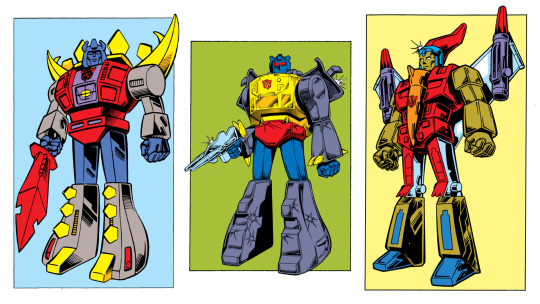
V. Me Grimlock Not Nice Dino
At some point during the creation of “The Beast Within (My Pants)”, I started thinking a lot about incels.
(To be clear, this is the part of the commentary where things get a bit weird, and I start talking about storytelling decisions which I think were made in poor taste but which I don’t think come across overtly in the comic itself. Feel free to skip ahead to the next section. Or, y’know, stop reading entirely.)

Grimlock is childish, despite his age, and is desperate to be liked - no, respected - at any cost. His only asset is his BRUTE STRENGTH. He hates Prime, but wishes he was Prime. He has trouble treating any of the other Autobots like people. He rages against an outgroup whose ideals are - at least ostensibly - rooted in empathy.
I wouldn’t say “I wrote a comic where Grimlock is an incel”, because that’d be a pretty stupid thing to write and I’d feel pretty stupid saying it.
Looking back at a lot of my previous work on this blog, some things do crop up again and again. In abstract, I’d say that the idea of a character seeking friendship and/or respect - and failing to understand why they can’t find those things - is one that I’ve revisited a couple of times. This was a strong theme in the latter half of Another Son - a story which dealt heavily in misanthropy - which featured a character inspired by Sam Witwicky from Michael Bay’s Transformers. The protagonist of Retrace Steps spent the whole story unable to even ask the question “why am I alone”. Many of the characters in Are You Happy - particularly Mr. Hernandez - deal with similar problems to varying extents.
So this makes, what, practically four stories in a row? I didn’t set out to approach things this way again with this comic, but from the moment I wrote Swoop’s line I knew I didn’t have a choice. When people talk about the Beast’s combination sequence, they talk about how violative it appears. Metal tentacles spring from Grimlock like one of Alien’s chestbursters, penetrating or melding with the other Dinobots’ bodies. After that, the resulting monstrosity ambles around, horrifically murdering its former peers. As much as I can have the characters in the story play this stuff off for laughs, I’ll never be able to erase the undercurrent.
This isn’t supposed to be a direct mapping - a perfect metaphor - and by the time this commentary’s done I hope I’ll have pointed in the direction of some alternate perspectives. It just seems important to put my cards on the table and say that, when I was working on this comic, this is the kinda thing I was thinking about. We thought children were safe with Transformers, and then a gun came and shot people they cared about, and for some reason we were surprised to see that they got upset.
With all of that in mind, I take some solace in the fact that I actually found getting into Grimlock’s head to be extremely difficult. His dialogue was a breeze to write, sure - that’s the outsider’s perspective - but actually trying to construct his thoughts in anything approximating a convincing manner was very difficult. The first draft of his narration literally included the phrase “we live in a society”.
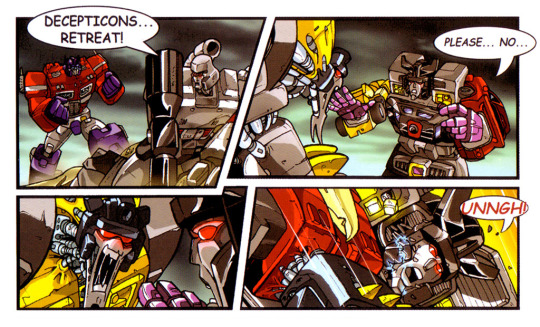
VI. Such Heroic Nonsense
I’ve already touched on Terry van Feleday’s opus a couple of times, but I think it’s worth delving a little deeper into how exactly her analysis influenced this comic. For some reason the idea that nearly five-hundred pages of borderline-conspiracy-theorist-level ramblings about perhaps the most maligned movie franchise of the 21st century might be a tough sell is one which I can’t quite wrap my head around. I’d say that it’s because I’ve read the thing and already know that it’s good, but in truth I was pretty much sold from the moment I found out it existed.
Anyway, I frequently get into not-quite-arguments with internet strangers about Transformers, and during those discussions I frequently find myself saying “a good Transformers story should do X”, and then I have to resist the urge to add “like Michael Bay’s movies” because doing so would completely delegitimise the point I’m trying to make. The problem is that, because I’m deliberately omitting the context of my opinions, they come across as being even more bizarre.
I think that same problem exists in some capacity with this comic, where I’m drawing on sources which are intuitive to me but completely alien even to a typical Transformers fan. I’ve yet to even mention the other primary inspiration for this story, which is even more arcane.
Perhaps it’s important to stress that van Feleday doesn’t offer a typical "theres actually zero difference between good & bad things. you imbecile. you fucking moron" take. Rather - and I realise I’m about to butcher this - she shows how the humans in Bay’s movies give increasing amounts of power to an alien cult leader because their only alternative is to get wiped out by an alien warlord. So in terms of this comic, “Autobots bad” is very much rooted in her reading of those movies, while “Decepticons good” is just something I thought would be funny.
Well, not exactly. I’ve already mentioned Combiner Wars; something that continues to baffle pretty much everyone who watched that show (and its sequels) is that, while it seems to have no idea what it’s doing most of the time, its portrayal of Megatron is an absolute riot. He is absolutely the protagonist of that series, the Only Sane Man in a world of bizarre psychotic caricatures. I think the same kinda holds in the continuity of my comic, only he’s had more time to bring the people he takes in around to his way of thinking.
Let’s not forget the official “good-is-bad” continuity of Shattered Glass, which - while heavily compromised - was the source of many interesting reinterpretations of popular characters. Effective reinterpretations require you to forget what you know about a character and strip them back to the core signifiers, which you can then put to different use. One of the posters in Terry van Feleday’s thread, “Lobok”, observes:
I like the idea that Bay or the writers looked at Optimus Prime and thought "What would a guy who calls himself that really act like?" Imagine you knew or heard of someone, a human, who called themselves the equivalent of "The #1 Bestest Superior" or "King Supreme Ultimate" - do you not picture either a 7-year old boy or a mentally deficient oo-rah alpha male? Maybe the two combined? Seems much more apt than a wise, noble father figure.
Of the course, I don’t for a second think that Michael Bay had any such thought - but the connection still exists for the audience to make. Therein lies one of the greatest unspoken strengths of Transformers storytelling: the sheer breadth and depth of the signifiers at play. Much of what van Feleday did in her thread was to boil down the concepts found in Transformers stories to reveal those core signifiers.
(Almost a year ago, I wrote a piece for the Refined Robot Co. blog which explored some of her findings by delving into the subtextual meanings of the countless alternate modes worn by Megatron over the years.)
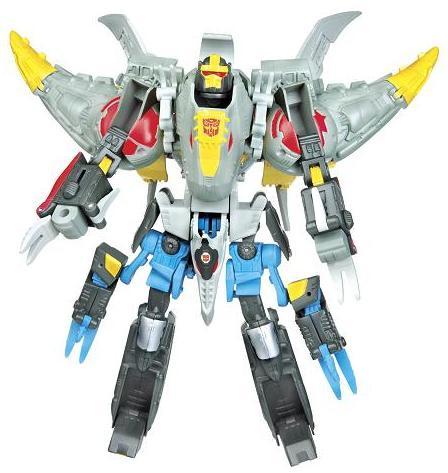
By the same token, I think there’s something to be said for the way Grimlock’s alternate mode ties into his portrayal in my take on The Beast Within. He turns into a dinosaur - something which is rooted in the past, extinct, unable to develop - while most of the other Autobots turn into modern vehicles. Kids may love dinosaurs, but they’ll likely grow up to have a stronger interest in cars or tanks. Grimlock is immature almost to the point of childishness; his beast mode is the lizard king, and he doesn’t understand why you won’t bow.
(Obviously I’m making some big generalisations here for the sake of a point - the other Dinobots have their own prehistoric disguises, and kids’ interests develop in varied enough ways that perhaps this link is only noticeable to those who experienced the transition I describe. When I was much younger, I was obsessed with dinosaurs, and would consume all the dinosaur-related media I could get my hands on. Eventually, however, my crippling fear of sea monsters led me to stop reading books about them - I'd turn the page, see a full-spread painting of a pliosaur taking a bite out of a pterodactyl, and shit my pants. Okay, no, that’s a huge exaggeration: more likely it just got to the point where I knew basically all of the cool dinosaur facts already, and suddenly the deep lore of the grim darkness of the 41st millennium or whatever seemed way cooler. I just find it funnier to imagine that my prosperous future in paleontology was averted for fear that I’d discover the last living specimen of a plesiosaur.)
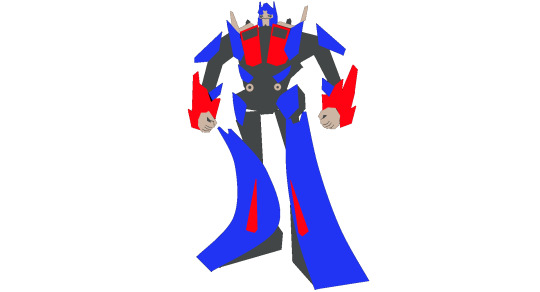
VII. Where’d You Learn To Talk Like That
Back in “PASS”, I think there was some question as to who exactly was the coolest dude; the biggest guy. Rodimus was in charge, but the others didn’t really respect his authority in the end. Although Triton was an underdog in that story, he wasn’t at the bottom of the pack - no, that role went to Roadbuster. Everyone seems to like Ultra Magnus, but it’s never really made clear as to why that is.
Grimlock’s personality and role within the Autobots was pretty much the first thing I solidified when it came to writing “The Beast Within (My Pants)”. I knew that he was the lowest of the low; the nail in every Autobot’s tyre. As Grimlock evolved, so too did Optimus Prime - the second-most-prominent character in the comic. "The #1 Bestest Superior" became a murderous jock, and the Autobots became his cult of personality.
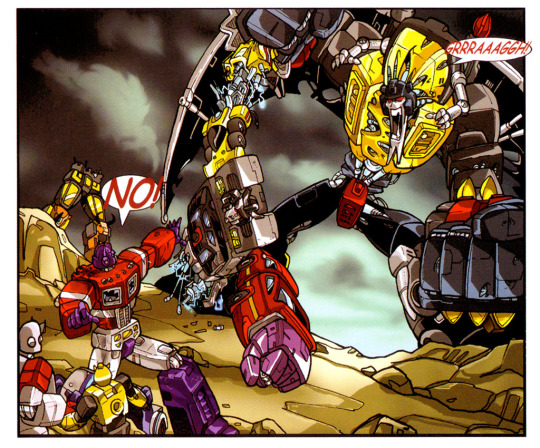
Speaking of cults of personality, I’ve been posting regularly in the Homestuck Discord server since November of last year. There’s no other place like it on the internet, and - truth be told - I’m not sure any explanation of it I could provide would suffice. The server was created by some guy called Makin - at least, we're pretty sure he’s a guy - who nobody’s ever met but who seems to have an uncanny knack for managing online communities.
Major events in that server have been comprehensively catalogued since July of 2017 by long-standing moderator “Drew Linky” in his journal Several People Are Typing. Between the entries and the related materials, it’s probably around half a million words in length. There’s no other document like it on the internet.
For the first fifty or so pages, Drew had no intention of making his document public. Apparently, one of the reasons he wrote it in the first place was as a way of holding Makin accountable - the guy used to be (and sometimes still is) a bit of an ass. Now, I wasn’t around in 2017, so I can’t really comment on the accuracy of the document’s early entries - but as a newcomer I was struck by how different Drew’s depiction of the server was to my own experience there. If I had to guess, I’d say his style of prose and the cherry-picked nature of the document make it seem like a much more hostile place than it actually is.
In particular, Makin effectively starts out as journal’s main villain (alongside various problem users and Homestuck creators) - a capricious and unknowable entity with absolute power over the server - and many of the entries deal in some way with what users jokingly refer to as his “redemption arc”. Of course, in reality, he’s just some guy, and everyone knows that real people don’t have character arcs.
I still haven’t finished reading SPAT, but I was doing so around the time when I was working on the comic. At some point I started to draw parallels between my bizarro version of Optimus Prime and the journal’s bizarro version of Makin, and I decided to play them up. Much of Prime’s dialogue is inspired by Makin’s style of speech, using phrases like “shut the fuck up”, “nobody cares”, “holy shit”, “get fucked”, “lmao”, “literally”, “literally [...] who”, “guys”, “rational” and “you’re welcome”. I just checked and at the time of writing, with the exception of “literally who” and “you’re welcome”, he’s used every one of those phrases within the last week. Oh, and while the word “suckers” isn’t really a Makin quote, in Homestuck it’s associated with the not-quite-biggest-bad evil empress. It bears mentioning again that the complete lack of punctuation in the comic’s dialogue mirrors the most common style of typing I see online, where people drop their capital letters and full stops.
(In fairness, a lot of us kinda talk the same way in that server. I remember one time Makin said “I also need to worry about lmao becoming some kind of anime catchphrase for me”, which cut pretty deep as I’ve been overusing that phrase instead of “lol” or “haha” or whatever for ages. Look, it’s just a funny word to me: in my head I pronounce it “luh-mayo” instead of “el-em-ay-oh”. Like “I throw my sandwich in the air sometimes / saying aaay-oh / I ordered maaayo...”)
In the comic, the self-aggrandising Optimus Prime is hostile and dismissive to those around him. It might all be a front, but it might not. Even though Grimlock hates Optimus, the Dinobot seems to agree with him a lot of the time, and the narrative itself never really manages to conclusively condemn his actions. The name “Optimus” echoes the word “optimise”; so frequently thrown around in rationalist circles. One could even go so far as to say that Optimus Prime’s ultimate goal in the comic is to kill death-in-the-form-of-a-shitposter.
In seriousness, I’m drawing these comparisons in a pretty tongue-in-cheek way. I don’t actually think that the Homestuck Discord server is a cult of personality - even if, to check the user-contributed “SPAT Epilogues”, some of its populace seem determined to behave like it is. Even if this section of this commentary exists. At the end of the day, I’m gonna write what I know, and I like to think that I know a little about online communities and what happens when they go wrong. I wish I could say that “The Beast Within (My Pants)” is a cautionary tale to that effect, but in truth I don’t think it offers any conclusive answers in the same way that “PASS” perhaps did. “Only worry about the opinions of people who actually care about you,” maybe? “Death is an abomination and we shouldn’t let it anywhere near our kids”, perhaps? “You can’t force other people to like you”?
“You can’t force other people to like the things you made”?
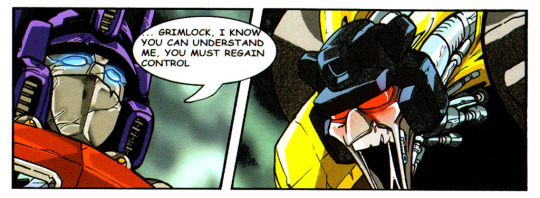
VIII. Burnt-Out Toaster Ovens
In the re-released version of “PASS”, it seemed right to throw in something in the way of extra content. I had fond memories of the Seacon profiles published alongside the original “Peace”, and lifted the format to create short bios for all sixteen characters who appeared in the comic. These fitted neatly on a four-by-four spread (though I ended up merging Topspin and Twin Twist’s profiles and throwing in an extra one for Computron, who did not appear in the comic proper).
From the start, I knew I wanted to do something similar for “The Beast Within (My Pants)”. In fact, I already had two text-only pages to work with; each part of the original comic was prefaced with a prose introduction and a note from Mr. Gibson. I decided that I could rework the text-only pages and add another spread of profiles, using the freedom granted by prose to explain away many of the comic’s oddities.

It took me some time to carefully erase the existing text from the scans that I had, using nothing but the brush tool in MS Paint. It took me even more time to work out some potential approaches to take with the text itself. Eventually, I came up with the following ideas:
A flashback depicting Grimlock and Swoop’s breakup.
A conversation between Grimlock and Jazz (or, perhaps, Slash).
“How Ratchet Got His Head Back”, the interlude which I ended up using.
A synopsis of events between “its christmas... so what??” and “The Beast Within (My Pants)”, which ended up being my first stab at the introduction.
Some in-character commentary as Mr. Gibson, which I did end up including.
From the moment I conceived it, I was pretty set on “How Ratchet Got His Head Back”, and it ended up being a breeze to write. I didn’t end up getting a chance to squeeze in the title - a reference to an issue of More than Meets the Eye - as it didn’t really fit the original format of the page. The introduction, on the other hand, proved much more challenging. My main problem was that, were I to preface the story with a text page, I’d be asking them to read a bunch of probably-mostly-serious words before allowing them to read the comic proper. Not the best first impression!

Nonetheless, I gave it a go - you can read my first attempt in the album of the draft pages. It mostly served to lay out the continuity between my three comics. Rodimus Prime’s crew were abandoned on Cybertron by Optimus Prime (presumably Hot Rod changed his name in Optimus’ absence). Megatron, Optimus and their crews crash-landed on Earth, and millions of years later the events of “its christmas... so what??” occurred. Meanwhile on Cybertron, it took a few million years for the other Autobots to wipe out the remaining Decepticons, as seen in “PASS”. Humanity was wiped out by Optimus in retribution for their transgression (a nod to Mr. Gibson’s depiction of Earth as an empty wasteland), prompting the conflict seen in “The Beast Within (My Pants)”. Much of this timeline remains implicit in the final version of the comic.
When I wrote it, I was pretty happy with the way this information was conveyed in the first draft. It was the ever-ardent Gitaxian - one of my long-time prereaders - who made me realise just what a mistake I’d made:
Something was rubbing me the wrong way about that first prose page and I finally realized what it is / Expositing that Optimus is horrible right off the bat takes away a good chunk of the impact the comic had before you added it
He was right. My prereaders’ initial response to the comic was that Optimus Prime’s motivations were completely opaque, and I overcorrected, not realising that his inscrutability was one of the things that made him interesting. You kinda want him to behave like the Optimus Prime you know and love, but he keeps doing weird things and you never really find out why.
Suddenly, I was back at square one - no closer to having a clear idea of how to introduce the comic. Another of my prereaders, gearshift, had the solution:
It's Transformers or some shit. You've seen the cartoon right? The one with the tape guy? Yeah, the tape guy is barely in this one. What do you mean no sale? Look, fuck, it's got the dinosaur guy. He's right on the goddamn cover, you like the dinosaur guy right? Yeah, that's what I thought.
Bitch.
I liked her pitch because it seemed like it’d do a good job of filtering out readers who wouldn’t enjoy the comic. To quote Alexander Wales, author of Worth the Candle:
I kind of hate blurbs and taglines, especially for something so large and varied as Worth the Candle / My ideal synopsis would tell people what kind of story it was without actually telling them that much about the story; it would select for all the people who would fall in love with the story, and select against all the people who would find it a waste of time. / How to actually write that ... I've got no idea.
(Side note: I’m one of the people who fell in love with that story, to the point where I’ll use any opportunity to recommend it to others. It’s maybe my favourite thing written by anyone ever.)
A closely-related issue is that of content warnings: so far as I’ve been able to work out, there is no warning which I can give for “The Beast Within (My Pants)” which adequately selects against people who won’t like it while also preserving its conceptual twists and avoiding colouring the audience’s interpretation.
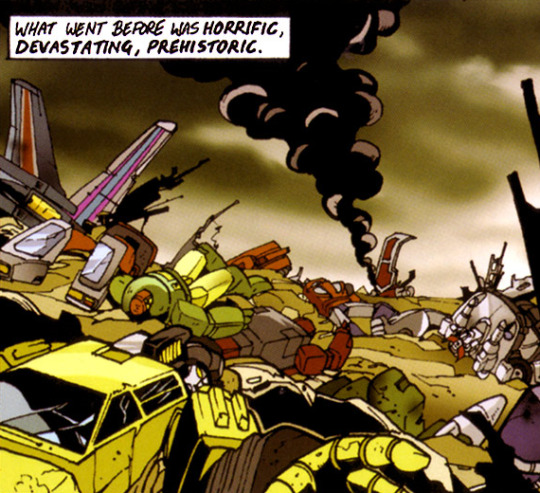
Getting back to the actual content of the introduction - I wound up writing less than I would’ve liked, leaving the page looking a little sparse, but hopefully making things easier for the reader. There’s relatively little to talk about in the way of trivia here. When I wrote the phrase “cut right to the spectacles” I was probably thinking of Carly Rae Jepsen’s “Cut To The Feeling”. When I mentioned “moist towelettes” I was probably thinking of Hawthorne Wipes. The phrase “truth time” was an iconic - to me, and literally no-one else in existence - line spoken by the trolling narrator of a crack story written by a high school friend of mine, the energy of which I feel like I’ve always been channelling with these comics.
The interlude, on the other hand, is crammed full of references and was a breeze to write. It was the first piece of prose I completed for the project. In general, I was trying to write in a verbose style that would be simultaneously at odds with the bulk of the issue and reminiscent of the prose of veteran Transformers scribe Simon Furman. He was known for using certain distinctive phrases repeatedly in his writing - one such phrase being “like some vast, predatory bird”. The phrase “neither sufficient inclination nor wingspan” is supposed to subtly evoke another Furmanism: “CANNOT, WILL NOT”.

In all likelihood, the interlude would not have existed had I not noticed that Ratchet’s head was in its cartoon colours in the first part of the story, but in its Marvel colours for the second. I had the idea to explain that error away in story - tying into the general schtick of “correcting” the comic - and did so by way of a reference to Ratchet’s original toy, which had a sticker with a face on it behind the windshield rather than a proper head. I was also determined to highlight the fact that Predaking’s legs remain standing for like three pages; I think this minor detail in the artwork is pretty indicative of the fact that Mr. Gibson did a good job.
The way Swoop’s contribution to the combiner is described as “puny” ties nicely to the history established between him and Grimlock in his profile. I like the way the Beast tries to hit Optimus Prime with a “truck-sized fist”. The “antimemetic shielding” was my attempt to explain the recurring disappearances of Optimus Prime’s trailer in a novel way - I did so by namedropping the key phrase from qntm’s There Is No Antimemetics Division; the trailer’s there, you just can’t perceive it and forget that it exists. Finally, “dull surprise” refers to the vague expressions that characterised Dreamwave’s house style.
For the most part, I was able to retain the ordering of the pages as in the original comic, to keep things print-friendly. The one exception to this is the prose page for the second part, which I unfortunately had to move forward so that its cover could fall across a spread. The original comics must’ve included something in the way of backmatter - art cards, perhaps, or adverts - which made up the space.

The huge cast of The Beast Within made creating a profile for every character an impossible task (especially when so many are just crowd-fillers like some of the Technobots were in “PASS”) - but it was perfectly possible to provide one for each non-combiner character with a speaking role.
(If you’ll indulge me in one last barely-relevant tangent as we head into the final stretch of this commentary, there are some rather odd inclusions/omissions in The Beast Within. On the Autobot side, pretty much every 1984-1985 character appears, with the exceptions of Trailbreaker, Hoist, Tracks, Smokescreen, Grapple, Beachcomber, Seaspray, Perceptor and Omega Supreme. The Autobot combiner teams are absent with the odd exception of Silverbolt. Twin Twist - who had been pretty much entirely absent from the original US fiction - makes an odd appearance without his partner Topspin. Steeljaw is the only one of the four 1986 Autobot cassettes to appear. Meanwhile, on the Decepticon side, oddities include the toy-inspired versions of Viewfinder and Spectro (most of the rest of the cast use cartoon-inspired character models) and the omissions of Spyglass and Buzzsaw. Some Decepticon combiner team members - Motormaster, Wildrider, Breakdown, Blast Off and Swindle - only appear in combined form. Just two of the four 1986 triple changers - Springer and Octane - appear in the comic, looking slightly out-of-place in a cast consisting mostly of characters present in the first two seasons of the cartoon. Oh, and the Deluxe Vehicles and Deluxe Insecticons are absent, but that’s to be expected in a cartoon-inspired setting.)
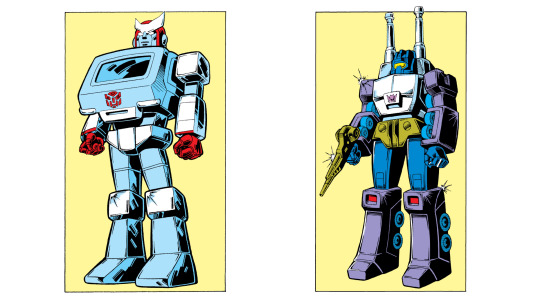
Here’s the first draft of Optimus Prime’s profile:
Unpredictable. Unstoppable. Unrepentant. Many words have been used to describe OPTIMUS PRIME, yet the abrasive leader of the Autobots remains something of an enigma even amongst his followers. He has ruled Cybertron for many millenia, by dint of the fact that he's apparently the only Cybertronian with a shred of competence.
It’s a product of the time where I wanted to really flesh out Optimus Prime and communicate his thoughts clearly to the audience, and as such is pretty blunt with how it characterises him. The final version is a little more subtle, drawing in elements of the scrapped introduction. I figure I may as well go through the other profiles one-by-one to give a sense for what I was thinking:
Megatron initially had a much more personal bio - which seems to have been lost to time - but I wound up cutting much of it to make space for elements of the story’s scrapped introduction.
Starscream draws inspiration from van Feleday’s interpretation of the character - she posited that Michael Bay’s version of the character was actually the Decepticon most loyal to Megatron. The contrast between that interpretation and pretty much every other in the franchise’s history (excluding Shattered Glass Starscream, of course) is pretty funny to me. I tried to use the phrase “fools errands” in as benign a way as possible, which I felt evoked a more traditional relationship between him and Megatron. “Starscream, you fool!”
Razorclaw has little in the way of characterisation in the comic beyond “noble warrior”, and his profile is a wholesale reference to The Chronicles of Narnia: he stands in for Aslan; the rest of the Predacons for the Pevensie siblings. So yes, this version of Razorclaw is a Christ-like figure. As for the witch... maybe Blackarachnia? Eh, who cares. Oh, and the idea of combining with a dead bot was one which cropped up a few times in IDW’s comics, most notably with the Combaticons in Mairghread Scott’s Till All Are One.
Onslaught was in a similar boat to Razorclaw. I found myself drawing from Till All Are One once more, hinting at a (complicated?) romance between him and another teammate.
Blitzwing has only one speaking role in the comic - a shared line with Megatron and Starscream - but I decided to count it for the sake of having a nice set of sixteen characters once more. In Transformers Animated, Blitzwing had multiple personalities, and would change forms depending on which was in control. This interpretation of the character has seen plenty of criticism, so I deliberately tried to come up with something new. I quickly settled upon the idea of tying his vehicle forms to his mood, a metaphor which seemed to dovetail nicely with the way aerial alternate forms were treated in “PASS” and which also allowed me to cement the Decepticons’ supportiveness.
Bulkhead was borne of the realisation that Springer appears prominently in both “Peace” and The Beast Within. This inconsistency is entirely the product of my decision to place my versions of those comics in the same continuity, and I decided to correct it in the tradition of “Bluster” and “Firster Aid” by having them be two separate (but related) characters. I named the new Springer after Energon Bulkhead, who was inspired by “Generation 1″ Springer - the name’s since been used more prominently by an Animated-original character and variations thereof, and is effectively fair game for “Generation 1″ stories. His actual characterisation was inspired by Springer’s behaviour in “PASS” - I liked the idea that Bulkhead bullied Springer, and Springer bullied everyone else in turn. Oh, and I wanted to tie their helicopter modes back to Blitzwing’s profile on a thematic level.
Bumblebee is the only character from “its christmas... so what??” to recur with a speaking role in “The Beast Within (My Pants)”. After scrapping the original introduction I’d planned for the comic, I was left with a single profile to bridge the gap between the two stories. My original idea was that, for their negligence in allowing the humans to steal Bumblebee’s blood, Prowl, Tracks, and Hoist would have been executed by Optimus Prime - though I’m sure he didn’t pull the trigger himself, it’s safe to assume that he didn’t warn them before setting off the nukes.
Ratchet has a characterisation inspired by something “Jonny Angel” posted in van Feleday’s thread: “Ratchet is an ambulance who practices no medicine”.
Jazz is an extremely prominent character in the comic, despite the fact that his only line is a scream in the opening panel. The comic relies on the wider context of the brand to let the audience be invested in him, but in a vacuum it’s kinda funny to see the Autobots fret so much over an effective nobody. Pretty much the entire joke in my version is just a reference to Ryan Gosling’s misguided quest to “save jazz” in La La Land - some of his character’s lines are lifted wholesale to comprise Jazz’s profile, which takes pains to avoid using any kind of pronouns (thereby maintaining the confusion over whether or not “Jazz” refers to the character or the music genre). His profile was the first I wrote.
Ironhide has a role amongst the Autobots loosely inspired by that of Drew Linky (or at least, the version of Drew Linky presented by SPAT) in the Homestuck Discord. I thought there was some symmetry there with Ironhide’s history in IDW Publishing’s comics.
Skids was a tricky character to portray, but ultimately his profile turned out to be one of the ones I’m happiest with. It’s kind of a loose riff on his portrayal towards the back end of James Roberts’ stories, where much of his arc revolved around his relationship with Nautica. According to Word of God, he had unrequited feelings for her - I decided to amp this up by giving him unrequited feelings for everyone. To tie this back to Homestuck, think Eridan/Cronus. Oh, and in terms of the Homestuck Discord server, think your typical hornyposter (and then follow the implications through in terms of Optimus Prime/Makin). The actual name “Skids Maximus” is a play on the way the suffix “Maximus” has historically been used for some combiners, “Optimus Maximus” in particular. I’m convinced I’m not the first person to do a joke like that, but nobody I asked could think of any older examples.
Grimlock was fleshed out pretty well by the comic itself, so I took his profile as an opportunity to expand upon the history of the Dinobots. I saw them as being akin to a group of friends who stuck together throughout school, winding up as an impenetrably toxic and incestuous mess with a ton of deep lore. In a way, there was a time when I was the Grimlock of my group of friends... but we all grew up.
Swoop is Grimlock’s ex-partner, a concept inspired by the other Dinobot combiner we all wish we could forget about. I’m pretty happy with the use of the word “bottom” in this context.
Snarl is based on a combination of various people I’ve known in real life - people who are perfectly nice and reasonable but have zero patience around certain other individuals. From the outside, it’s behaviour that comes across as pretty damn harsh, but - and please note that this is not an endorsement of such behaviour - it’s usually the product of a long period of aggravations.
Jetfire was the last character introduced in the comic, so it felt fitting to save his profile until last. His biography is effectively a mashup of his portrayals in the original cartoon (where he gets frozen in the Arctic Circle) and in Revenge of the Fallen (where he was a Seeker who wound up on Earth), a combination which neatly parallels Bay’s Megatron’s origins. It also references J.J. Abram’s infamous “mystery box” storytelling device, which I intended to mirror the offbeat lack of closure in the comic itself.

The final challenge I faced - one which had hounded me throughout the development of the comic - was what exactly to title it. Titles considered included:
“The BEE” (Tindalos’ suggestion)
“The BEE Within”
“The REEEE Within”
“SHIT” (Gitaxian’s suggestion)
“IM THE BEAST”
“AWWW SHIT” (Fear or Courage’s suggestion)
“AW SHIT ITS THE BEAST”
None of these resonated. Then, almost a whole month later, out of nowhere:

This was the entirety of Daniel111111222222’s contribution to the story - and what a contribution it was.
There were several reasons why I loved his idea. Firstly, it was easy to edit: most of the other suggestions would’ve required me to move lots of letters around, while this one would simply require me to append a few. More importantly, it felt like the title of a Chuck Tingle novel.
The subtitle for the second part - “No Pants” - seemed like a natural choice after that, the idea being that it evokes Grimlock’s inhibitions falling away with his transformation into the Beast. It narrowly edged out “Pants Off”, which I managed to squeeze into the final version of the introduction.
The parentheses in the comic’s title were my own addition, and in retrospect I kinda regret them. They seemed like a good idea at the time, but I’m not sure why. I was wrong to try and improve upon perfection.
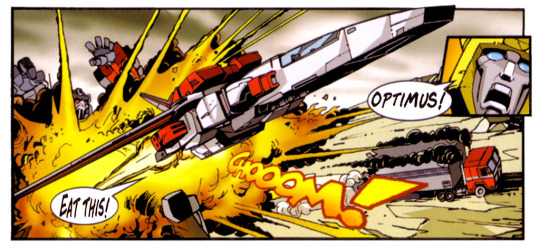
IX. Why Throw Away Your Life So Recklessly
So far, the bulk of this commentary has mostly focused on the aspects of this project which I think went pretty well. In a way, that's probably fair enough, because - on balance - I'm pretty happy with how it turned out.
At the same time, I can't help feeling that “PASS” - a comic which I probably threw together in the space of one day two years ago - is both funnier and more meaningful than the one which I spent a couple of weeks on.
When I started working on “The Beast Within (My Pants)” towards the beginning of May, I expected to have the project finished and out of the door by the end of the month. If you glance at the release dates of the various things I made, you'll see that I like to put out major projects on the last day of a month - it's a way of setting myself a deadline and it lets me associate a given project with a given period of time.
My first draft of the dialogue was released to prereaders on the 11th of May; my second on the 13th. Around that point, exam season started to kick in and I decided to prioritise to other projects - the Retrace Steps commentary and the Are You Happy retrospective - which both ballooned out into much longer pieces than I'd planned. I successfully met my self-imposed deadline for those projects and pushed back the release date for the comic to the end of June. I released the first drafts of the text-only pages on the 9th, but the profiles didn't follow until the 24th. By the time you read this, I'll have been working on the project on-and-off for over three months; despite the fact that I was ostensibly on vacation for most of that time, I was somehow busier than I tend to be at university.
For context, it took me just four months to adapt Retrace Steps from a short film script to a webcomic (well, “webcomic”), and that was a process which actually required original artwork. At the time I noted that I needed to re-evaluate the way I approached commentaries, as the amount of time required to produce one of a high standard seemed only to increase - they're extremely valuable to me, and seem to be well-received by the few who read them, but are they justifiable if they take longer to create than the things they comment on?
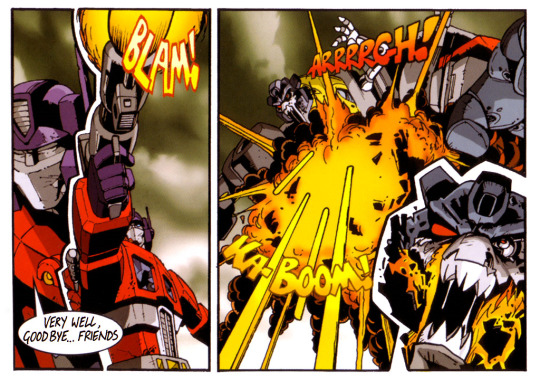
All of this is my long-winded way of saying that I've probably spent more time thinking about The Beast Within than the vast majority of people who know about it, and that I kinda regret that. See, in the sense that The Beast Within provokes a visceral emotional reaction, it’s a “good comic” - but so too does a punch to the face. The Beast Within is not a good comic. It’s mean and deconstructive and poorly-done. My version is borne of contrarianism and hubris, and softens the blow not one bit.
At the time when I was writing Grimlock's dialogue, I found that my own typing style was becoming increasingly acidic.
The truth is that “PASS” is probably the most successful thing I have ever made, and I wanted to make a comic which would put it to shame, and I failed miserably. In fact, I feel like I’ve made something which only I could ever enjoy. It’s derivative in the extreme. As my deadline for this project drew closer, I resorted to drafting bits of the commentary on my phone in public, and at one point somebody idly asked me what I was writing, and - after failing to think of a convincing lie - I said something along the lines of “it’s kinda a long story, and I wouldn’t enjoy telling it, and you wouldn’t enjoy hearing about it”. They seemed perfectly satisfied by that answer, but I wasn’t.
Must we justify the things we create? Mr. Jamieson’s attitude seemed to be to say “screw you, I don’t have to justify myself to stupid people” (while pointing at everybody else in the room). My attitude, as evinced by this commentary, has been to justify every aspect of everything I make in excruciating detail, so that if you tell me “I don’t like X” I can say “I already explained why I thought X was a good idea” and you can say “well you were wrong” and I can say “maybe”.
You’ve probably twigged that, throughout this commentary, I’ve referred to the creators of The Beast Within only by second name. At first, perhaps, it came across as some mark of mocking respect - like citing a scientific source - but the real reason is cowardice, not confidence. Some people occasionally put their own names into Google. There’s a couple of people to whom I really don’t want to have to justify myself.
Over a decade after the release of the The Beast Within, Hasbro released a brand new set of Dinobot toys which combined to form Volcanicus. The creators of the Prime Wars Trilogy and of the Earth Wars mobile game gleefully included the new combiner in their stories, and the fandom at large embraced it wholeheartedly.
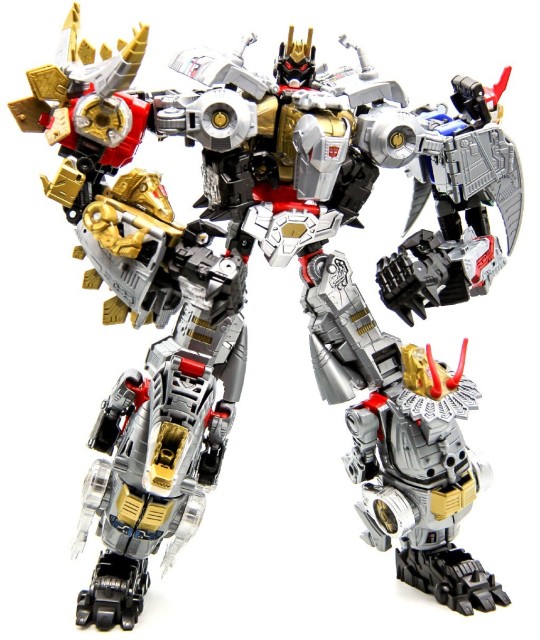
As her thread drew to a close, Terry van Feleday wrote something which I think about often:
Of course [...] let’s not forget that no matter the amount of earnest work put into something, sometimes it just turns out shit. There’s a strange perception I noticed in critical response where people seem to find it difficult to consider something both earnest or satirical and, well, not very well made. Sucker Punch can’t be an honest indictment of cinematic objectification and a somewhat poorly conceived, almost hypocritical attempt at being more clever than you should. Transformers can’t be an inversion of the traditional hero/villain narrative showcasing the effects of authoritarian propaganda and a meandering, under-focused, often poorly communicated, destructive mess. Maybe it’s a strange entertainment-version of the Just World Fallacy where lacking results must necessarily result from lacking effort, or maybe it’s modern audiences’ strange worship of subversiveness, where a work critical of old tropes must by default be better than the works it’s commenting on throwing to the dustbin of history, but either way, people are extremely resistant to the idea that films they found emotionally dissatisfying could express depth and meaning and tend to dismiss them as another ‘genre film’.
Mr. Gibson is a children’s picture book illustrator. The Beast has no place on his website.

X. Proceed On Your Way To Oblivion
TFNation - the UK’s biggest Transformers convention - has become something of an annual pilgrimage for me, and (as of the time of writing) I’ll be making that pilgrimage in a matter of days. If you see me there, feel free to come over and punch me. Or, y’know, just say hi. I’ll have some limited-edition printed copies of “PASS” to give out. For more information on that - and for infrequent Transformers-related musings and updates on future projects - wander on over to my twitter!
What are those future projects? Well, after the convention I’m planning to release an original short story. It’s not very good, but it’s got a few stylistic similarities to this comic (read: lots of swearing). I might have a little bit in the way of Transformers prose coming out down the line, but can��t really elaborate further on the form that’ll take. I’ve been planning to get back to Huskyquest for ages, and hopefully I’ll finally be able to do so once I settle back down at university. After that, I plan to focus my efforts on prose, so you may as well expect more radio silence from me.
If you’ve made it to the end of this almost-fifteen-thousand-word monstrosity, you, uhh... win all my internet points? Sorry, that’s all I have.
Remind me never to do this again.
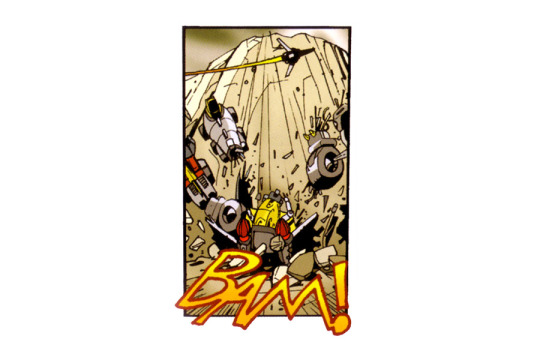
10 notes
·
View notes
Text
“I Have at Least Five Albums Worth of Material Yet to Record!” An Interview with Mark Fosson
This interview with the late Mark Fosson originally appeared at North Country Primitive on 25th May 2015
We are very pleased to bring you an interview with the last guitarist John Fahey signed to Takoma records, Mark Fosson. After Takoma was sold, Mark’s recordings for the label remained in his garage unheard for almost 30 years, until they were finally released in 2006 by Drag City. A further archival release, Digging in the Dust, a collection of early home recordings, was released by Tompkins Square in 2012. Fast forward to 2015, and Mark has just brought out his first ever new collection of instrumentals, kY, a paean to his home state of Kentucky, and mighty fine it is too - in our view, his best album yet. Recorded at his home in Baltimore, the album has a timeless, folk-infused quality and features Mark on banjo and dulcimer as well as an enviable collection of guitars…

Can you start off by telling us about the new album, kY? You appear to be revisiting your roots on two accounts: firstly, it has the feel of the sort of pure American Primitivism that could have been put out by Takoma any time in the 70s; secondly, the strong traditional folk themes suggest that you are literally revisiting your roots as a native Kentuckian. I had been trying to record a whole other group of instrumentals that I had written and not getting anything I was really happy with. I was probably trying way too hard to come up with the perfect guitar album and being way too critical, which I’m prone to do. At a certain point I realized I wasn’t having any fun at all and decided to step away from it for a while. So next time I went down to my studio, I pulled out my banjo instead of a guitar and started noodling around and came up with Kingdom Come. I had just purchased a Tascam DR-05, so I made a quick recording of it and was totally pleased with the way it came out. I thought, why not do a whole new album that way? So I would sit and noodle every day till I came up with an idea I liked and record it immediately, while it was still fresh. Most of the songs are first takes, but I never did more than three takes and I think the tunes have a very spontaneous feel because of it. I used the Tascam on quite a few of the songs on the record… Kingdom Come, Kentucky, Cold Dark Holler, Come Back John. All the songs are inspired by my childhood memories of growing up in Kentucky. I recorded it at Pine Box Studios - a.k.a my basement. What have you been up to recently? It’s been eight years since Jesus on a Greyhound came out. I’m aware of the live sessions you’ve done for Folkadelphia and Irene Trudel, but I guess you’ve been keeping busy in other ways… I moved to Baltimore about six years ago and have been writing and playing every chance I get. Did a short tour with Daniel Bachman when our Tompkins Square records came out… Done quite a few gigs in Philly and New York, some with Don Bikoff, who has become a good friend. A lot of excellent young musicians out there I’ve had the chance to play with… Hope to do a lot more. Were you pleased with the response to Digging in the Dust? Were these recordings what brought you to the attention of John Fahey and Takoma in the 70s? Yes, I was very pleased with the response… it’s good to have it out there after all these years! These are the tapes I originally sent to Takoma. There were also five vocal tracks on that demo which John really liked. I’m not crazy about the way my voice sounded back then… like I was 12 years old! Luckily I’ve learned to sing a little better over the years. There was a song on the demo called Grandpa Was A Thinker, which John and his wife, Melody, liked a lot. I’m pretty sure it was that one and Gorilla Mountain that got me signed. How did you link up with John Fahey and Takoma Records? I had been listening a lot to releases on Takoma… I think I wore out a coupla copies of Kottke/Lang/Fahey. On a lark I sent the tape to them, never dreaming I’d get signed! I remember I had come home from work - I was working in a steel plant at the time - and had fallen asleep in my chair. My wife woke me up, saying, “There’s some guy named Charlie Mitchell from Takoma Records on the phone.“ Then when I got to California, John co-signed for a brand new Martin 12-string. I kick myself nearly every day for selling that guitar later on! As soon as I got to LA, I started opening shows for him… I think the first was McCabe’s Guitar Shop in Santa Monica, which was right next door to the Takoma office. His records sounded great, but hearing him live - and that close! - was an unbelievable experience. How did Drag City come to release The Lost Takoma Sessions 29 years after it was recorded? My cousin Tiffany Anders had started listening to Fahey and found out I had been on the label, so she asked for a copy of the recordings. They were gathering dust in the corner of the garage and I was reluctant to let her have them at first, because I figured the stuff was too old for anyone to care about. She proceeded to send it around and before long I had three or four offers from labels to put it out. I eventually decided on Drag City and I think they did an excellent job of getting it out there. What was the musical journey you took to playing solo acoustic guitar? Did you do the whole garage band thing first or were you always attracted to acoustic music? And what were your formative influences, musical or otherwise? Everyone in my family was a total music lover, so I was bombarded with good music of all styles from an early age. When I was in elementary school, Jean Ritchie would come and perform every year… that’s probably the first traditional folk music I was exposed to. I played a festival with her later on and at the after-show jam, I talked her into giving me a dulcimer lesson, which was totally cool of her. My Aunt Rachel sang and played guitar and I was always asking to play her guitar. I bugged her so much, in fact, that she gave me one of hers - a Beltone. What a beauty! That pretty much started me down the guitar road. Also my dad would buy 45s from the guy that stocked the jukeboxes in the beer joints he frequented and was always bringing home the cool, obscure music… lots of blues and extreme hillbilly stuff. Later on I became a Roger Miller fan and pretty much taught myself to play listening to his records. My grandmother was bedridden for a long time and I would go to her house and try the songs out on her. If I got her laughing I considered it a success.
Then at the age of 14, the Beatles broke and that’s when me and probably a billion other teenagers decided to become musicians. That turned into a succession of garage bands. Then in college I started getting more in to the folk music again. My buddy Dan Gore and I would spend hours at the school library listening to the old blues and Folkways records - The Harry Smith Anthology was a big favorite - and we began performing at the school’s coffeehouse every Friday night. It was run by my English teacher, Nancy McClellan, and she also organized some of the big folk festivals in the area. She may have encouraged me more than anyone to be a musician. Then when I was stationed in North Dakota in the Air Force, I began discovering the Takoma artists. I actually bought the Kottke/Lang/Fahey album because of the cool cover - I wasn’t that familiar with the artists at that point - and was blown away by it. I think the most influential album for me, though, is Peter Lang’s Thing At The Nursery Room Window. It’s still one of my top five favorite albums of all time. Which reminds me… I think Daniel Bachman forgot to give me back my Peter Lang CD!

What were you up to between the Takoma recordings and Jesus on a Greyhound? Did you keep making music during this period? Can you tell us how Jesus… came about? When the Takoma thing fell apart, I continued playing around Los Angeles, Sometimes solo, sometimes with a small group. I played with a bass and tabla player for a spell - that was a great sounding little combo. Then in the mid 80s, I started a country rock duo called Crazy Hearts with Karen Tobin. We had a song on the A Town South Of Bakersfield compilation, along with Lucinda Williams, Jim Lauderdale and Dwight Yoakam, then went to Nashville to showcase, but Karen ended up getting a solo deal on Atlantic Records and that was pretty much the end of the duo. Then I started a group called The Bum Steers with my good friends Edward Tree on electric guitar, Taras Prodaniuk on bass and Billy Block on drums. We caused quite a ruckus in Nashville: Porter Wagoner personally invited us to play the Grand Ol’ Opry, but I think we may have been a little too left-of-centre for that town. Anyway, after these two full-blown groups, I decided to get back to basics and perform solo again. Jesus On A Greyhound came about because I wanted to write an album’s worth of songs that sounded good with just voice & guitar. And although I did add some extra musicians to the record, the music is still drastically stripped down compared to what I had been doing. And totally acoustic. At the moment there seems to be a veritable swarm of young players influenced by the American Primitive sound. Do you feel any particular affinity for them? Are there any favourite players who particularly stand out for you? When The Lost Takoma Sessions came out, were you aware of people like Jack Rose and Glenn Jones? I started to become a lot more aware of the newer guitarists when Lost Takoma came out. I did a short tour with Joanna Newsom and she turned me on to a lot of the younger players. Of course I was aware of Jack Rose and was already a Glenn Jones fan. Then, like I said earlier, I did a short tour with Daniel Bachman and was really impressed with his playing. He’s on fire… seems like he puts out a new record every two weeks. Met Nathan Bowles through Daniel and I really enjoy his banjo playing, both solo and with the Black Twig Pickers. I’ve become friends with quite a few of the new pickers: through Don Bikoff I met Matt Sowell, who introduced me to Kyle Fosburgh, who introduced me to Hayden Pedigo. I got to play a duet with Hayden on his new record Five Steps. There is certainly no shortage of excellent young musicians out there! Lots of great records being made…I’m always checking out the new stuff. You play banjo on a couple of tracks on the new album, which sounds fantastic. Are you a big fan of the instrument? Are we likely to hear more banjo excursions from you in the future? Thank you… I love playing banjo! Seems like I don’t do it as much as I would like to, but it’s getting a little more frequent all the time. I keep saying I’m going to get a really nice clawhammer and get serious with it… someday! I was at a songwriter retreat in Stanley, Idaho, a couple of weeks ago and one of the musicians had a killer clawhammer with nylon strings that sounded amazing. So what happens next? Any plans for gigs? Have you got more material up your sleeve? Well I have at least five albums worth of material yet to record, so I’ll just keep plugging along and making new records. Been getting a lot of pressure to put out a follow-up to Jesus On A Greyhound, so that’s probably the next project up. Unless things change…which they do! And of course I plan to keep gigging as long as I can.
Behind kY - Mark Fosson’s Track-by-Track Guide
We asked Mark about the guitars and other instruments he used on kY. He responded by sending us a track-by-track guide to the instruments played and the tunings, as well as a little background on each of the tunes. Jimmy Leg Mule high strung Tacoma Road King [C -G - C - G - C - E] You need to visualize riding this mule as you listen. Loose Change 1995 Martin 00016GT [Standard Tuning] The ‘loose change’ refers more to the chord progression than the amount of coins in my pocket. The way it sort of gets lost at the end and falls in a hole… I meant to do that! When We Were Young 1968 Gibson B-25 12 String [A# - F - A# - F - A# - D] I wrote this one for my grandparents, Harry & Grace Steed. Kingdom Come Deering "GoodTime” banjo [G - D - G - A# - D] Kingdom Come is a real town in Harlan County, Kentucky. Indian Summer Tacoma DM1812E3 12 String [C - F - C - F- F- C] Glenn Jones showed me this tuning and I proceeded to write about seven songs using it. Dogwood Dulcimer was made by Robbie Long, San Geronimo, CA 1976 [A - A - A - D] I often wonder if the fellow who built this dulcimer is still alive? Simpleton 1956 Gibson LG2 [C - G - C - G - C - E] There was a fellow named John in my hometown who would stand on the corner directing traffic & waving to everyone who passed. In the old days he would have been considered the ‘village idiot” but my folks used to refer to him as the ambassador of good will. Cold Dark Hollow 1956 Gibson LG2 [D - A - D - F - A - D] A cold dark hollow is an eerie place when the sun is about to go down… I tried to capture that feeling. Avondale Strut Tacoma DM1812E3 12 String [C - G - C- E - G - C] The part of town where the black folks lived… my romanticized idea of a regular Friday night there. A Drink w/Stephen F 1995 Martin 00016GT [Std tuning] Legend has it that Stephen Foster drank himself to death in the North American Hotel and left this world with 38 cents in his pocket. Which brings us back to the amount of coins in my pocket… let me check… hmmm …39 cents. Bad Part Of Town Deering “Good Time” banjo [G- D - G - B - D] There’s a ‘Bad Part’ in every town… And I’ve been to a LOT of towns Kentucky 1990 Gibson J100 [D - A - D - F - A - D] I’m not sure what this one is about. Come Back John 1968 Gibson B25 12 String [ A# - F - A# - F - A# - D] This is me trying my damndest to write a John Fahey tune… inspired by Sunflower River Blues, which John taught me how to play backstage at Bob Baxter’s Guitar Workshop, 1977.
1 note
·
View note
Text
Suede: All That Glitters
England’s new Band of the Century hits a glam slam
Rolling Stone, May 27, 1993
By Steven Daly
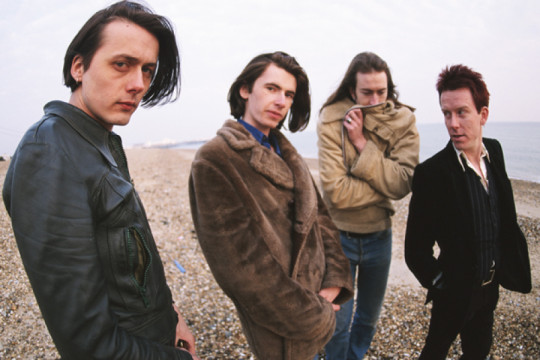
Photo by Denis O’Regan
Brett Anderson puts his bare feet up on a Columbia Records conference table and rakes back his lank fringe. Suede’s gaunt frontman wonders why no one back in balmy London troubled to mention that he’d be arriving in New York on the heels of an early spring snowstorm. In the corner of the room, a pair of sodden moccasins pays mute testament to his climatic misjudgment.
As befits its neo-glam reputation, this month’s English Band of the Century travels with only carry-on luggage. Suede’s glamour, though, is of a distinctly seedy stripe. Anderson’s leather bomber jacket is peeling quite badly, and his black needle cords have seen better days, while bass player Mat Osman’s pin-stripe jacket, desert boots and suede appliqué shirt are equally unlikely to spawn a collection of designer rip-offs.
With its triptych of instantly classic singles – “The Drowners,” “Metal Mickey” and “Animal Nitrate” – Suede announced a changing of the guard in British music, powerfully confirming it with a debut album, Suede, of formidable grace and authority. Anderson’s sterling writing partnership with guitarist Bernard Butler lends much-needed gravitas to the singer’s arch vocal style, a pained cockney whine that recalls London pop lineage from the Small Faces and David Bowie through the Sex Pistols. If Suede has done anything to deserve the mark-down tag of glam, it has been introducing the post-acid-house generation to pelvic posturings.
The trajectory that dumped these threadbare dandies in New York has been a sharp one. Brett Anderson grew up in Haywards Heath, a glorified stoplight between London and Brighton, and after the standard-issue alienated adolescence he lit out for the bright lights of the capital with fellow Smiths buff Osman. They placed a small ad seeking a guitarist for their “eminently important band” and reeled in Butler, at 22 three years their junior, who was later joined by drummer Simon Gilbert.
The nascent Suede slogged around lowly London stages until its penchant for preening drama got the band members laughed out of town. They slunk off to spend the last half of 1991 in squalor, a siege mentality shrouding intense bouts of writing and rehearsal. “We started out with the idea that we wanted to be in a great band, but it was a while before the musicianship caught up,” Anderson now admits. “We began listening to classic songs like ‘A Day in the Life,’ more for their sense of elegance than anything specific in the chord structures.”
When Suede emerged, the turnaround was alarming: Melody Maker anointed it Best New Band of 1992 before one new song had been committed to vinyl. So strong was the avalanche of media that the band’s publicist garnered an industry award for “campaign of the year.” For once, though, the press hype has a toehold in reality.
“We’d have been birched on the streets of Bermondsey if people didn’t think we’d got it after that,” says Anderson. “But it was the new year, and people were getting bored. London was overrun by these shoegazing bands, and there was a feeling of ‘I’ve had enough of this. . . .’“
And sure enough, the nation was soon gripped in the throes of Suedemania. The band’s turn-on-a-dime dynamics not only counterpoint Anderson’s falsetto flights, they put a jut in his strut that provokes followers to hysterical displays of worship at live shows. So violent are these reactions that Suede has actually had to tone down its stagecraft of late.
“This group appeals to people who are isolated in some way,” says Osman of Suede’s dramatic rise. “Geographically or socially or sexually or fashion-wise.”
“Or biologically,” says Anderson with a laugh. “I think there’s a section of music lovers in Britain who are in certain dead-end situations who flock to certain sentiments in music. And I think for that to happen, the artist has to have felt them themselves. That’s probably where a lot of the Smiths comparisons came from. I think there’s a parallel to be drawn.
”One early Suede convert was in fact Morrisey himself, who sent the group perfumed regards before covering its stately, decadent anthem “My Insatiable One” (from the B side of Suede’s first EP, The Drowners) on his world tour. Like Manchester’s Nabob of Sob, Anderson has been the subject of intense sexual speculation. An oft-quoted – and much-regretted – remark about being a bisexual man without homosexual experience only furthered an impression given by lyrics slathered with NC-17 imagery, where a third person of transient gender nibbles freely at the whole carnal buffet; now he leers, “She’s a luvverly little numbah!” (from “Moving”) and now “we kiss in his room to a popular tune” (“The Drowners”). Before you can say, “It’s Pat!” this switch-hitter is imploring, “Have you ever tried it that way?” (“Pantomime Horse”).
“I think I’ve got scope as a writer, so not everything I write is completely autobiographical,” explains Anderson thoughtfully. “I feel vague when it comes to where I stand sexually; I don’t know what to say – I’m willing to be persuaded, whatever.”
In a climate clogged with infantile techno-novelty records and TV-marketed oldies, Suede has rushed through the British charts like a hormone shot – even if no one knows which type of hormones. As one of the most subversive stars ever to taste Top Ten action, Anderson’s seamy subconscious terrain bears greater resemblance to the world of, say, the Sixties playwright-provocateur Joe Orton than it does to the lazy lexicon of contemporary rock, with its calcified sentiments of indolence, infatuation or “rebellion.”
“My mind has always been much more encased in reality than that,” says Anderson. “And the reality that everyone knows involves a certain amount of sexual failure. Not everyone’s stomping ground is Venice Beach – I can’t think of anything more boring than Baywatch set to guitars, which is how a lot of music treats the idea of sex.
“Most music is lazy; it speaks in pop-speak, prodding your memory about things you’ve heard before,” Anderson adds. “I’ve never wanted to write like that. I wanted to do something with a bit of tension, look at things through different perspectives. It’s the Oscar Wilde thing of lying in the gutter and looking at the stars. Life has always been cinema to me, even when I’ve been sitting in the dole office. That’s the only way to do it sometimes.”
The following afternoon sees Suede visiting the influential alternative radio station WDRE in an office block in suburban Long Island. The band is, it seems, coming to terms with the New York weather. Six-and-a-half-foot Osman has scored some inexpensive socks at J. Chuckles, while Anderson has economically stuffed a plastic bag inside his shoes.
Suede might find America’s cultural climate a little harder to accommodate. Several U.S. record companies tend, bizarrely, to set their clocks by British hype (Suede’s reputed $500,000 Sony pact is unexceptional), as does a significant cohort of media Anglophiles. When the bicoastal greeting parties are over, however, things can get a little sticky. The freeways of the Midwest are littered with the bones of pale, snaggletoothed hopefuls who came to grief on America’s punishing concert circuit.
As Osman takes the Columbia promo man’s rental Ford Taurus for an unscheduled spin around the DRE parking lot, he muses. “We’re completely aware that we’re a bunch of insects over here compared with even Screaming Trees or Soul Asylum,” he says, “a horrific thought, but one we recognize.”
4 notes
·
View notes
Note
oo!!! 1 2 4 5 8 10 11 13 15 17 21 22 29?
Yeehaw !!!
1) If someone wanted to really understand you, what would they read, watch, and listen to?
How many showtunes can one listen to before being driven insane. But I’d say Falsettos and Fun Home. “Last Podcast on the Left” is what really drove me to get my podcast on campus. I’d also say to watch like, a TON of old movies because those are a Big hyperfixation of mine. In particular I love Peter O’Toole and James Stewart, as well as Malcolm McDowell. I’d also say Milk and The Times of Harvey Milk. “M*A*S*H” as well is really big to me, ofc. Mmmmm as far as reading I can’t really think of anything. I love the Romanticism-era poetry tho. I also really love “Hamlet” and “Macbeth” and “The Things They Carried.” Watching and reading Ordinary People is also very big and close to my heart.
2) Have you ever found a writer who thinks just like you? if so, who?
I probably have but I can’t think of any rn h a. I CAN say that the symmetry of Wes Anderson films is intensely pleasing to my OCD ass. (Shoutout to Prozac btw.) Like, that shit is just SO good to me and I’m like Mr. Anderson. You Get It.
4) Do you like your name? is there another name you think would fit you better?
I quite like my name and also like Sheridan, which was almost my name, whether I was born male or female. Would have gotten named after a tank tho so. We All Have To Make Sacrifices. Feel free to call me Hawkeye too!
5) Do you think of yourself as a human being or a human doing? do you identify yourself by the things you do?
Bro I’m just existing. I’m just kinda here doing shit and being shit and being perceived by others and not liking being perceived differently than how I see myself. But for like, my WHOLE life my identity was based around my academic achievements which blows so I don’t like to identify myself by anything academic now. I’d like to be identified by my kindness and passion for things.
8) What musical artists have you most felt connected to over your lifetime?
I grew up listening to the B.B. King and Eric Clapton album “Riding With The King” and I have a very vivid memories connected to that album, like ones of a better time in childhood. All Time Low as well, I’ve been listening to them since my freshman year of high school. Anything classic rock really but Journey has just been a big thing around me since middle school. MCR and FOB were also bands I listened to growing up, as well as Panic!. Franz Ferdinand I started listening to 2 years ago but I love their stuff. I also have a soft spot for classical music but can’t name any people in particular. I’m a big fan of Dvorak’s “New World Symphony”, the 4th movement specifically. It slaps. “Adagio for Strings” by Barber as well! I’ll also say Shura.
There’s a video of the 4th movement of the “New World Symphony” being performed for the Pope I believe and that conductor is just OFF THE SHITS it’s so good.
10) Do you have a creed?
Not really, not that I can think of. I just try and believe that I should give people the benefit of the doubt or at least, consider other emotions and reason why people are acting a certain way and not just immediately dismissing them. I try and keep an open mind about most things, just taking everything into consideration before I pass judgment or judgments.
11) Describe your ideal day.
Oooh, I’m going back into the brain bank for this one.
Bringing back “Riding With The King”, a cool summer day, doors open and letting the air come in. My favorite music played loud, I’m hanging out with my friends and loved ones, having drinks and eating good food out in the backyard, playing in the old inflatable pool by the back deck that made jumping in real easy. Having grilled shish kebobs, watching the sunset and looking at the stars in the night sky, chasing the dog around in the backyard, looking at the fireflies.
Another later memory was getting up at a good time, the windows are open and it’s a crisp spring morning, I’m at the desktop computer playing The Sims 2 loaded up with custom content from the now-defunct Sims 2 website exchange. My dad makes a big breakfast of pancakes, bacon, eggs, English muffins with apple butter. He probably found a war movie on TV. I’m making plans with my best friend Kim to come over the next weekend or the weekend after. I just get to act like I’m a regular kid with a regular family and things are good.
13) Inside or outdoors?
INSIDE... unless it’s cool out, in which case outside. I’d love to have a screened-in porch someday. I hate bugs.
15) Five most influential books over your lifetime.
HOO okay let’s think. The “Shiloh” series and the “Warrior Cats” series. “The Things They Carried” as well as “Ordinary People.” I’d also say the “Harry Potter” series because that was really big for me growing up. I’m gonna fudge this and add “Twilight” and “Vladimir Tod” because I loved vampire fiction. “Frankenstein” as well, and “Hamlet.”
17) Would you say your Tumblr is a fair representation of the “real you”?
I’m a lot dumber in real life. Beez pucciverse just saw a video of me last night eating a stick of butter. I’m just an impulsive idiot and y’all should be thankful and grateful I don’t post EVERYTHING going thru my mind because I have to weigh if it’s better for Tumblr or Twitter HSKDFHSKJF. But I’m very Not Smart.
21) Do you love easily?
I have a stuffed animal right next to me that I’ve had since I was 5 so I’d say so !! Cheer Bear has. Seen A Lot.
22) List the top five things you spend the most time doing, in order.
OOO okay... Sleeping, watching YouTube videos/movies/TV, playing Revue Starlight or other games but that’s about tied with YT/movies/TV, listening to music/podcasts, and writing a podcast script!
29) Three songs that you connect with right now.
Mmm “What’s It Gonna Be?” by Shura, “I’m Still Standing” by Elton John, and “Under Pressure” by Queen and David Bowie!!
Thanks for asking all these questions !! It was a lot of fun
#proteuslindo#asks#ask games#i'm essentially a human garbage disposal there's many videos of me eating things I probably shouldn't consume JDSHFDKSJ
1 note
·
View note
Text
i researched the cast so u dont have to
Anthony Scaramucci
Former White House Director of Communications in the Trump administration. He only served in his post for 6 days after a phone call between himself and a journalist was leaked where he used explicit language to trash talk other Trump administration officials. Kinda became an iconic “wow he’s a hot mess” figure afterwards. Honestly I’m most excited for him because he is absolutely crazy and with live feeds who knows what he’ll accidentally leak.
Dina Lohan
Mother of Lindsay Lohan, and her manager during her early career. Very typical D-list celebrity, appearing on her own share of bad short-lived reality shows. One can assume someone’s upbringing could affect how they turn out as an adult, so you can probably see how good of a mother (and also a person) she is based on how Lindsay is now. Also a criminal with a DUI conviction so even more fitting for a D-list celebrity.
Joey Lawrence
Actor best known for his co-starring role in the 90s sitcom Blossom. After that, he got his own 90s sitcom Brotherly Love, but it did not last long. Hasn’t done much after that but was on season three of Dancing with the Stars and placed 3rd. Sort of a regular in the “D-list celebrity competition reality show” genre.
Jonathan Bennett
Actor whose really only claim to fame is playing Aaron Samuels in Mean Girls. He placed 9th on Dancing with the Stars and is now a host on the Food Network.
Kandi Burress
Singer and reality television personality who first became known for being in the girl group Xscape, who had a couple top ten singles in the early-90s. She also won a Grammy for co-writing TLC’s song “No Scrubs”. Now she’s a cast member on The Real Housewives of Atlanta.
Kato Kaelin
“Actor” who isn’t actually known for being an actor, just known for being a witness in the O.J. Simpson case back in the 90s. After that he also sued a newspaper who pretended like he was a suspect in the case which became a super influential lawsuit (I’m a law student and it was like a landmark case in libel law). He doesn’t really do anything except D-list (maybe not even D-list, more F-list) “celebrity” reality shows. Sometimes he doesn’t even compete on celebrity reality shows, just civilian game shows which is kinda embarrassing.
Lolo Jones
Olympic hurdler and (apparently) bobsledder who made herself well-known enough for reality TV but not well-known enough for actual fame. She’s actually never won a medal in the Olympics (not even like bronze) which makes me wonder why people care about her more than any other Olympic athlete, but she’s a regular on reality shows like this and even placed last (yes, last) on Dancing with the Stars.
Natalie Eva Marie
Former WWE wrestler under the ring name “Eva Marie” who has since left wrestling to become an actress. She now uses the name “Natalie Eva Marie”, probably to show people “hey my real name is actually Natalie and I never actually wanted to be a wrestler, but y’know Hollywood is rough” but also “hey don’t forget about me I was Eva Marie in WWE for like three years and it’s probably the only reason you know who I am”. She kinda had some controversy in WWE too. She would fake “unfortunate events” in order to avoid competing, and tested positive for Adderall when she didn’t report a prescription to WWE doctors. Her acting career has been ...quiet, but she’s just starting out so I’ll give her the benefit of the doubt.
Ricky Williams
Played for the NFL and I’m gonna be honest with you, I don’t like football and neither does my entire family (yes the straight men included), so I really don’t even know how to understand the information I’ve researched for him. He’s played for like five teams within the span of ten years and retired in 2011, so I guess now that the NFL money ran out he has to play the D-list celebrity reality show game.
Ryan Lochte
I rolled my eyes at the fact I even have to write about this guy. He’s an Olympic gold medalist swimmer, and he’s always been somewhat associated with the reality show industry (he had his own *coughterriblecough* reality show back in like 2013), and it’s honestly only because 1) he’s a gold medalist and 2) he’s really hot. But he became more famous during the 2016 Olympics in Brazil when him and some of his swimmer friends vandalized some poor Brazilian gas station and when security guards found them, they lied to the press and said that they were robbed by criminals dressed as cops. He kinda had to flee Brazil afterwards and was banned from competitive swimming for like a year and everyone hates him now, which is why I don’t know why people are still casting him in shit.
Tamar Braxton
I had this whole thing written out for her about how she was probably the most famous in the cast, but then I realized I was thinking of TONI Braxton, not Tamar. Basically she’s Toni’s younger sister and had her start in the early-90s in the sibling band The Braxtons. She hasn’t done much in music after the band broke up. Her 2013 album Love and War peaked at number-2, sold almost 500,000 copies, and got her some Grammy nominations, but none of her singles have really been too successful and none of her other albums have either. She’s done her fair share of reality television (notably Braxton Family Values) and television hosting, but music is what she’s primarily known for and that’s more because she’s Toni Braxton’s sister than anything else.
Tom Green
Actor and comedian from the 90s/2000s MTV era. He had his own show on MTV called The Tom Green Show which was kinda popular I guess, and he appeared in some popular teen movies from the era like Road Trip. He was also married to Drew Barrymore for a year (yes, a year), which is probably the biggest bit of relevancy he has.
#cbbus2#this better get some notes cuz this was torture#for the record i knew scaramucci dina lohan jonathan bennett lolo jones eva marie and ryan lochte beforehand
20 notes
·
View notes
Link
Olly Alexander, the frontman of the British band Years & Years, has blood-red dyed hair. He wears a brass safety pin through one ear and sometimes grins so widely, so wildly, that the edges of his mouth seem to disappear around his narrow, fine-boned face. What soon draws the eye is a scar on his forehead. “I ran into a brick wall as a kid,” the 27-year-old says over lunch at a cafe in London. He touches the scar. “I was playing at being a Power Ranger. Ouch.”
These days, Alexander plays at being a pop star – and on the surface, at least, it seems like a game that’s going well for him. With the launch of their first album in 2015, Years & Years enjoyed a really remarkable few months. They were named BBC Sound of 2015 in January, promptly going to No 1 in the UK singles chart in March, and likewise topping the album chart in July. The band’s propulsive, 90s-nostalgic dance pop (like Disclosure or Clean Bandit, only up the randiness and add a little disco) caught on. And Alexander made a quick Meghan Markle-like ascent to something like pop royalty. “One of the most influential gay pop stars of this generation,” the Gay Times wrote. “All hail the King!”
Years & Years are a three-piece – also made up of keyboard and synth player Emre Türkmen and bassist Mikey Goldsworthy – but it has always been clear that Alexander is the band’s guiding force, their chief lyricist, a Gaga-like taker of risks when he performs and a political voice, off stage, who has an appealing, glitter-speckled sense of activism. A pithy and witty speaker on LGBTQ+ rights, Alexander has also opened up engagingly about his struggles with mental health. “A lifeline to troubled young people,” the Observer wrote of him, in 2016, around the same time that Years & Years played at Glastonbury. There, Alexander wore an oversized choirboy smock strung front and back with rainbow-coloured ribbons – it was Pride weekend – and made a widely admired speech about battling prejudice. “Shove a rainbow in fear’s face,” was how he put it.

Musicians must pray for debuts like this – to come over credible, commercial, with real-world clout. No brick walls clattered into, no obvious “Ouch” moments. Or were there?
Years & Years are almost done on their second album, due this summer, and from the demos I’ve heard the new music admits a brittleness and vulnerability in Alexander that wasn’t so obvious on the 2015 debut. He is still a fabulous and steely man when in pop-star mode (at the photoshoot, he prowls around in heels and a collared lace bodysuit that make him resemble a steampunk, space-bound Queen Elizabeth I), but he cuts a shyer and less certain figure at lunch.
He arrived with a cigarette pushed behind his ear, and smoked it outside with quick, jittery puffs. Now he hunches over a salad, an elbows-in kind of eater and a nervous giggler. Of his pop-mode confidence, he says, “I wish I carried that around with me in my day-to-day life. But I don’t.” He’s wearing a pair of dungarees that he likes, he says, because they feel “like clothes that give you back a hug”.
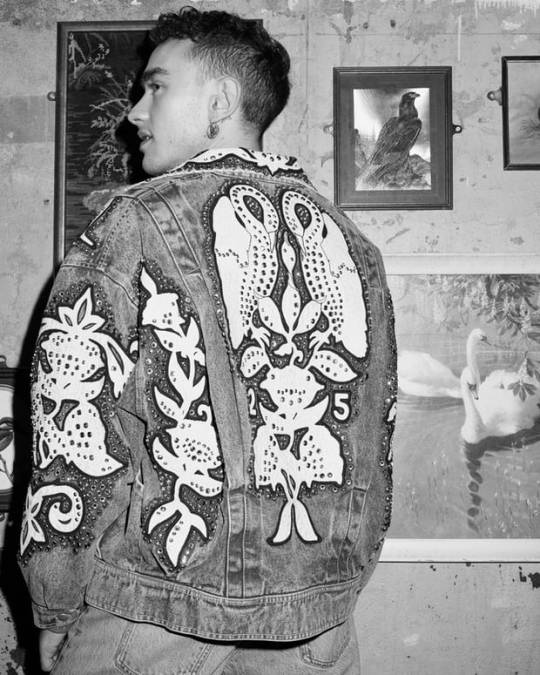
As Alexander eats, he talks about what happened in the aftermath of that famous Glastonbury performance, once he was out of public sight. The band had been cheered off, a career high. And once backstage, the musician recalls, he sat down and wept. Inconsolable, feeling lower than he’d been in months. “It happens,” he shrugs. “A falling off a cliff. The pendulum swings.”
“When I was younger,” Alexander says, “I thought that if you were famous and successful, it would mean that you just felt happy all the time. That you would become, like, this mystical creature that people just adored. And so you would adore yourself.”
Alexander doesn’t always make eye contact, and he addresses this next bit at the napkin dispenser between us.
“Obviously I realise how ridiculous that sounds. But it wasn’t until our album got to No 1 that I realised I still believed in it. We’d basically won the lottery. I felt like I’d won the lottery. And at the same time I still felt like the same person I’d always been. And all the things that I associated with my depression, and my anxiety, those periods of feeling really low, they were still there. And I was so annoyed at myself. ”
Alexander talks about first discovering the transformative, strengthening power of a good costume. It was on a trip to Disneyland, when he was nine. “The greatest experience of my life up to then,” Alexander says. “The pomp! The whole make-believe nature of that place. It was very powerful for me.People were all wearing costumes, playing characters. It was this other reality where fun things happened, more than they seemed to in real life. And I just remember wanting to be a part of something like that.”
Theme parks were a big feature of his young life. Alexander grew up living next door to them, not one but three, first Alton Towers, then Blackpool Pleasure Beach, then Drayton Manor. His father helped launch and market new rides in these places, and the family moved wherever the work was.
He was born in 1990, the younger of two sons. His mother ran community craft groups. His father, while employed in the theme parks, tended side dreams of being a professional musician. Of his father he says, cautiously: “Quite a difficult man... Definitely not happy within himself.”
Alexander is more explicit about his own early troubles. “I used to have hallucinations and hear voices and stuff as a kid. Which sounds alarming, but it’s just the way it was.” Also: “I had what would now be called sleep paralysis, from six years old until maybe I was 16. Terrifying dreams.”
His parents separated when Alexander was 13, a daunting and confusing period for him. “My dad had been very absent, even when he was there. Then he left the family and moved away. Our relationship, it feels to me, ended when I was 13.” With his mother and brother, Alexander relocated to a sleepy village in Gloucestershire called Coleford.
Part of Alexander’s conversational charm is that he’ll veer between the frank and sober discussion of the self-doubt and difficulty he experienced as a young man, into brilliantly catty and droll little anecdotes about his upbringing. Here he is, describing his first paid employment – a Saturday job in a Coleford shop called Moonstones. “We sold incense, candles, spellbooks. Um, bongs. Chocolates shaped like penises. Everything you’d need really – a one-stop shop.”
He wasn’t a popular teenager, and was bullied at his secondary school in Coleford just as he had been at his old primary schools. He marvels, thinking back, at his response to this. “I started wearing eyeliner to school. Nail varnish. Choker necklaces.” He put on a costume: a counter-intuitive form of self-defence. “I’d been bullied for years and all I wanted was for that to stop. But at the same time I had this sense that I was different, I was weird, and wearing makeup and crazy clothes was my way of trying to find an identity, in the face of people who were going to rip me apart anyway.”
What brought him out of his “goth phase”, as he calls it, was the music. Alexander chuckles. “I could never really get on board with the bands you were supposed to like.” He couldn’t shake the love for pop music he’d developed as a pre-teen, when pop bands would visit the theme parks his dad worked for. “Remember [the Irish pop band] B*Witched? They came to open a ride once. Then Steps – I got all their autographs.” So when it was time for the school talent show, Alexander chose to sing a TLC song. At home he obsessed over Christina Aguilera videos. He was pop through and through, and wanted to be a star in the mould of all these heroes.
Half by accident, he embarked on a different artistic career first. At 16, Alexander auditioned for the Channel 4 drama Skins, and was in talks about a role. The job didn’t materialise until he was well into his 20s, when he was cast as a creepy student photographer, but meanwhile his agent put him up for other stuff. By the time he’d finished his A-levels and moved to London, he was getting varied work – in Gaspar Noé’s Enter The Void and Laura Wade’s The Riot Club and a corporate video for Google, playing a confused consumer who didn’t know how much he needed the advice of a really good search engine. Probably his peak as an actor came in 2012 when he was cast in a Michael Grandage production, Peter And Alice, alongside Judi Dench and Ben Whishaw.
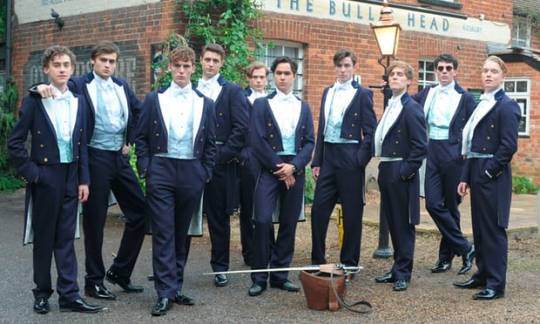
This West End run coincided, in Alexander’s breezy telling, with the busiest period in his romantic career. “Lot of sex.” He had known that he fancied boys from the age of about 10, though the concept of being gay was something only introduced to him via playground insult; he can remember drawing stick figures in a geography textbook, bewildered, trying to figure out how two men could ever even manage it. These days, Alexander says, “my sexuality is part of my music, part of my identity”, but this was a clunky journey in its early phases and it wasn’t until he arrived in London and got into a first relationship, with the brother of a friend, that he felt he could properly come out to those closest to him.
After that – whoosh. “I figured out that I could pull, basically. It wasn’t as hard as I thought it was going to be. I realised that, actually, everyone’s pretty horny, pretty desperate at times, and all you needed to do was maintain eye contact and be confident and that was kind of it.” Since then, he’s sampled romance in many of its forms, being single and shagging a lot, being single and not shagging so much, being in an open relationship, being in a celebrity relationship (with Clean Bandit’s Neil Amin-Smith), being in a quieter relationship with somebody unknown – that was the most recent, and it came to an end about 18 months ago. What has he learned? “That the longer you’re single, the more you notice how everyone else is in a relationship. But that’s a whole other thing.”
He says he finds it harder to pull in clubs without the freedom of anonymity he used to enjoy. “I’m having much less sex than I did in my early 20s, for sure.” He’s tried the hook-up app Grindr, but the men he messaged with wouldn’t believe he was who he said he was. “So that didn’t go very well.” After years of living with flatmates, he recently moved to live on his own, in a flat in east London. “The last few months I’ve been wondering, ‘Will I just be alone, for ever? And would I be OK with that?’ I want to be OK with that.”

Thinking of how ill-informed he felt as a kid, and of the anxiety he might have been spared had he only known more and known better, Alexander has resolved to be a public figure who is as vocal and open about his sexuality as he can be. As soon as he was asked, in an early-career interview for a blog, he said he was gay. (This was actually how his beloved grandmother found out: Alexander hadn’t yet got around to telling her.) Last year, he made a BBC Three documentary, Growing Up Gay, that is still on iPlayer and gets broadcast around the world. “I get messages about it at weird times of night.”
Soon after our lunch, he’s due to give the keynote address at an annual Stonewall event. He hasn’t written his speech yet, and is still toying with points of view he might want to get across: that LGBT-inclusive sex education should be compulsory in schools; that LGBT support groups need more government funding than ever; “that yes, we can get married now, but that’s not the end of the story, that’s not gay rights done.” When the event does take place, Alexander will speak about how, as a young actor who went through media training, he was told it might be best not to speak about his sexuality at all. (“I ignored advice.”)
Alexander made an interesting choice, in 2013, when major labels started showing an interest in Years & Years. He entered therapy, specifically in anticipation of what a frontline music career might do to his fragile emotional state. Polydor were still six months from formally signing them.
He knew fame was coming, though – that early?
No, he says. But if there was a chance of the band making it, however slight, he reasoned he’d better be prepared. “And I’m grateful I made that decision. I’ve been seeing the same therapist through the whole process.” Through the band’s kick-starting anointment as the BBC Sound of 2015, then their smash No 1 single King that spring, then their No 1 album Communion that summer. “To go from zero to 100. To have an idea of what success is, your entire life, and then it happens to you. It’s overwhelming. There’s a lot of noise. And people start talking to you differently.”
Which people?
Alexander laughs, frowns – speaks at the napkins again. He starts talking about his dad, with whom Alexander went through an awkward episode after Years & Years topped the charts. By then, father and son had no relationship to speak of, Alexander says. They hadn’t said a word to each other in seven years. “And, um, my dad started tweeting at me.”
A pause. “It’s hard for me to talk about. It’s a hard issue, because it’s tied up with my family, and also his new family. I want to be respectful.”
He doesn’t sound sure whether his father even knew whether what he was doing was public; but anyway, he messaged him over Twitter, in full view of social media. “And it got really, really messy. There were some Years & Years fans who started tweeting him back, trolling my dad. He was talking back to them. It was a real head-fuck.”
However clumsy the timing and the method, was a part of Alexander gratified that he got in touch?
“The best way I can describe it is that when me and my dad last knew each other, when I was 13 or 14, that’s frozen in time for me,” he says. And back then, he continues, he couldn’t have imagined any better future for himself than becoming a pop star and having his father want to be a part of his life again. “But then he did get in contact with me. And it was then I realised that what that 13-year-old wanted, that wasn’t actually possible. Not any more.”
What did the 13-year-old want?
“I realised that a part of me wanted to be successful in music because my dad wanted to be a musician. That a part of me thought, if I became a musician and I did well, he’d be proud of me. Or he’d, y’know, be so sorry for not being the dad I wanted him to be.”
But that’s not how it felt?
No, he says. When they did come together, Alexander noticed that, “I’d become something that my dad was sort of intimidated by. I’d been wanting to be successful, in part, because I wanted to prove something to him. And when that happened, I realised it didn’t feel good, it just felt like… like I’d tricked somebody.”
Listening to demos from Years & Years’ new album, there’s a sense that fatherhood has been much on Alexander’s mind in the aftermath of this episode. Person-to-person, the musician says, he and his father “have very, very minimal contact” right now. But a dad figure stalks the new work. On one song, Alexander sings about breaking with his DNA. On another, it’s as if karmic retribution is being summoned and directed at a “daddy [who] said I never could win”.

Yeah, he says, his father was foremost in his thoughts when he wrote that one. But he’d been thinking, too, about past relationships, those various boyfriends he’d dumped or been dumped by. Alexander sees a clear thread running through it all, from parental to romantic difficulties. “I guess at its heart it’s just not really being able to trust someone who says they love you. If that’s something that’s ingrained in you, then I think it’s hard to get past that.”
We’re finished with lunch. Having travelled deeper into his psyche than he expected to – “normally I would have these mental conversations alone with myself, in my flat” – Alexander starts to wonder about another cigarette, and pats the pockets of his dungarees. I tell him that, yeah, I can see why he might choose to wear clothes that feel like they hug. He smiles.
Before we stand up and gather our things, he asks to add a couple of “bookends” to what’s been discussed. That he experienced a lot of love and support, growing up, from his mother and grandmother. (“I feel I have to say that: My mother loved me! She tried her best!”) And also that he’s profoundly grateful to music, to his band and their followers, to the rainbow smocks and lace bodysuits and the whole pop palaver, for the release-valve it has offered a troubled mind.
“There’s a lot of quite raw emotion inside me,” Alexander tells me. “Obviously. And most of the time it can only come out in these tiny little cracks. One of those cracks – that’s the music.”
#this is such an amazing read#i cried#i love him so much#btw i didn't know he smokes#olly alexander#a human rainbow
13 notes
·
View notes
Photo

Robert Forster Interview — February 2003
Sunday Interview! Hey, I’m going to start re-posting some of these old interviews I did back in the day — many aren’t really readily available.Why the hell not! First up, there’s this one I did for Junkmedia with Robert Forster on the eve of Bright Yellow Bright Orange’s release. I remember that the connection between Boston and Australia was not particularly great, but the interview came out OK! Also, Go-Betweens bassist Robert Vickers was the publicist who hooked us up. That was cool. Also, I think I heavily overrated Bright Yellow Bright Orange. It’s good, but I think I’d rate it as the weakest of the Go-Betweens’ reunion records.
Some things just get better with age. Take the Go-Betweens for example. The band's latest record, Bright Yellow Bright Orange (released last week on Jetset Records), reveals that songwriting prowess of Grant McLennan and Robert Forster remains undimmed, more than two decades after the band made its first tentative recordings. The new album doesn't even remotely sound like the work of a band in its twilight years; rather, it's a potent, ambitious collection of ten shimmering pop gems.
After their somewhat disappointing "reunion" record (2000's The Friends of Rachel Worth, recorded with members of Sleater Kinney and Quasi), the songwriters' collective muse has returned, and the result is some of their best songs in years. The original lineup of the Go-Betweens made some of the finest music of the '80s; on Bright Yellow Bright Orange, Forster and McLennan seem determined to top themselves. A hell of a challenge, to be sure, but they just might be up to it. Forster spoke with Junkmedia from his home in Australia on the eve of the album's release.
So if my calculations are correct, 2003 marks the 25th anniversary of the Go-Betweens. How does it feel to have made it this far?
God, I hadn't really thought of that, but 25 years — uh, good! It feels good. We're especially happy to still be making relevant music.
It being your anniversary and all, have you and Grant gotten each other gifts or anything? What's the 25th anniversary gift supposed to be — silver?
Well, I'm not expecting any gift. I hope Grant isn't! So, no, I don't think so.
How did the two of you meet?
We were studying at the same place, the same university. This would have been in the mid-'70s. We were sort of living off of "Queen and Country", living on campus. And we just became friends.
I'm curious to know what kind of records were making their way down under at that time.
Well that was just around the time when punk was starting up, so we were getting some of the early punk stuff. Also, Dylan's Desire album was a big one, and the first Jonathan Richman and The Modern Lovers record was issued — that sort of thing was making it down here. And we obviously listened to a lot of '60s stuff — the Velvet Underground, and so forth. A lot of the New York bands of that era were a big influence. Television's first album, the Ramones' first album, I remember quite well. All of that was what Grant and I were listening to in those days.
Was there any one record that really made you think "I want to make something like this!"?
Well, I guess it'd have to be Marquee Moon by Television. That was a real landmark there. It seems like you'd have to spend 20 years studying that to get to where they were on that record. And that record led us to a lot of things -- to the Velvets, to Dylan, to a whole different range of music, really.
How would you characterize your relationship with Grant, in terms of personal dynamics, in terms of songwriting?
Well, it's a friendship. A lot of times, people who work closely in bands aren't friends, but with us that's never been the case. So we've got that going for us. And you know, we're quite similar — a similar age, similar background and all of that. And even though our lives have sort of developed in different ways since we met, we always have a base from which to build off of. So we're similar, but different.
Correct me if I'm wrong, but it always seems to me that — unlike other famous songwriting partnerships — yours is a partnership that's fueled more by mutual respect than by competition. Do you think that's accurate?
Yeah, that's a good point. I do think it's accurate. And the songwriting arrangement we had right at the start has really served us well. Since the second album, we've each had the same amount of songs on each album, and I think that eliminates a lot of problems that other duos might have. And so with that arrangement in place, we're both just trying to make the best records and songs possible. I mean, there is certainly competition to some degree — that's healthy. We're both trying to get the best out of each other, I think.
Listening to your records, however uncompromised they might be, it still sounds like you and Grant, unlike a lot of "cult" bands, were trying to write hit songs. Do you think that's true?
Yeah, I think what we're doing did have and does still have broad appeal. I think of a band like, say, Sonic Youth — they're not really going for any kind of broad appeal, even though a great number of people like them. They're sort of designed to have a cult kind of appeal. But we've always worked within the boundaries of the three-minute or five-minute pop song. A lot of what we do has the possibility of broad appeal. And also, you know, we love pop music. We were brought up on AM radio. We're both AM radio kids.
When the Go-Betweens are brought up in the music press, the adjective "influential" is always coming up. Do you find that to to be accurate — do you ever hear a new band and think, "That really sounds like us!"?
No, to be honest. Not really. I think if we were influential in any way, it was more the way we sort of carried ourselves, and the kind of people we are. And the strange twists and turns of our career might have been influential in some way as well. The music? Maybe a little bit, but I don't hear it in a big way. And I try as much as I can to keep up with the current music scene.
The two of you spent the '90s pursuing other projects — recording solo albums, playing with other bands, and writing with other collaborators. Was that time apart valuable to you as a songwriter?
Oh, enormously. Enormously. For the both of us. I think that's the reason things are happening right now with the Go-Betweens, why we're hungry. We had a break from each other, which was great — and we also got to work with other people. I learned to play the keyboards, which was something I didn't have time for the first time around. And I made a couple albums collaborating with different people. I made one with Edwyn Collins producing called Warm Nights and a covers record called New York Girlfriend. I learned a lot about studios, and all kinds of things, and that was all very valuable.
And that brings us a little more up to date, with Bright Yellow Bright Orange. Grant said in the press materials that this is his favorite Go-Betweens album. I thought that was a pretty bold claim to make at first, but, having listened to it quite a bit in the last few weeks, I'm almost inclined to agree. What do you think?
Well, it's hard to say, really. I like it, and it's getting a really good reaction so far, but, when you start talking about favorites, it's hard to single one out. There are some earlier records that I have great affection for. But Bright Yellow Bright Orange is up there, to be sure.
Is there any one Go-Betweens record that really sums it up for you, where you think you accomplished exactly what you set out to do with it?
Hmmm. Before Hollywood is good. But I still think we're sort of striving for that perfect record — I suppose if we had already made that perfect record, there'd be no reason to go on!
Tell me a little about the band you've got playing with you on Bright Yellow.
Well, we've got Adele Pickvance playing bass and Glen Thompson playing drums and keyboards. Glen played on my second solo album. I met him through some other people and he ended up playing on Warm Nights, and when I was touring behind that record I hooked up with Adele. But it took a while to get that combination together with Grant to do a real Go-Betweens record.
Where was it recorded?
Some of it was in Melbourne, a great studio down in Melbourne called Sing Sing, and some of it was done in Sydney, at Paradise Studios.
Does location play a big part in the "vibe" of an album?
Totally. Totally. Place has always been extremely important in all of our recordings. For us, it's like going on location for a film, really. You know, like if you were in Miami, you can't make a Western down there. And if you want to make, say, a sparkling situation comedy, you can't do that in the backwoods of Tennessee. So where we end up recording — it's all been thought through, we've discussed what the best environment would be for that particular record.
Now, in addition to this new material you've got coming out, Jetset and Circus Records put out your first three records, with bonus discs of unreleased and rare material. Were you involved in that? Was it fun for you to go back and listen to those records?
That was done by the record company, and they put the whole package together, and Grant and I for the most part gave our approval. We removed one or two things we weren't excited about. But I do enjoy listening to those records from time to time, although lately I've been getting back to some of my solo career. That stuff is starting to grow on me a bit.
Are there plans to give the remaining Go-Betweens records a similar treatment?
Yeah, there are plans. That'll probably happen next year. We'll do the rest with bonus material and all of that. There's even a record of early bonus material that didn't make it on to the first set of reissues that'll see the light of day sooner or later. It's kind of "the rarities of the rarities."
The Go-Betweens have always enjoyed a particularly fierce fan base. It might even be bigger now than it was in the '80s. Does it surprise that you after all these years you've still got fans all over the world following the band?
Well, honestly, not entirely. We made good music, and we're hopefully still making good music. And no matter how "popular" something is, if it's good, it's going to have a life, you know?
7 notes
·
View notes
Text
2019 WRAPPED: a few contributors’ (and my) records of the year
in order of release, here are some of our contributors’ albums of the year, alongside my extremely extensive list of my favorite LPs released in the past 365 days.
1. january 18, heard it in a past life by maggie rogers
this album, without a doubt, shaped this entire year for me, but whenever i’m asked to explain how, or why, i get choked up. at the time of its release, i was in such a strange place mentally that i couldn’t listen to “light on” - one of the most popular songs on the album - without sobbing uncontrollably, even if that meant excusing myself to cry in the restroom when it came on at work. i am so grateful to have had hiiapl to grow with this year. maggie rogers is one of the most influential artists in the world right now, and i know this album is a lot of people’s record of the year. recommendations: light on, burning, on + off, the knife
2. january 25, amo by bring me the horizon
the return of british metalcore band bring me the horizon was such a heavily anticipated one, given the fact that their last LP release was in 2015, but i don’t think anyone could have expected the record they were going to release, or how different it would be from anything they’d ever made. bring me the horizon made a really impressive leap into something of an unknown; there has been, both unfortunately and understandably, some backlash regarding exactly what genres the band had decided to experiment with and whether they’d lost their roots in deathcore. but they’ve promised that despite this jump, they’ll still be as rowdy as ever in their live shows. amo is one of my favorite records of the year because of its genre-bending, and because of its desperation and emotion. it’s turned bring me the horizon from a band i never really cared for into one i now seek out when i’m thinking of what to listen to on drives. recommendations: mantra, in the dark, sugar honey ice + tea, mother tongue
3. february 1, midnight by set it off
my favorite record of 2019 is midnight by set it off. not only did the band completely reinvent their aesthetic, they also showcase a more mature and cohesive sound. cody (the lead singer) is a classically trained clarinetist and I think his knowledge of music really shows on this record. each song has little surprises here and there, and shows the work of musicians who understand rhythm and texture. there’s a little something for everyone, from the angsty undertones of “killer in the mirror” and “dancing with the devil,” to the raw, beautiful emotion of the ballad “unopened windows.” hands down best record of 2019! -gabriela (twitter || instagram)
4. march 1, wasteland, baby! by hozier
I wish I could do my dissertation on the various ways Wasteland, Baby! is a masterpiece but unfortunately I'm in a museum studies program and I don't think my professors would accept that proposal. Hozier was somehow able to fit every emotion a human being is capable of feeling in a mere 57 minutes (and 21 seconds of course) and, by the end, has made the listener feel warm and hopeful despite a large theme being, y'know, the literal ending of everything. Don't even get me started on his referencing and imagery we could be here FOREVER talking about Shrike alone! Even Spotify was like "Hey this is literally all you listened to this year, you good?". Hozier and Wasteland, Baby! have been through one of the toughest years of my life with me - including the transition into a new country - and they will forever have a place in my heart. -alissa (instagram)
5. march 22, mystic truth by bad suns
up until this year - and this release - bad suns were always a background artist in my life. i’ve been listening to them since they first released “cardiac arrest” and it was a single of the week on itunes, but only casually. this was, however, the year i saw them live, on their mystic truth tour in late spring. recommendations: away we go, the world and i, love by mistake
6. march 29, you are ok by the maine
the maine are the most dramatic band in the world, and i love them to death for it. after staging a funeral for their 2017 release, lovely little lonely, in october 2018 to signify their departure from social media, they spent nearly six months in silence to write and record before releasing their seventh record, you are ok, this past march. this record makes me more - for lack of a better word - emo than any of their previous work, in spite and as a consequence of its blatant deviation from the loneliness of anything they’ve released pretty much since black & white. you are ok is, from its very first breath, evolved. recommendations: slip the noose, my best habit, tears won’t cry (shinju), heaven we’re already here
7. march 29, when we all fall asleep, where do we go? by billie eilish
the debut full-length from music prodigy billie eilish was long-awaited by dedicated fans and the general public alike, and when it finally dropped in march of this year, not a single person on this planet was disappointed (probably a hyperbole and consequently bad journalism, but who cares, i never claimed to tell the whole entire truth). when we all fall asleep is a genre-defying masterpiece; the tracks don’t feel as if they should be played on the radio, but because of eilish’s more mainstream previous releases, she’d essentially earned a permanent slot in most popular stations’ rotations. i also had the privilege of watching her play to one of the biggest crowds that reading festival’s main stage had ever seen, and she blew myself (and everyone else there) away. recommendations: xanny, all the good girls go to hell, when the party’s over, my strange addiction, bury a friend
9. april 26, the balance by catfish and the bottlemen
despite criticisms that they’ve been making the same album for five years, i genuinely believe that with every new release, catfish and the bottlemen produce more emotionally coherent and intelligent music. i finally got to see them this year, on their tour supporting the balance, too, after years of casual listening. the balance turned me into a ravenous catfish fan; i spent two months after the show devouring all of the content surrounding them i could find, listening to all three of their albums on repeat, and crying endlessly over how beautiful van mccann is. this album absolutely defined the back half of my 2019, and i’m always shocked to learn that there are people who don’t love it as fiercely as i do. i have such an overflowing fountain of feelings about this album that i’m still not entirely sure how to write about, but all i have to say is that, if you haven’t yet, please please please give this album a spin. recommendations: fluctuate, conversation, intermission, overlap
10. may 24, future dust by the amazons
the amazons are the best band i discovered this year, hands down. according to my spotify year in review, i listened to over 9 hours of their music since seeing them at reading in august (not including all the times i spun this record on vinyl in that time as well). future dust is a masterpiece; there is not one bad track; every time i listen to it, it gets better. they’ve got rock and roll on lock. no one else has come close since maybe the arctic monkeys, but the amazons have brought it back. i’m having a hard time stringing together words about the way this record makes me feel, but i hope that you’ll see this, listen to it top to bottom six or seven times, and make your own feelings about it. recommendations: mother, fuzzy tree, black magic, 25, doubt
11. june 14, doom days by bastille
i will probably forever hate myself for falling out of love with bastille after i graduated high school. i’m not entirely sure what happened (actually, i am - i was shoved too far up the maine’s ass to care about anything else) but i know that i loved them more than anything when i was a teenager, and the doom days album cycle - specifically their reading set - reignited that love, so i’ll be forever grateful to it for that. this album is conceptual and amazing, set over the course of one night when the writer - presumably frontman dan smith, whose brain this came out of - attends a party with his friends in an attempt at escapism. the world is fucked - dan’s words, but also mine - and sometimes we really do just need to pull the wool over our own eyes for once and let loose, even if just for a night. it starts at a “quarter past midnight,” when the night has only just begun, endless possibilities stretched out ahead of him, and finishes with “joy,” about waking up on the kitchen floor, your phone going off in your hand, the only person who really matters in your life on the other end of the line. bastille have always released music that makes it clear that they give a fuck what happens to earth and her people, and with doom days, they’ve perfected that sound. recommendations: quarter past midnight, divide, million pieces, joy
12. august 23, GINGER by brockhampton
after a brief hiatus, my favourite all-american boyband returned with their fifth studio album, GINGER. with a noticeably matured and somewhat mellowed shift within the hip-hop collective, this record explores themes of grief and disconnection to the backdrop of upbeat melodies such as on "boy bye" and sweet love songs such as on "sugar". though perhaps my favourite sentiment on this record lies within the fact that it opens with the echoed words, "I don't know where I'm going," and closes poignantly with the heartfelt statement, "Thank God that I'm built for the distance." -katy (twitter | instagram)
13. september 13, hypersonic missiles by sam fender
hypersonic missiles, the debut full-length from geordie singer-songwriter-maestro sam fender, was my most anticipated release this year. fender has faced a mess of obstacles this year, mostly health-related, after winning the BRIT awards’ critics’ choice award at the start of it, and as a result has had to cancel a majority of the shows he’d had schedules and push back the release of hypersonic missiles a whole month. it was well worth the wait, though, and i ended up writing an essay-length review of it for highlight magazine when i finally did get to hear it. filled to the brim with emotional ballads and belters alike, hypersonic missiles is a culmination of over five years of songwriting and even longer of sam being fed up - with his government, with his peers, with the misrepresentation of mental health by the media. we’ve only had this record for three months, but i can already tell it’s timeless. i’m only hoping sam’s voice recovers enough that he can continue to tour to promote it before returning to studio (reportedly the electric lady in new york city!) to record his second release. recommendations: hypersonic missiles, white privilege, you’re not the only one, will we talk?, two people
14. september 13, pride & disaster by sleep on it
my favorite record of the year is undoubtedly ‘Pride & Disaster’ by Sleep On It. Pride & Disaster arrived the perfect time for me, as I just transferred out of college. I felt lost and unsure of my future. However, listening to Pride & Disaster gave me a sense of hope and support that I’ll be okay on my new journey. -julie (twitter)
15. october 4, interrobang by bayside
Just like the title, there's no single form of punctuation that can explain the brilliance of this album. 'Interrobang' takes the classic Bayside sound to a new level with heavier riffs, faster time signatures, and iconic lyrics. From "Heaven," a stand out anthem for aging punks in the scene to "Bury Me," a melodic metal inspired breakout track, this album is laced together perfectly with both the past and future of Bayside. By tip toeing the line between metal, alt rock, and pop punk, the band has shown that even after almost twenty years as a band, they can still innovate and transform with new music. -katie (twitter | instagram)
16. december 13, fine line by harry styles
i wanted to include this in this roundup, considering i haven’t stopped listening to it since it came out (and i saw him live!), but i did also write an entire review of the album. you can read it here!
honorable mentions (aka albums i didn’t feel like writing an essay about - or just didn’t listen to all that much - but still think you should give a chance)
1. swmrs, berkeley’s on fire (february 15, 2019) 2. circa waves, what’s it like over there? (april 4, 2019 - i wrote a whole review about this record for highlight and not many of my feelings about it have changed since then.) 3. cage the elephant, social cues (april 19, 2019) 4. ten tonnes, ten tonnes (may 3, 2019) 5. palace, life after (july 12, 2019) 6. clairo, immunity (august 2, 2019) 7. the myserines, take control ep (august 8, 2019) 8. muna, saves the day (september 6, 2019) 9. from indian lakes, dimly lit (october 18, 2019)
#albums of the year#records of the year#maggie rogers#bring me the horizon#bmth#set it off#hozier#bad suns#the maine#billie eilish#circa waves#cage the elephant#catfish and the bottlemen#the amazons#bastille#brockhampton#sam fender#bayside#from indian lakes#harry styles#palace#ten tonnes#the mysterines
0 notes
Photo
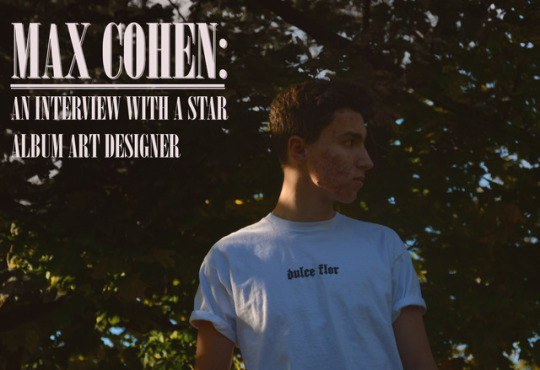
It is almost unimaginable how many musicians have been given a listen due to their album artwork. Being the first impression itself, the artwork obviously holds the same weight as the music in many cases. Back in the days of record stores, there was no 10-second preview; the artwork was all there was between the consumer and the artist. Though, it is now a digital age in which attention is the most valuable commodity, in which standing out is just as difficult as ever. Some believe that the artistry of an album has been lost and in a sense it is arguable that the lack of physicality within the medium has hindered the appreciation of the art form. But many on the other side of the scale believe that is completely wrong in every sense, many being the graphic designers themselves; one of which is pushing to retain the art form he built his base on.
Max Cohen is a Waterloo, Ontario born and raised creative director and designer who has established himself a major player in the hip hop scene; creating artwork for some of the hottest acts currently, which include: Killy, Pierre Bourne, Murda Beatz, Smokepurpp and of course many more. Max understands the importance of branding as well as the visuals themselves, hoping to share it with those unaware of its essentialness. Parmaind sat down and spoke to Max about his work and visions, the rap industry as well as his views on the future of music marketing.

Paramind: First question as always, how’s your day going?
Max: Good man, it was ok; school was school. I’m living bro, living good.
PM: So, why don’t you tell everyone who Max is?
M: Oh god, my name is Max Cohen; I am a student, I am an artist, I make album covers and work on branding for a bunch of different artists and labels, just an overall creative.
PM: So of all those projects you’ve done, what are the three you’re most proud of?
M: Oh, Killamonjaro for Killy, Bloody Hands…this is tough… oh the Fiji and Yachty one for sure.
PM: It is seen in those projects that you work tightly in the hip hop community, but do you think that’s where you’re happy staying? Or would you want to expand and if so, where?
M: I mean I love all genres of music so I’ll do anyone I listen to and primarily listen to the people I work with. It’s nice to have that personal connection with the artists. But in general with rap its probably where I’ll stay, it’s what’s popular and what I enjoy the most; it’s the black renaissance coming into play and that will be prevalent as time goes on. Also I work more on an industry level than a Soundcloud one now as well. I’ve worked with Universal, Interscope, real label shit. It’s my niche and I’m enjoying it and once I continue to expand my range of talents it’ll just get better and I plan to stay prevalent and influential in the industry.
PM: So do you plan to move towards shooting concerts, live visuals, etc. as arguably album artwork is static as an art form?
M: Yeah it can be sometimes, but photography is so saturated right now that it’s hard to stand out at all because thousands of them exist, so there’s no real point. People have asked me to shoot or do video work and my friend who goes by the name Sogross basically just taught me to diversify my skillset and so if an artist wants me to go on tour for a couple months and do all the visuals and creatives I can do that.
PM: But you’re still doing album art, it is still your main focus; and there is now the question of why it’s relevant. Akon recently tweeted making fun of even caring about album artwork anymore...
M: Akon’s on bullshit man
PM: [Laughs] so then why is it relevant then in your mind?
M: It’s the most important thing towards marketing and building your brand and fan base. Off the top, cover art is an art form so it needs to be maintained. But that whole idea of branding is important, it’s like saying ‘why do we need advertisements for companies?’ It makes no sense. That is literally the equivalant. Its part of the marketing, and of course, its part of the vision.
PM: But what about album covers with no art? Like Yeezus?
M: Still art. Still branding. That’s totally art and expression and what the artist wanted to display. It was curated by Joe Perez , dude is so smart. But it’s a message against the music industry.

PM: Kanye called it the coffin or death of album covers, does he have a point?
M: Kanye is a visionary but he’s also dramatic and sometimes stupid so take everything he says with a grain of salt.
PM: While on the topic of album covers, can you tell me some that have influenced you in some way?
M: Anything Bryan Rivera does, he does Post Malone’s stuff, I don’t have specific influence from one piece or it else my art wouldn’t be my own. So maybe not specific covers but more portfolios.
PM: Can you give any secrets or hints at album covers or work you have coming soon?
M: Geez, lot of Toronto work. I don’t like talking on my moves before I make them. No reason to flex a piece before it’s done. I can speak on the fact I’ll keep working with Murda Beatz if all goes good.
PM: Nice, on top of working with musicians you’ve also worked with some other graphic designers like your friend Jeff and I know you’ve been shouted out in Justin Wilson’s interview with Untitled, so can you speak on your connections or your future in terms of collaboration?
M: The community is very tight knit. You have very industry based designers who only fuck with people in their circle and no one else. But that’s some drama LA shit. But in terms of the community, I’m in a lower tier but it’s so tight knit. I’m in group chats of about 40 different designers and creatives in the industry and everyone’s friends. The piece I recently did with Jeff for bloody hands was me just not being able to do the edits because I went out one night so I sent it to him and he got it done no problem.
PM: So what would be the dream for you then? What is the end goal or place you’d be happy ending up at?
M: I mean, I’m not going to university for graphic design; I’m going for creative industries, which is more the business behind everything I’m into. But if I could make graphic design my career I’d be the dream. Vision wise, I will realistically work with Ovo in the next 6-8 months and they’re the biggest Canadian entity and I already have work that’s been viewed millions of times by millions of people, which is unreal. I’m so happy where I am and I just enjoy being in the scene and reaping the benefits of working in music. I want to have a presence and make great work...
In the end, it comes down to the art not the clout.

PM: True, you’ve worked with some big artists such as Pierre Bourne and Killy as well as SmokePurpp. But you have to wonder who those out of reach people are for you that you desperately want to work with.
M: Migos. No doubt. Coach K and Quality Control are tight knit on what they do. But if I can work with them It’d be crazy. And anyone large and I respect. Even like on a lower scale, like Yellow days. That’d be lit. But I try not to be driven by who I’m working with and rather be driven by the quality of the art and how much money I’m making. [laughs]
PM: [laughs] Do you lose your artistic integrity in the pursuit of money or social media numbers?
M: When you work in a service industry, like I do, its not necessary sacrificing artistic integrity and instead doing what the customer wants and doing it the best I can. I will sometimes make a piece I don’t love but that my client will love because that’s what they wanted. So yeah that could be seen as losing integrity. It’s a hobby and I love it but it’s also a job, this is my part time job. Sometimes if someone does something I can’t support I’ll have to turn it down but that’s it
PM: So in those cases is it about them as a person or just not enjoying their music or vision?
M: That’s hard because so many rappers are fucking scumbags. There are so many bad people popular in rap right now, its difficult to find that line lately… actually lets stop that topic [laughs]
PM: [laughs] Yeah best to move on for now… going back to album art and design, how do you feel you’re making yourself stand out and why do you matter?
M: My shit’s hot man, my art’s sick and I can make anything anyone wants. Perfect example is Killamanjaro... Wait hold on let me pull out these texts…
[Max pulls out his phone and finds a conversation with Killy]

M: He gave me the vision of “crazy dystopian dark world art cover, needs to be crazy and memorable” and It was my job to make something sick and something worthwhile. And that’s what I want to keep having is the ability to see something in my head and then execute it to the highest degree, because that’s what makes me worthwhile and unique.
PM: For sure, thanks so much for your time man, anyone you want to shout out?
M: Shout out Liam, shout out Luke, shout out Tuti; Tuti’s my Brazilian homie who I’ve known for like 3 years and has been on this design shit forever. Also; Jeff, Dj, Trap, Zero, Jermane cause he’s putting me on right now, my parents, my sister, oh and my dog.
Paramind would like to thank Max for his time, as well as speaking his mind and giving us insight into his art and future.
Follow Max online:
Twitter: @Mxxchn
Instagram: @Mxxchn
Words and photos by Guy Mizrahi
2 notes
·
View notes